Tom's Hardware Verdict
The Gigabyte RTX 3090 Eagle is basically a base model implementation of the GPU. Its 30 MHz factory overclock doesn't really matter, and for the price, the Founders Edition is the better choice. But if you're jonesing for a 3090 and can find the Gigabyte card in stock, it's still an extremely powerful card, with a price to match.
Pros
- +
Same extreme 3090 performance
- +
Pricing is at the bottom of the 3090 range
- +
Runs reasonably cool and quiet
Cons
- -
Almost no 3090 cards available right now
- -
Pretty generic design, if that matters to you
- -
Doesn't beat the 3090 Founders Edition
Why you can trust Tom's Hardware
Nvidia's RTX 3090 Founders Edition is the fastest graphics card in the world, ranking at the top of our GPU benchmarks hierarchy. It's also the most expensive single-GPU GeForce card Nvidia has ever released, sitting at $1,500 … and yet it's still out of stock everywhere you look. Maybe you need an alternative, or maybe you don't want a graphics card that weighs over 2kg. Either way, the Gigabyte GeForce RTX 3090 Eagle could be just what you're after. It's basically just as fast as the 3090 FE, at the same price, so it's still the best graphics card available — best in this case meaning 'fastest.' We expect the GeForce RTX 3070 and AMD's Big Navi will be more impressive on a performance per dollar level.
As we noted in our Founders Edition review, the RTX 3090 is very much a card designed for professionals and extreme enthusiasts. Typical gamers don't need to pay double the price for a relatively modest boost in performance. If you're running workloads where you need more than the 10GB of VRAM on the GeForce RTX 3080, though, the gap can increase. The 3090 is also the only 30-series GPU with NVLink and SLI support — not that we'd recommend dual-GPUs for gaming, considering Nvidia's new SLI stance. But for machine learning and GPU compute, multi-GPU can still be beneficial. All you need is about 750W of power for the graphics, plus whatever the rest of the system needs, meaning 1500W PSUs wouldn't actually be overkill.
That's perhaps one aspect of the RTX 3090 Founders Edition that's problematic. It's a full triple-slot card, making it difficult to fit more than two cards into most cases. The Gigabyte 3090 Eagle is in the same category, as it's only 1mm thinner. The 3090 Eagle is also 7mm longer, but its height is 10mm less than the 3090 FE. Here are the full specs for the RTX 3090 cards we're looking at.
| Header Cell - Column 0 | RTX 3090 FE | Gigabyte RTX 3090 Eagle |
|---|---|---|
| Architecture | GA102 | GA102 |
| Process Technology | Samsung 8N | Samsung 8N |
| Transistors (Billion) | 28.3 | 28.3 |
| Die size (mm^2) | 628.4 | 628.4 |
| GPCs | 7 | 7 |
| SMs | 82 | 82 |
| GPU Cores | 10496 | 10496 |
| Tensor Cores | 328 | 328 |
| RT Cores | 82 | 82 |
| Boost Clock (MHz) | 1695 | 1725 |
| VRAM Speed (Gbps) | 19.5 | 19.5 |
| VRAM (GB) | 24 | 24 |
| VRAM Bus Width | 384 | 384 |
| ROPs | 112 | 112 |
| TPCs | 41 | 41 |
| TMUs | 328 | 328 |
| GFLOPS FP32 (Boost) | 35581 | 36211 |
| TFLOPS FP16 (Tensor) | 142 (285) | 145 (290) |
| RT TFLOPS | 69.5 | 70.7 |
| Bandwidth (GBps) | 936 | 936 |
| TDP (watts) | 350 | 350 |
| Dimensions (LxHxW mm) | 313x138x57 | 320x128x56 |
| Weight (g) | 2189 | 1384 |
| Price | $1,499 | $1,499 |
Basically, you get the exact same hardware as the Founders Edition, with the only difference being the mild factory overclock on the GPU core and aesthetics. Theoretically, the overclock makes the Gigabyte card about 2% faster, but in practice, the Nvidia Ampere architecture allows for opportunistic boost clocks that benefit from lower temperatures and better cooling. Not surprisingly, a bigger cooler and larger fans mean it will be difficult for many of the AIB cards to match, let alone beat the 3090 Founders Edition.
Gigabyte RTX 3090 Eagle: Design, Cooling, Aesthetics
You can watch our full teardown and video review of the Gigabyte 3090 Eagle above. The basic design is similar to many other recent AIB cards, with a triple fan layout over a large radiator. The Eagle brand is a newer line from Gigabyte, debuting in early 2020 (after initially leaking in late 2019). It appears to take over from the previous WindForce line of GPUs, falling toward the bottom of Gigabyte's lineup in terms of features and extras.
Currently, Gigabyte has five different 3090 models available. The top of the range is the Xtreme series, followed by the Master, then Gaming and Eagle, with the Turbo line still sporting a blower-style cooler. There's very little in the way of bling on the 3090 Eagle — specifically, there are two slashes to the left of the Eagle logo that light up with RGB. Looking at the card, you'd expect the 'Eagle' logo to be backlit as well, but it's not. The slashes (a highly stylized eagle eyeball, apparently) can be configured via Gigabyte's RGB Fusion software. Still, they don't provide much light, and in most cases, they'll end up facing the bottom of your PC. If you're after wild RGB lighting, then this probably isn't the card you're looking for.
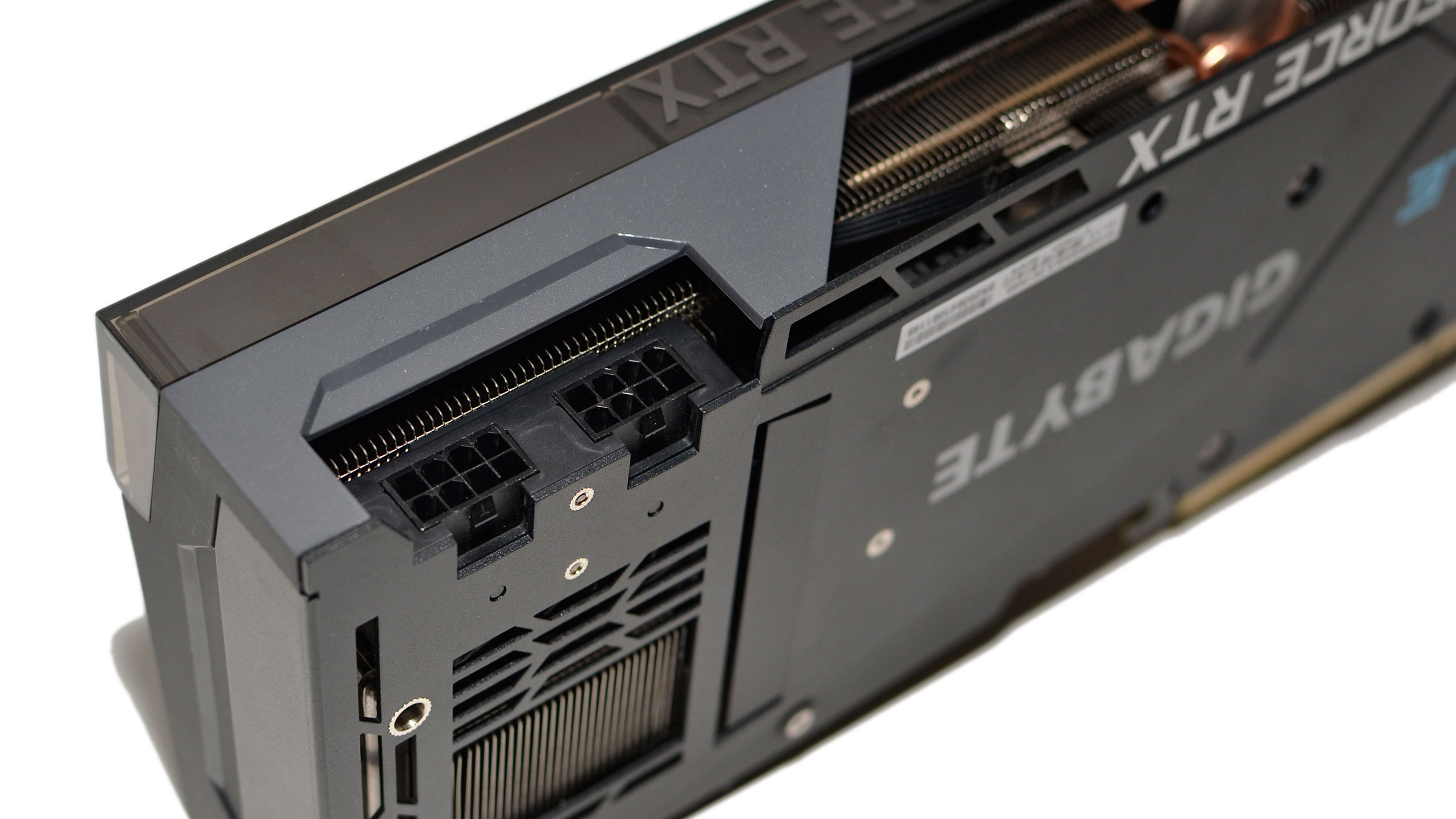
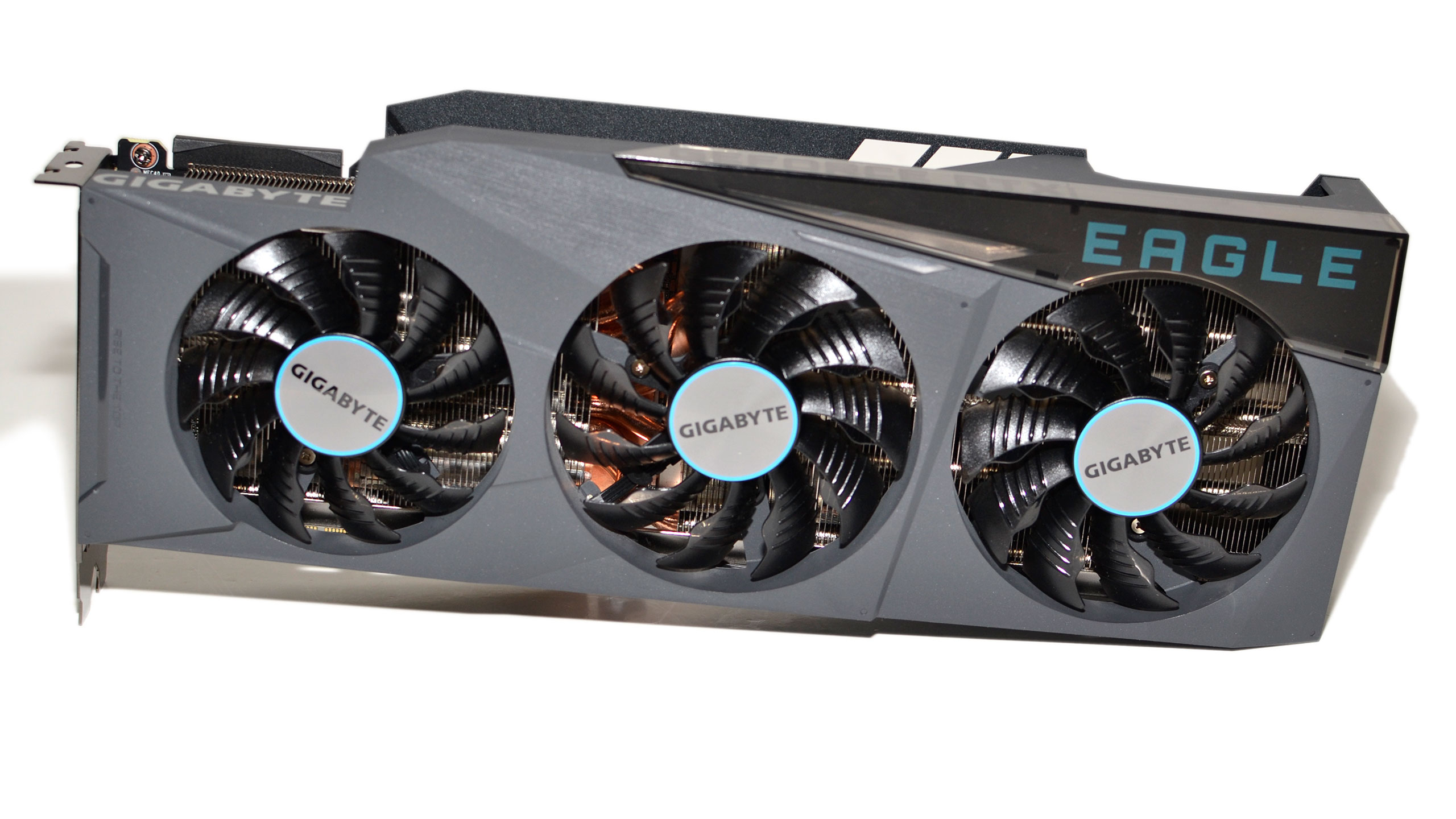
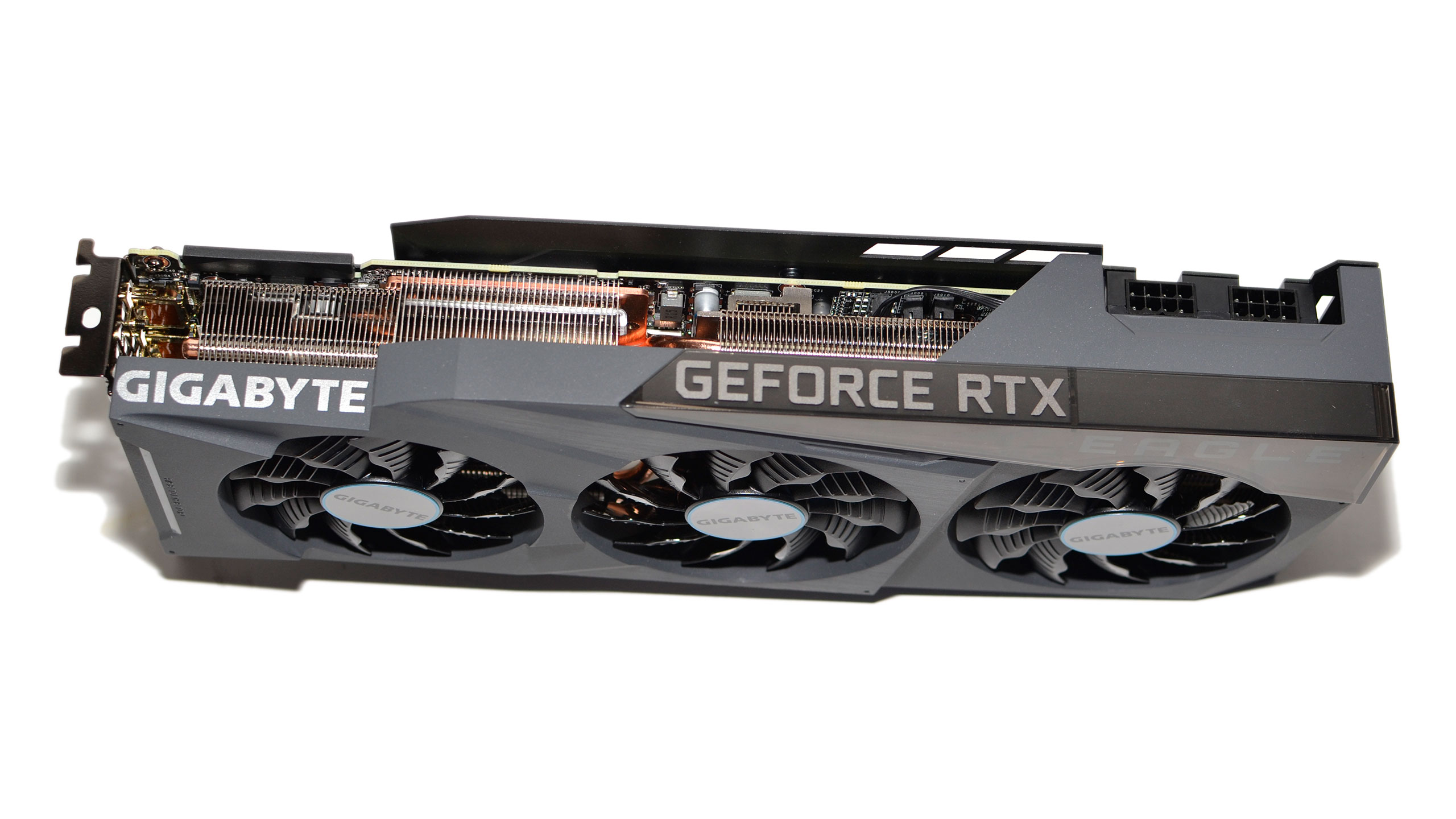
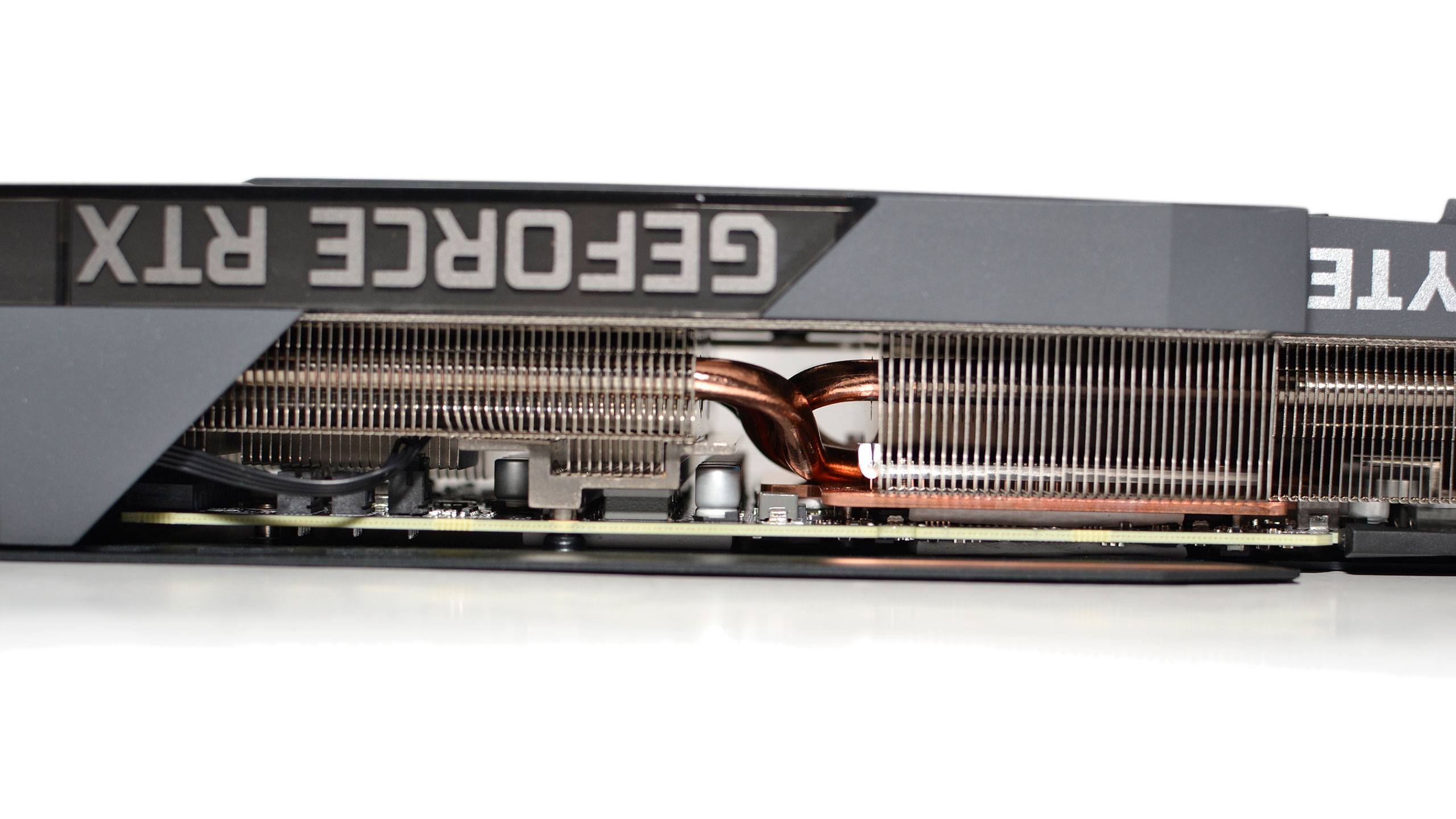
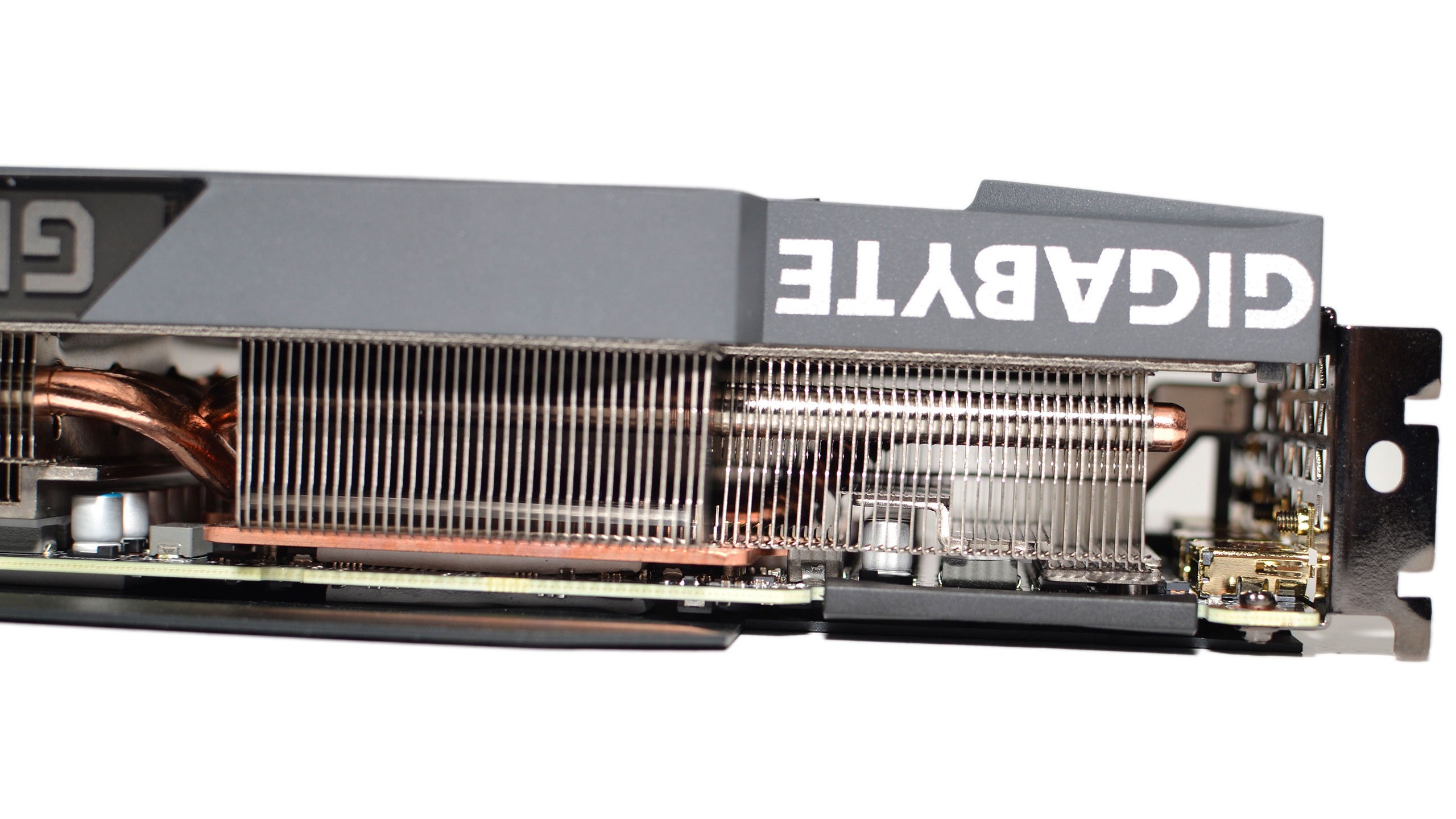
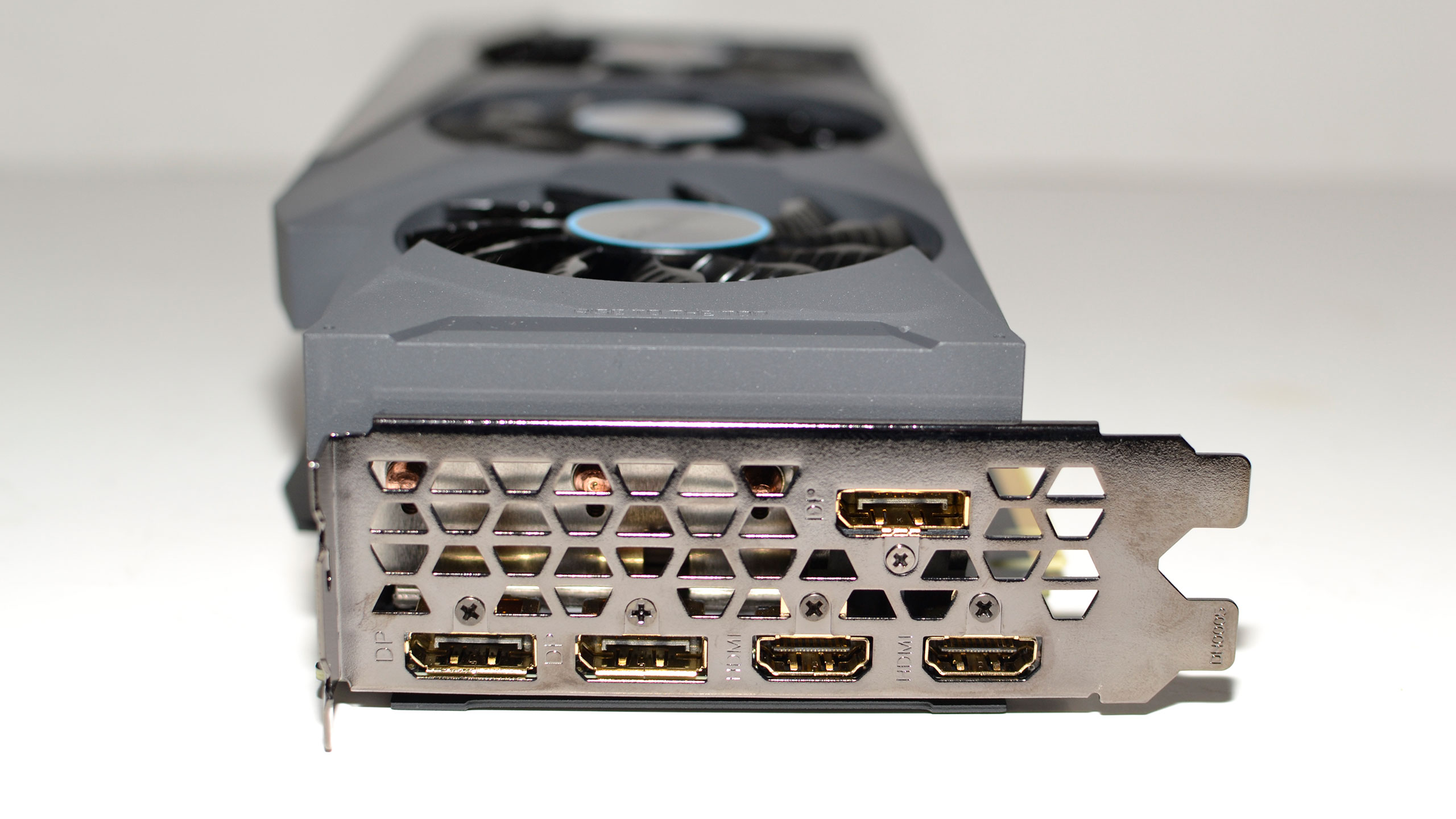
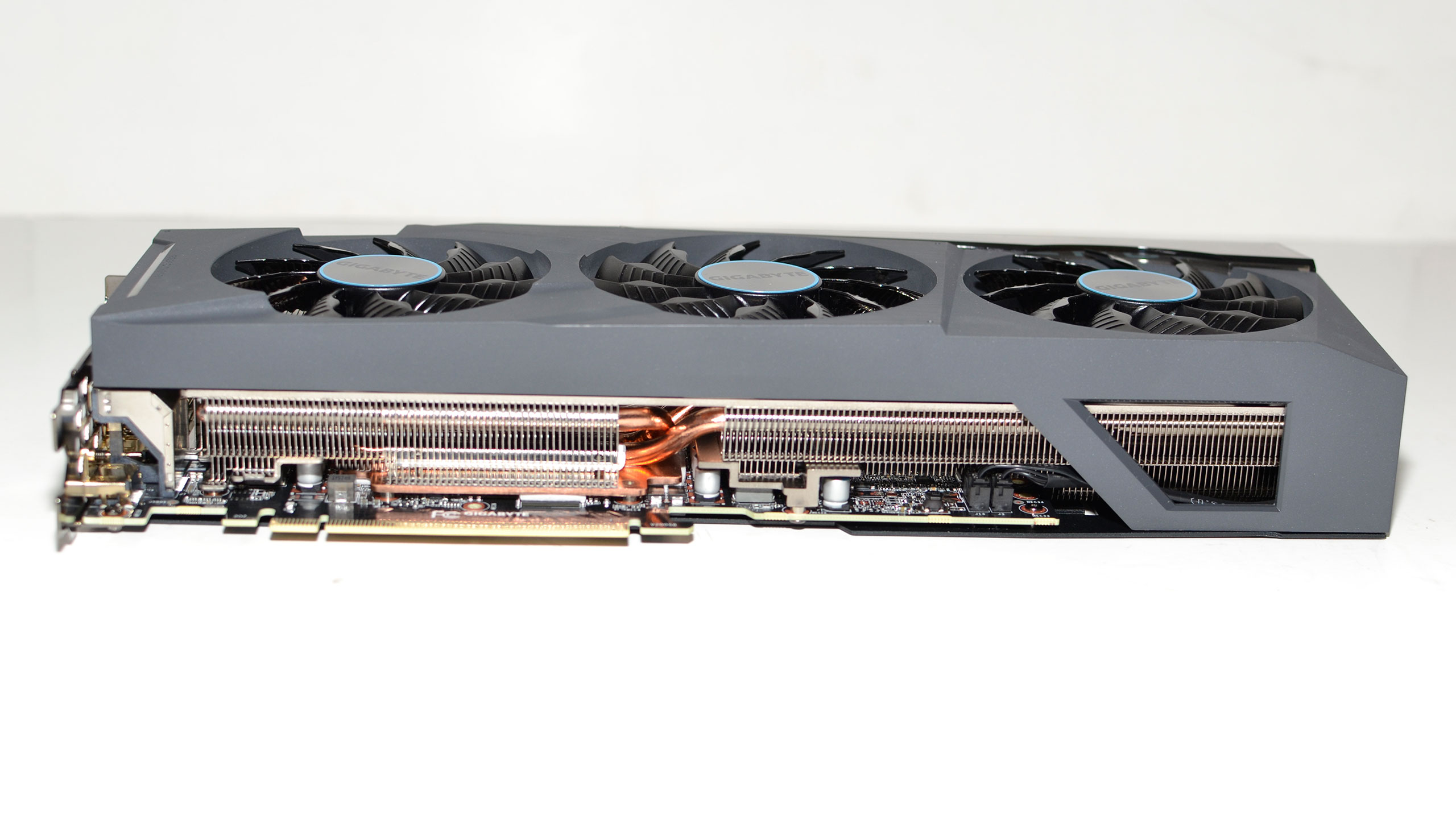
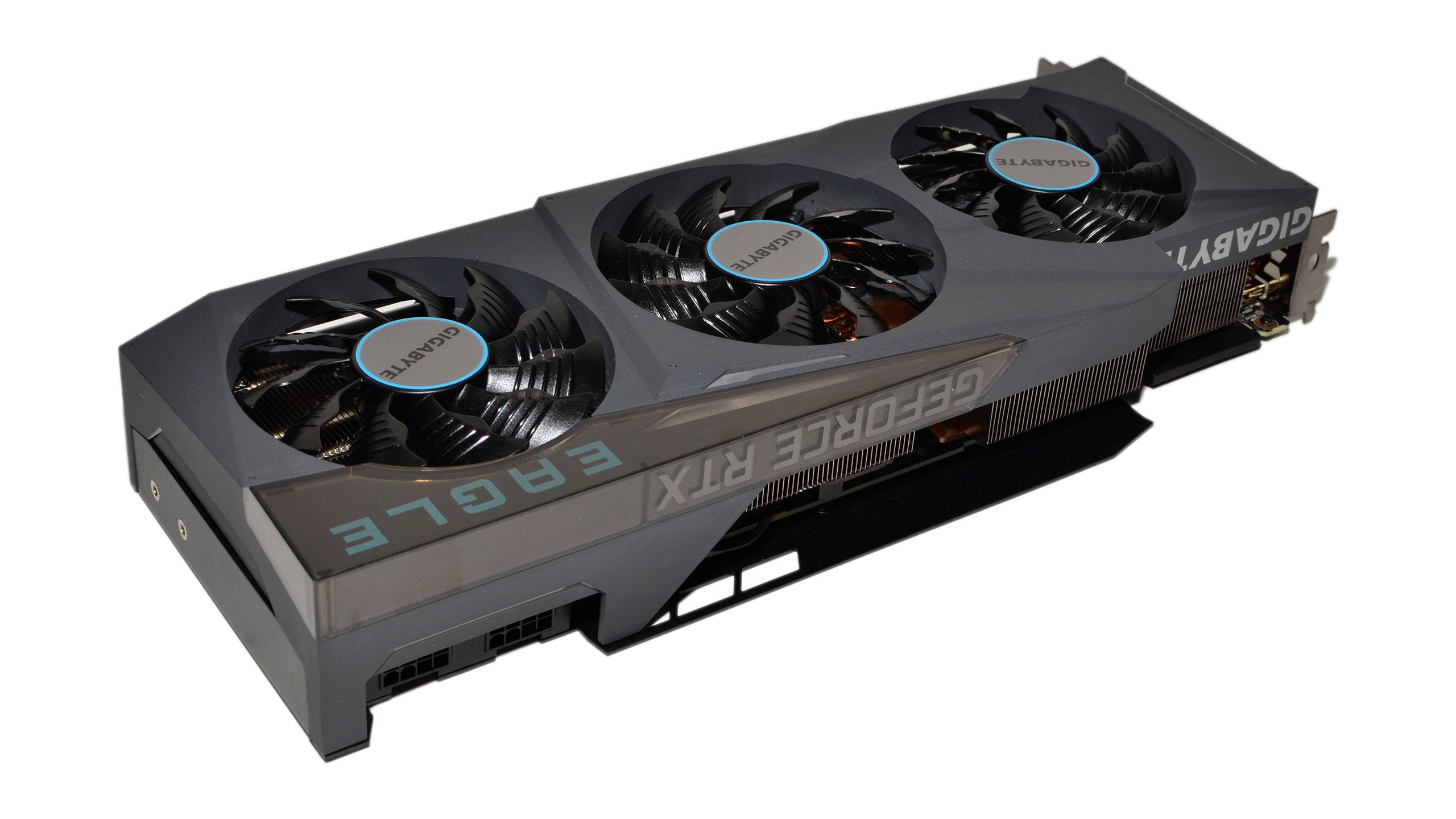
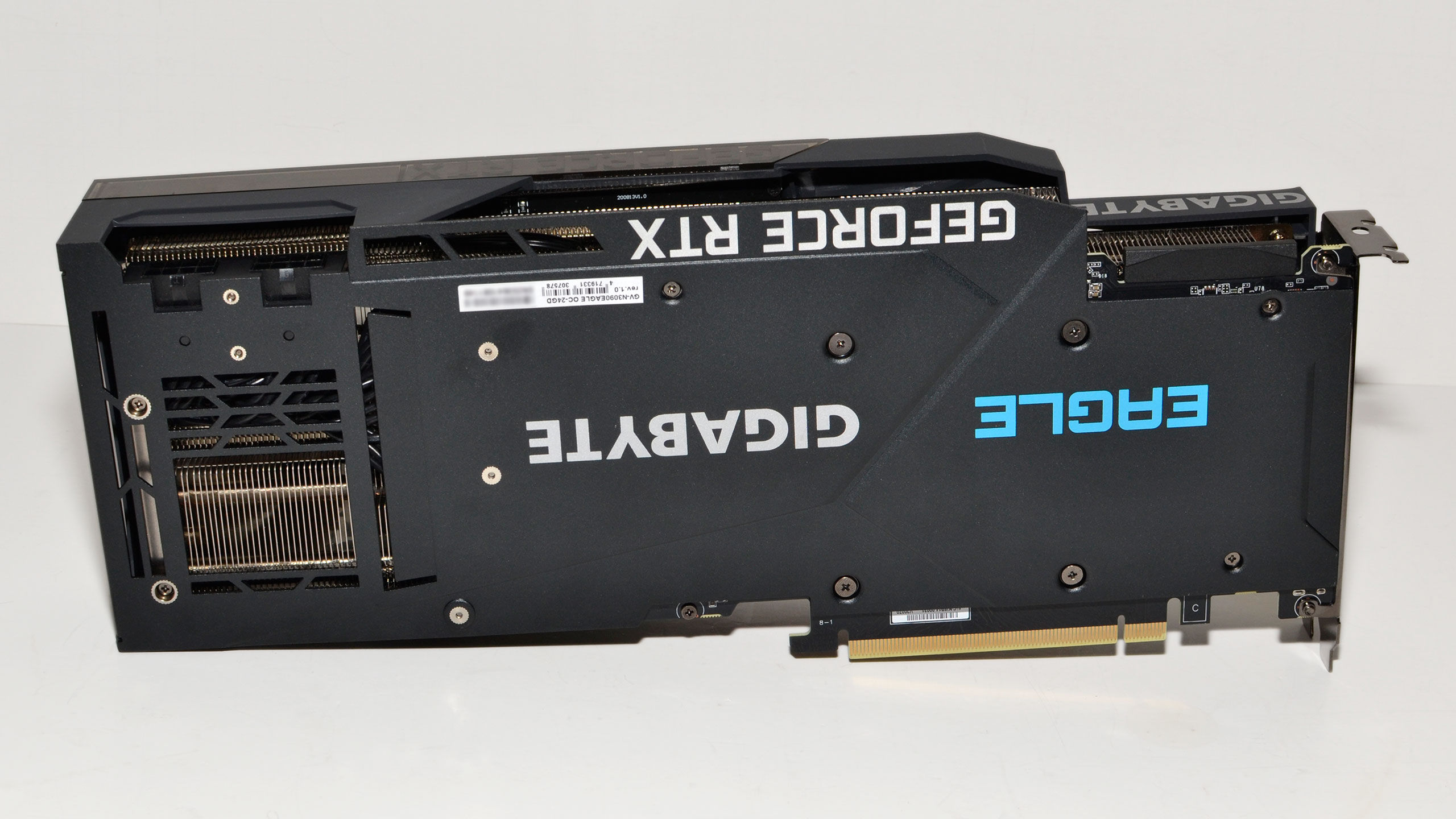
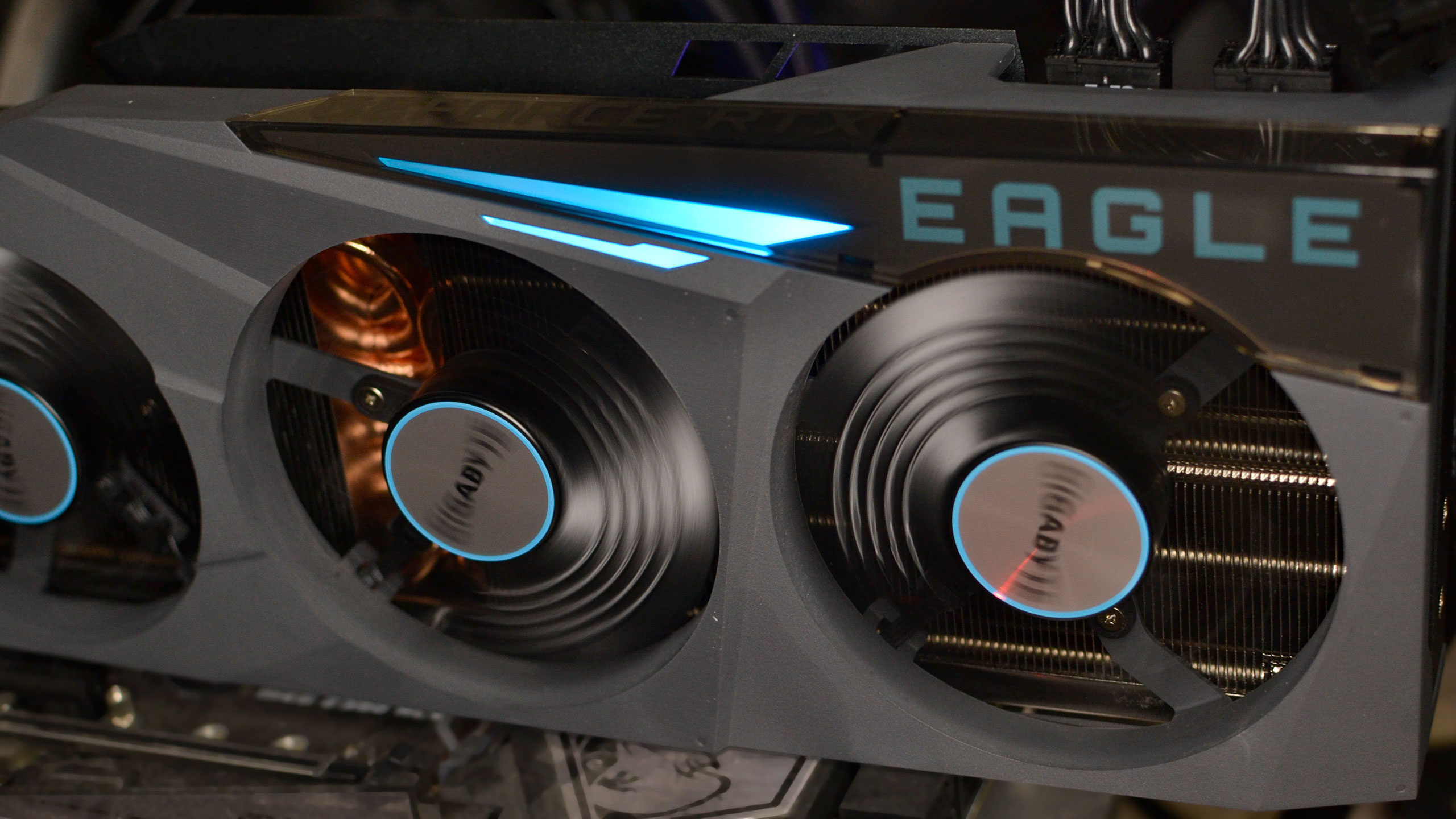
Something else that's a bit interesting is the three fans. The left fan, closest to the video ports and sitting basically above the GPU, is an 80mm fan. The other two fans are 85mm. These are also the same style of Windforce fan blades that Gigabyte has used in the past, with a triangular 'tooth' on the leading edge that's supposed to improve airflow.
Get Tom's Hardware's best news and in-depth reviews, straight to your inbox.
The Gigabyte RTX 3090 Eagle includes five video ports, which is one more than the Founders Edition. There are three DisplayPort 1.4a outputs and two HDMI 2.1 outputs, and the card can drive up to five monitors if needed. Despite the ventilation cutouts on the rear IO bracket, however, the card won't exhaust much heat that route. The radiator fins are oriented perpendicular to the IO plate, so most of the airflow will end up exiting the top and bottom of the card.
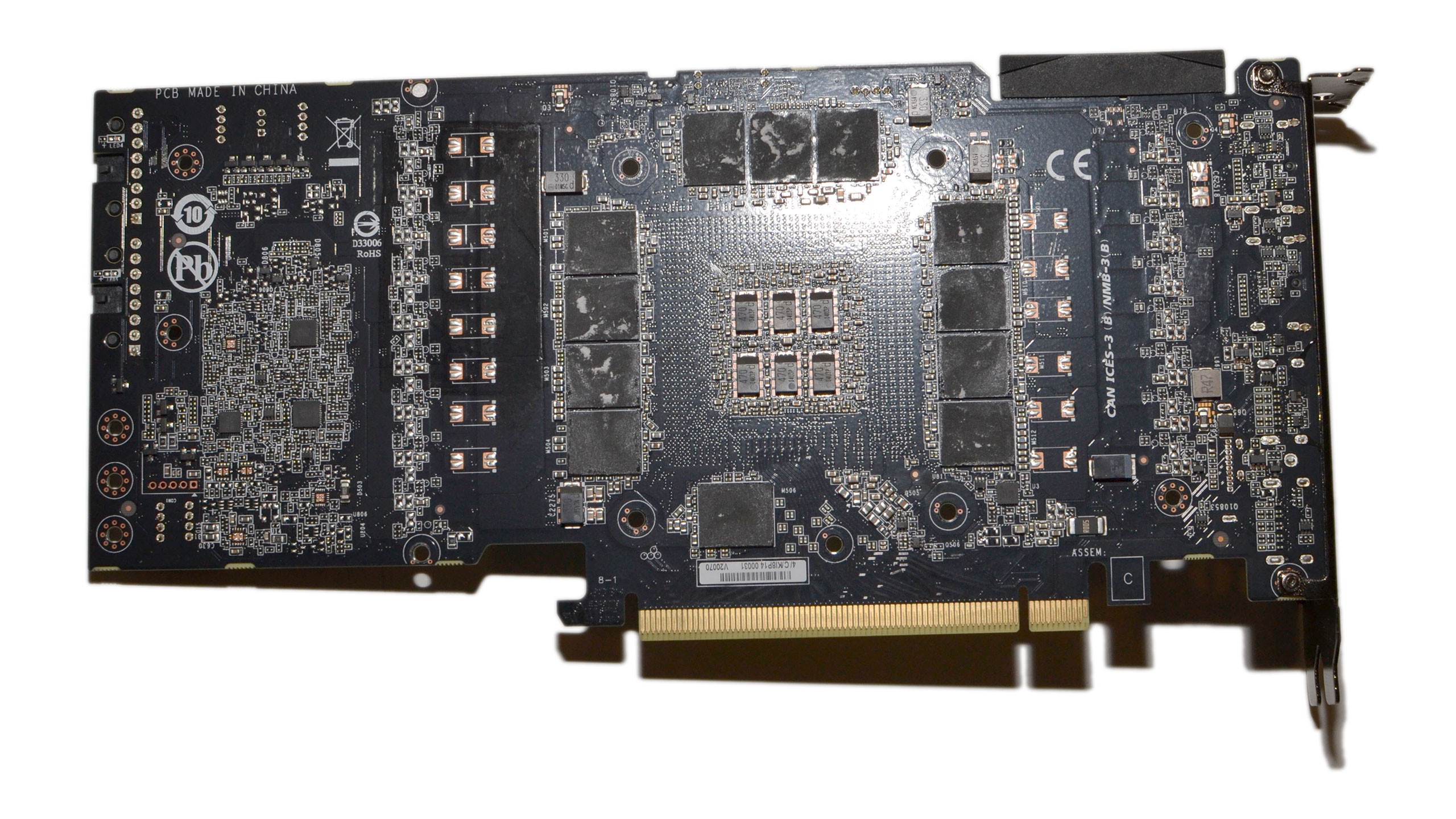
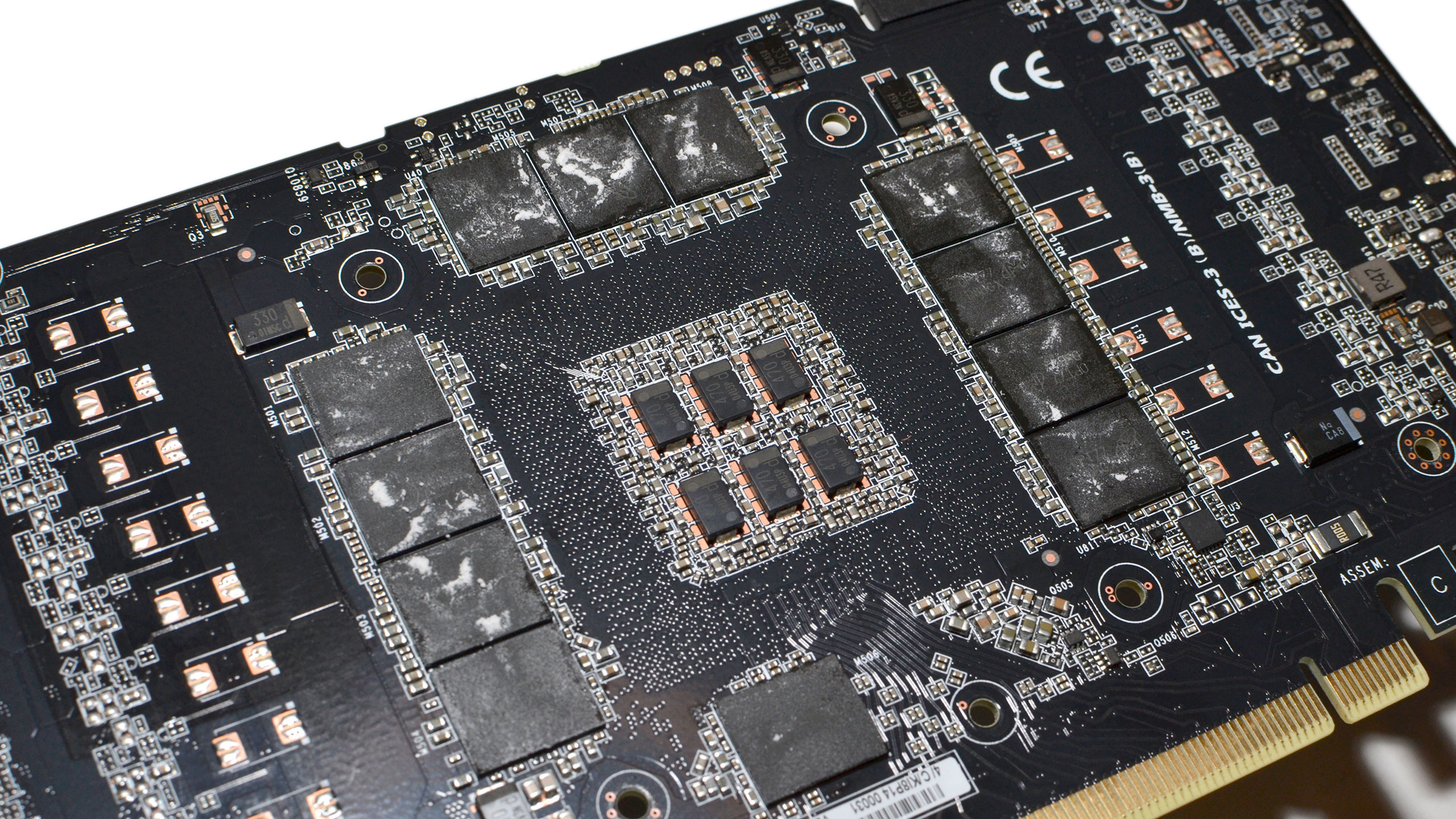
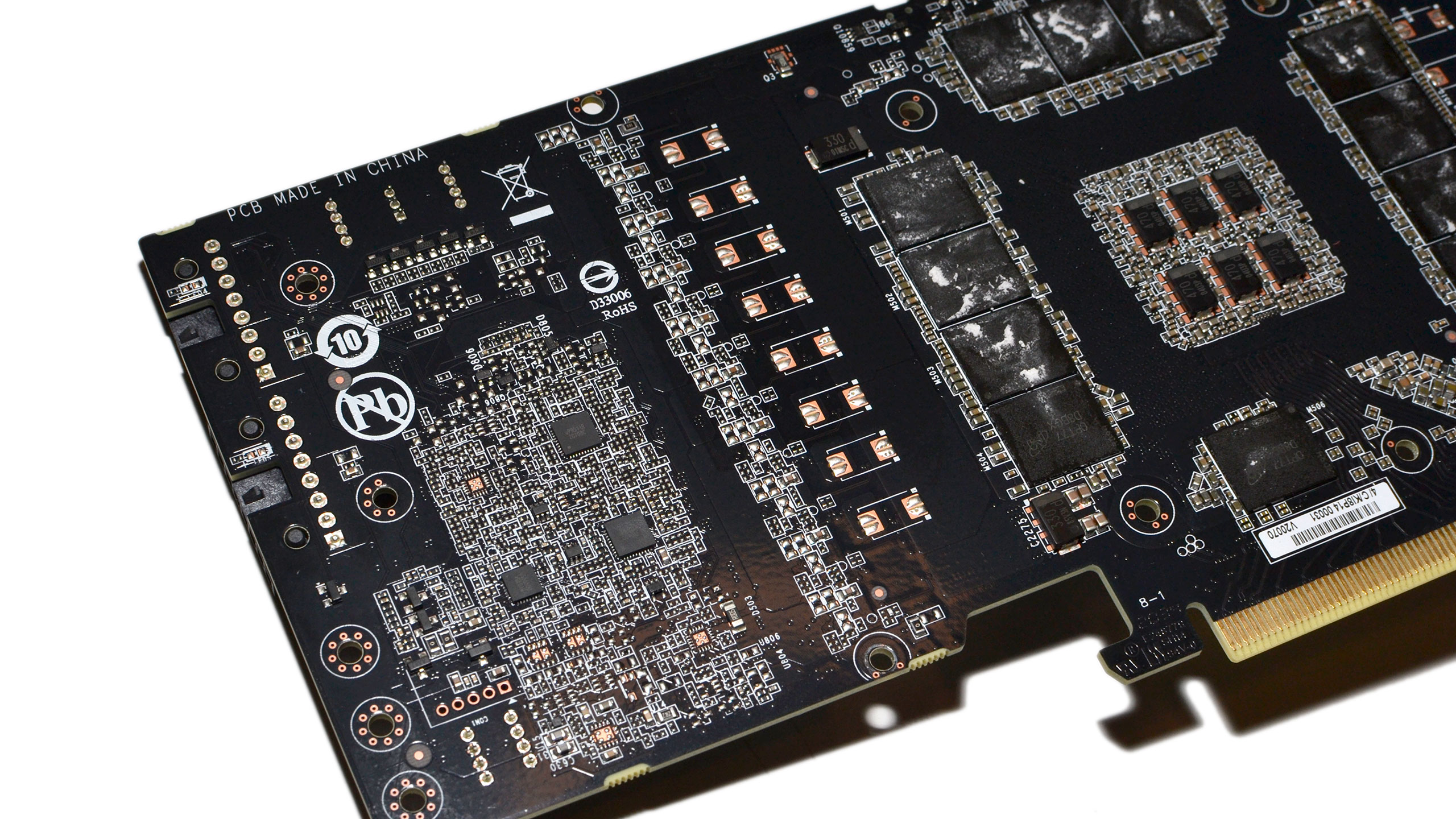
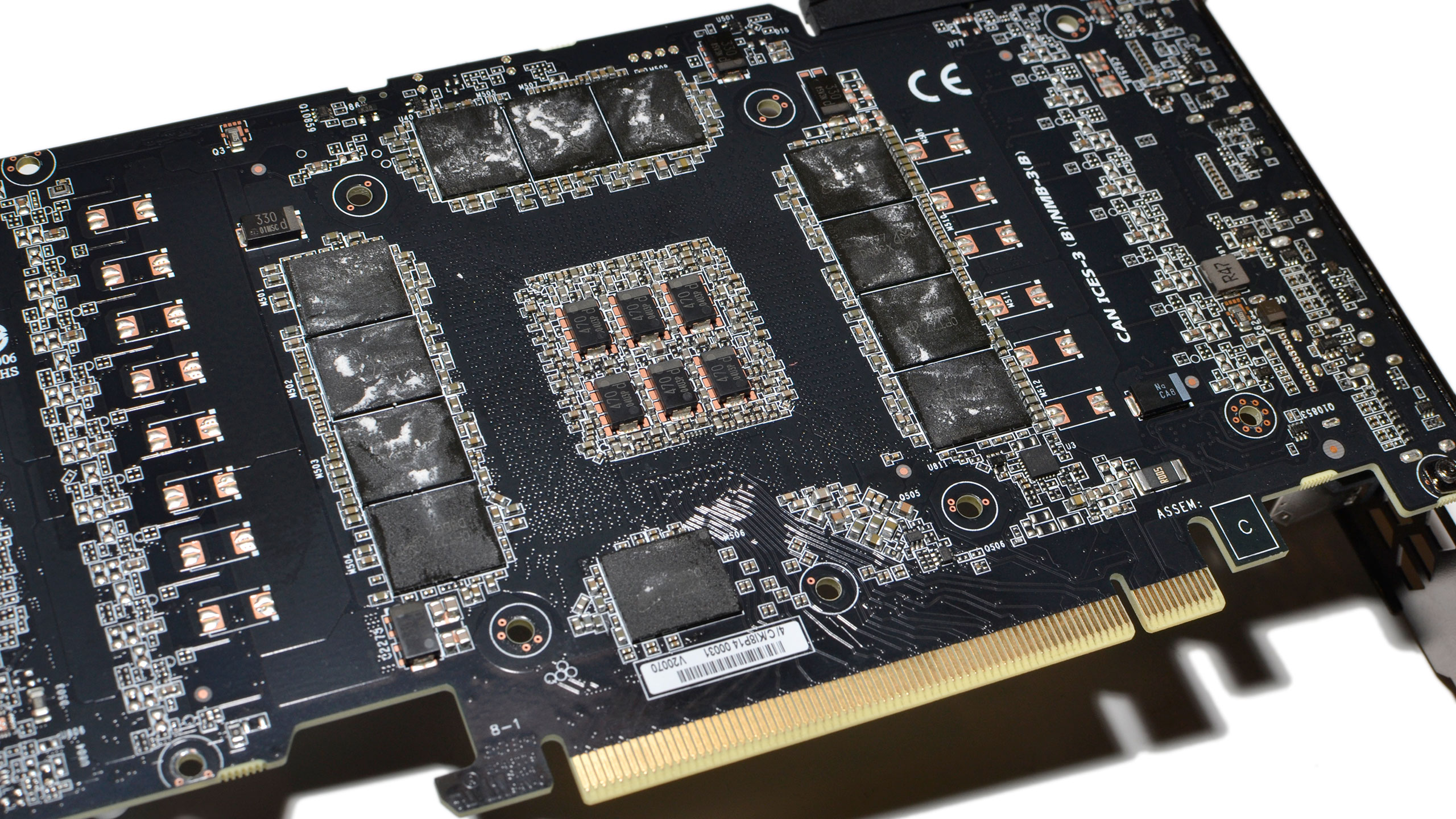
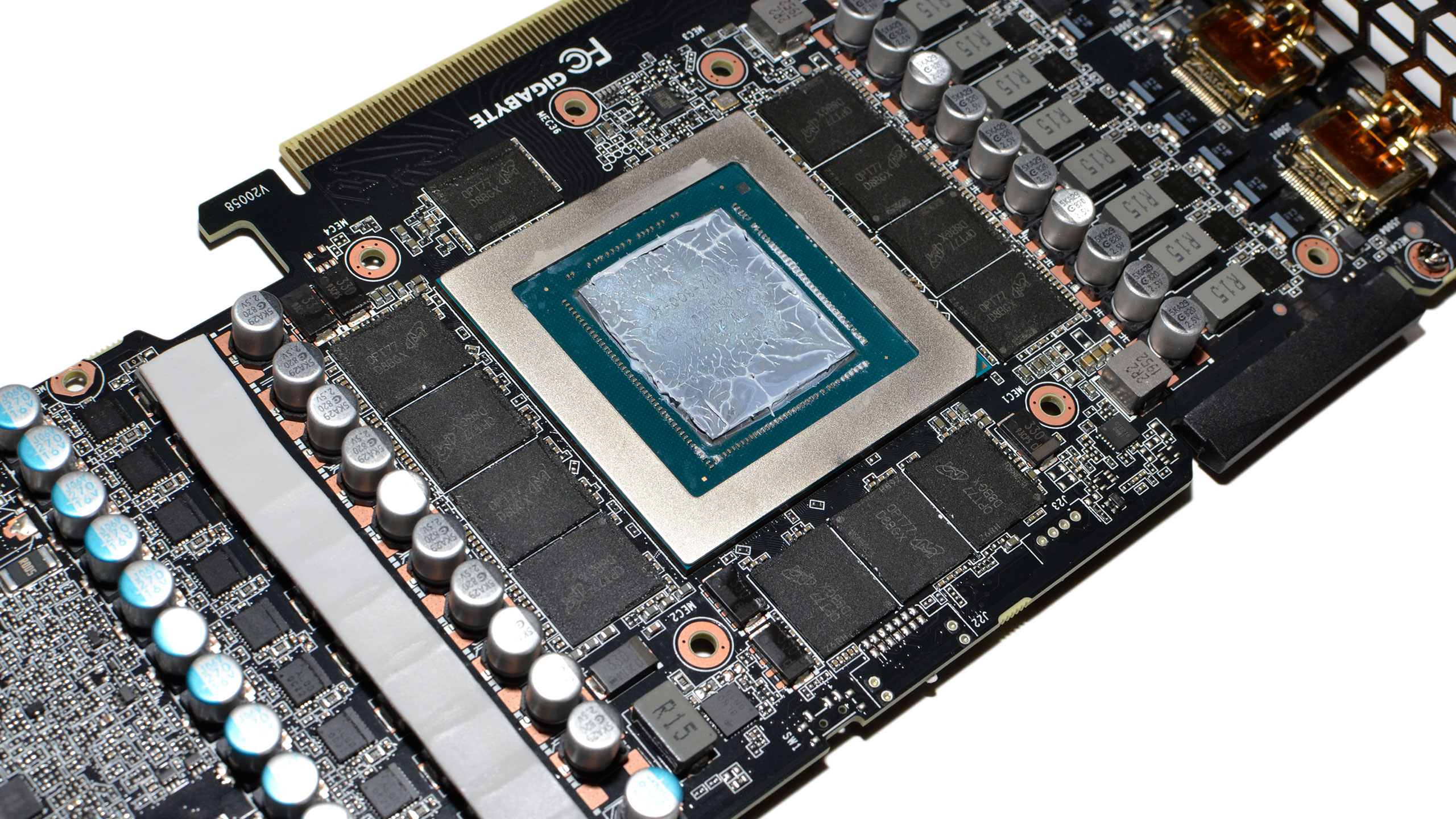
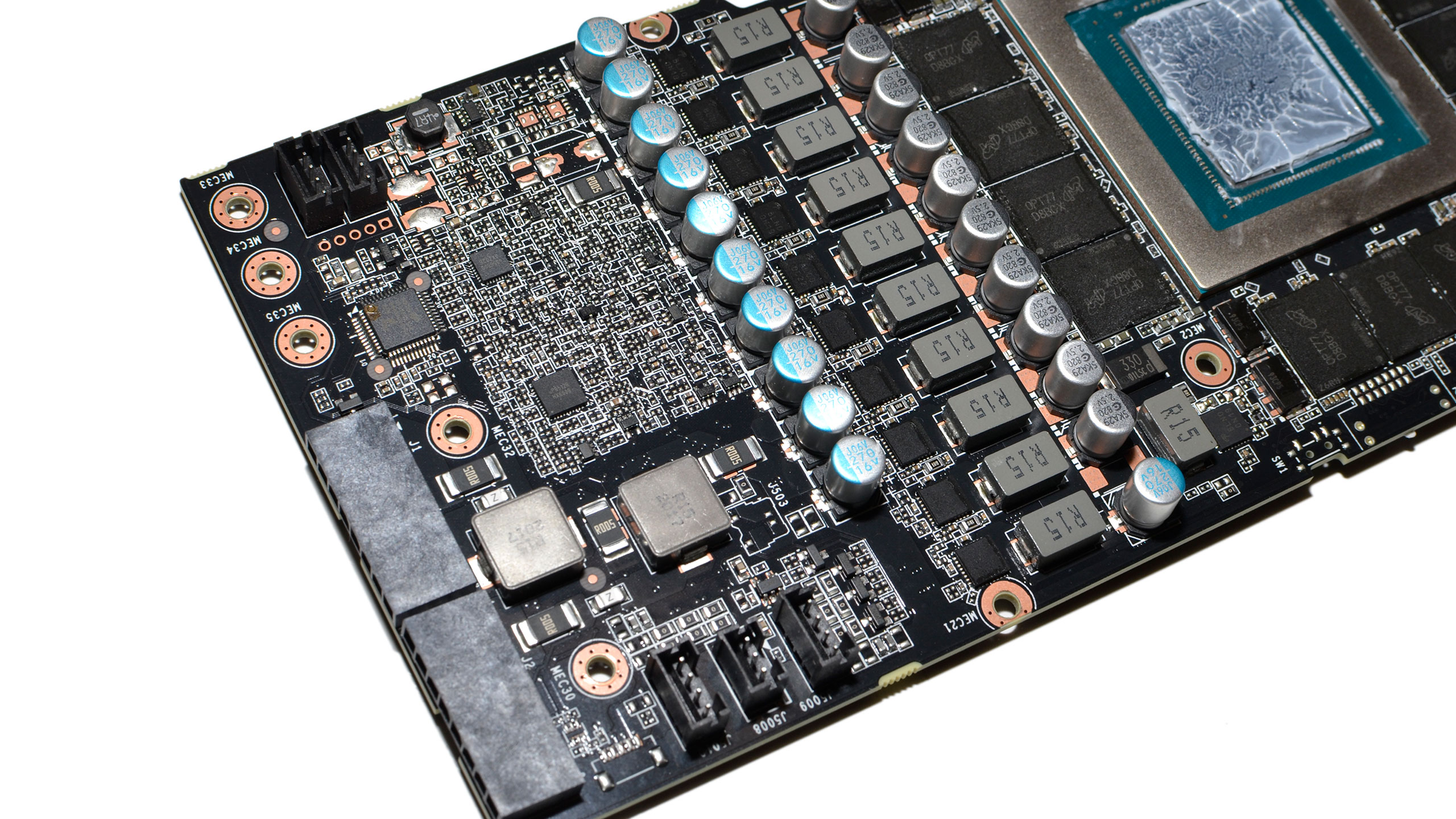

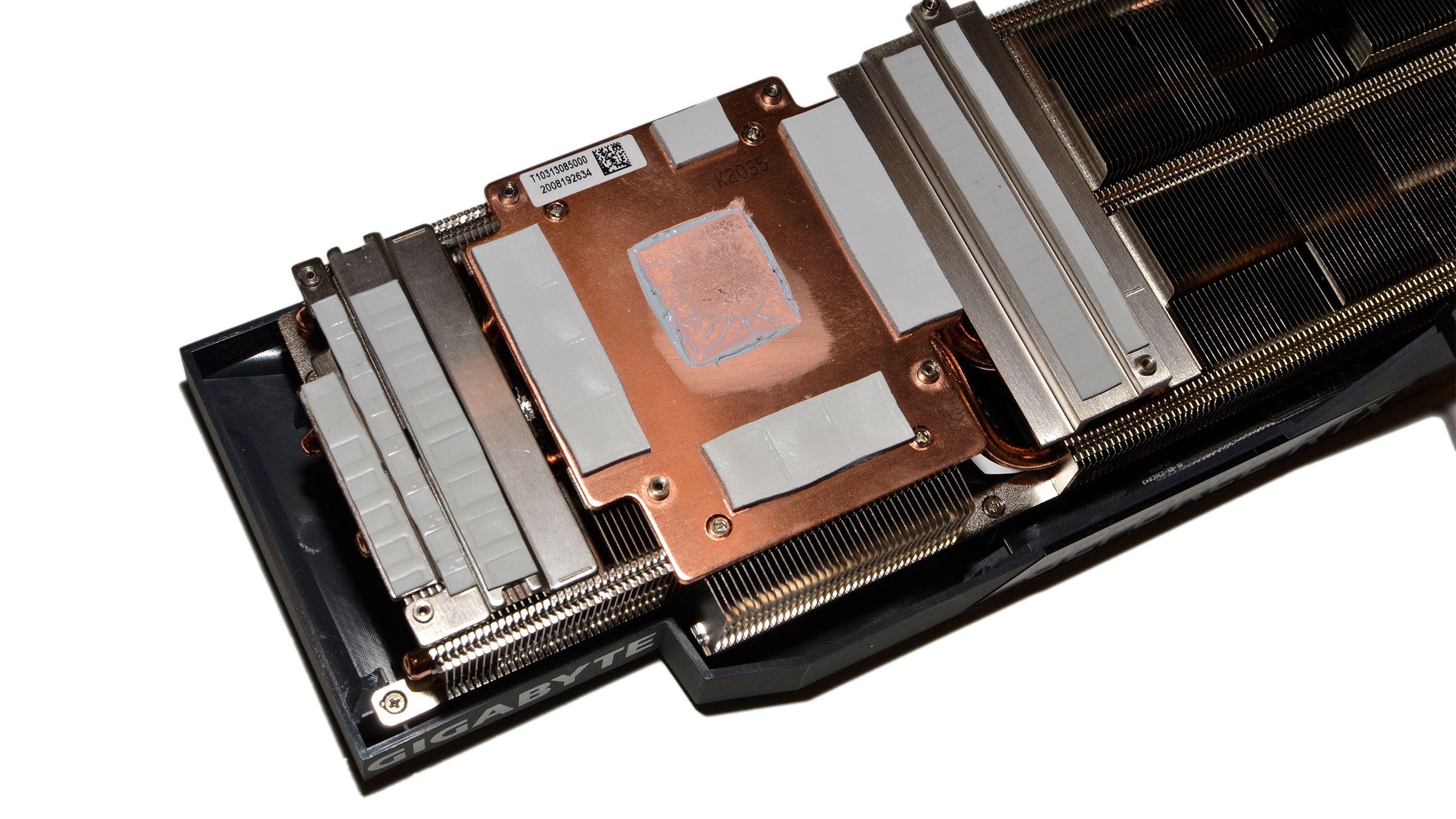
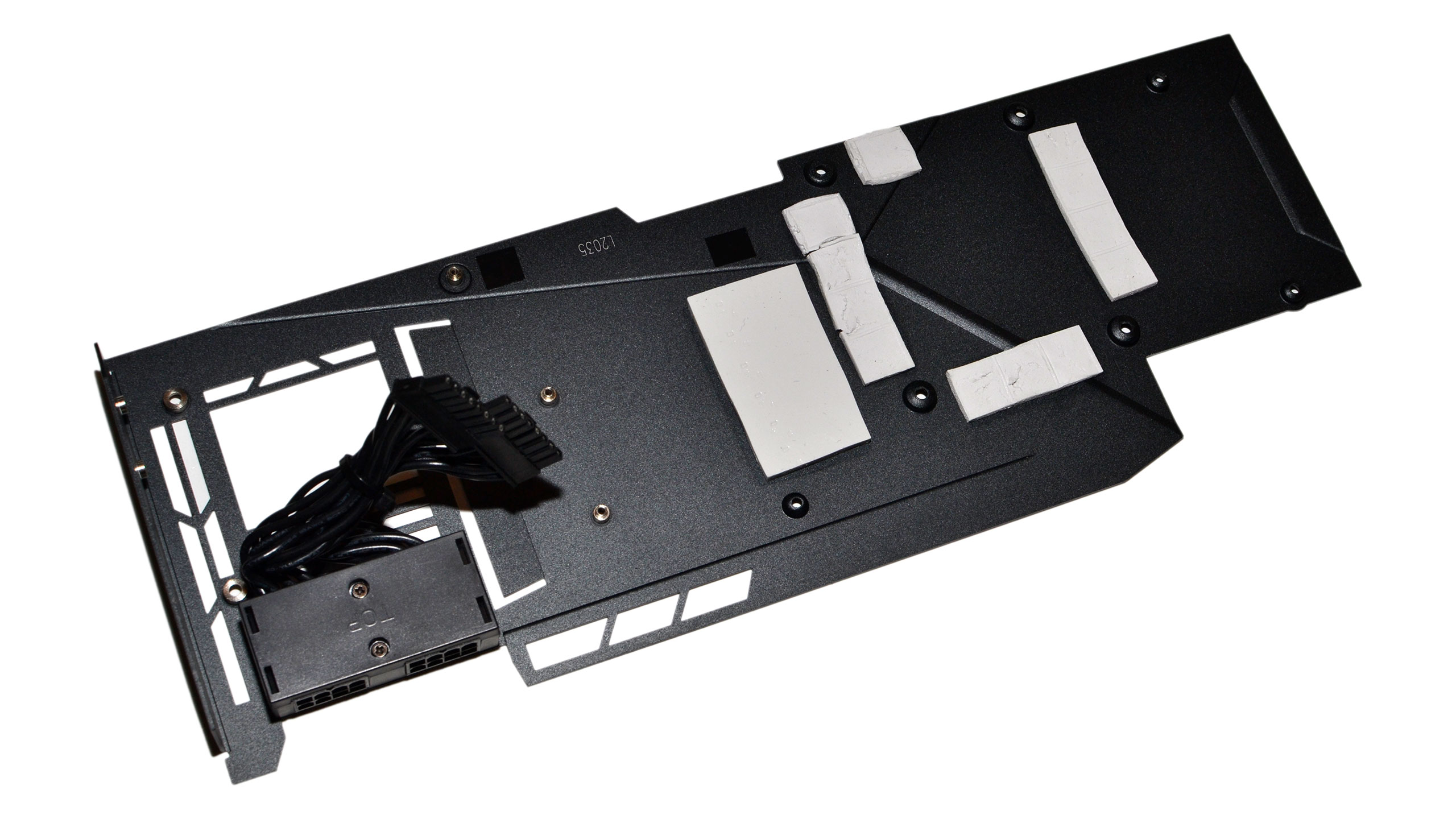
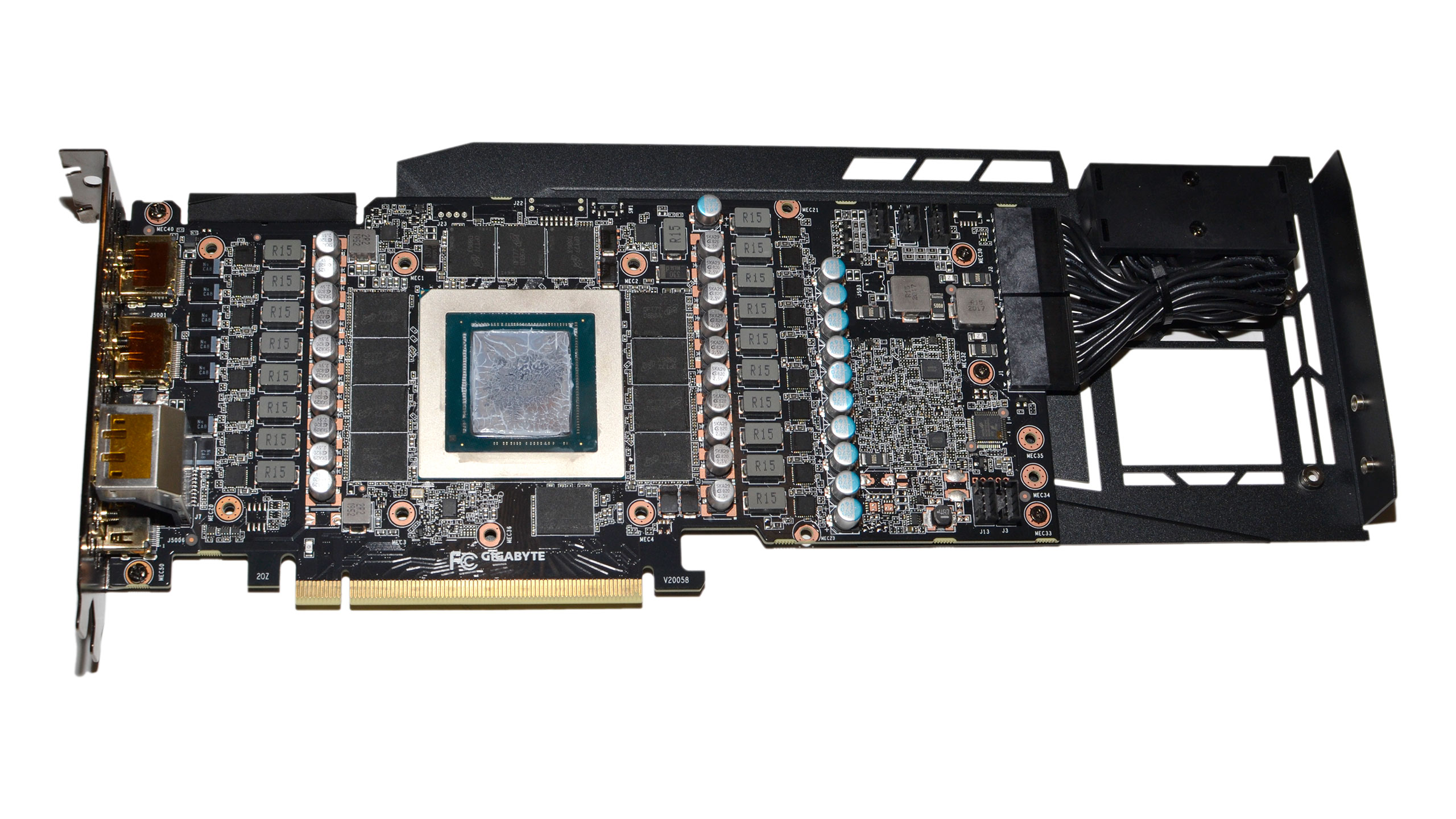
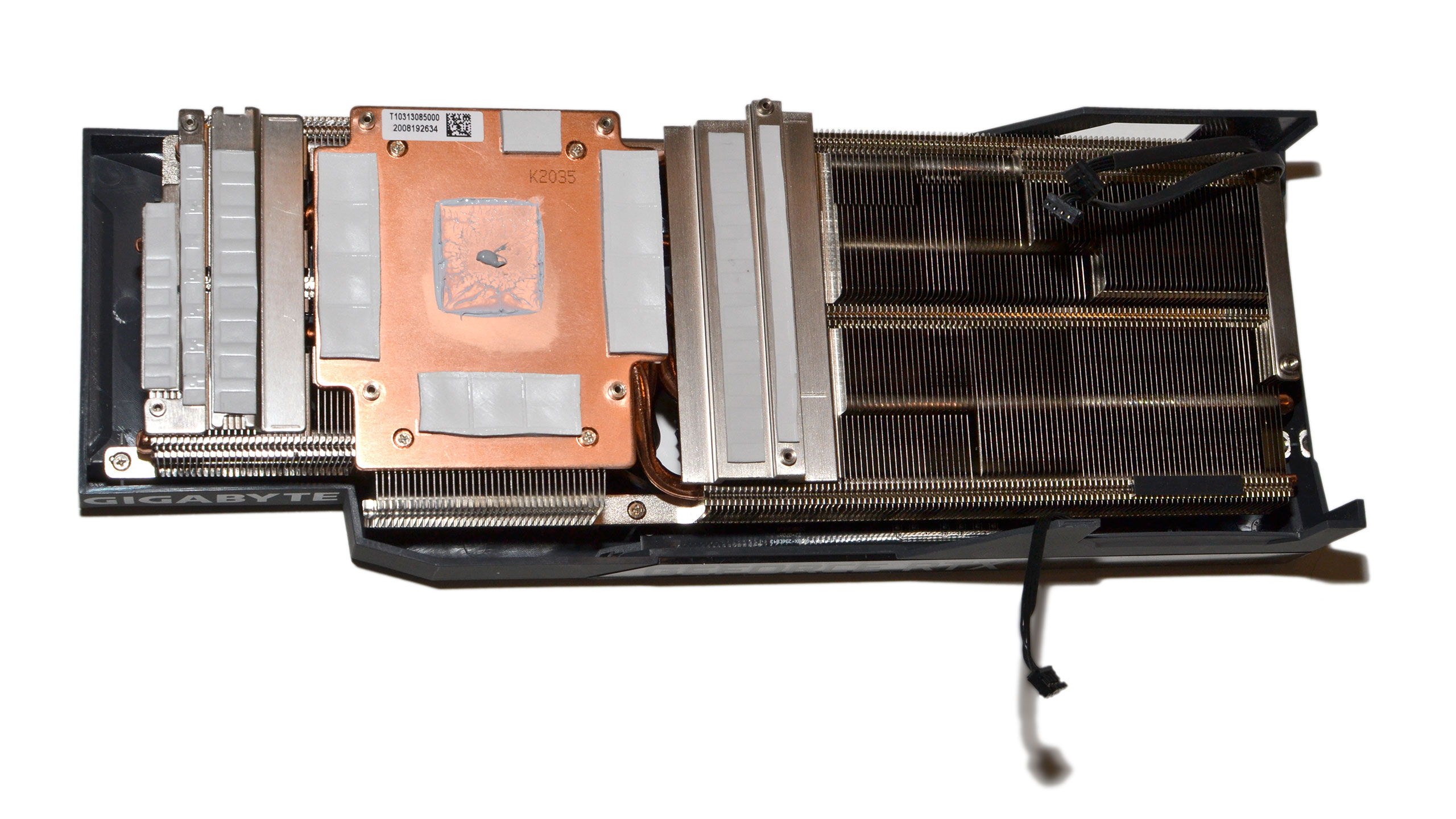
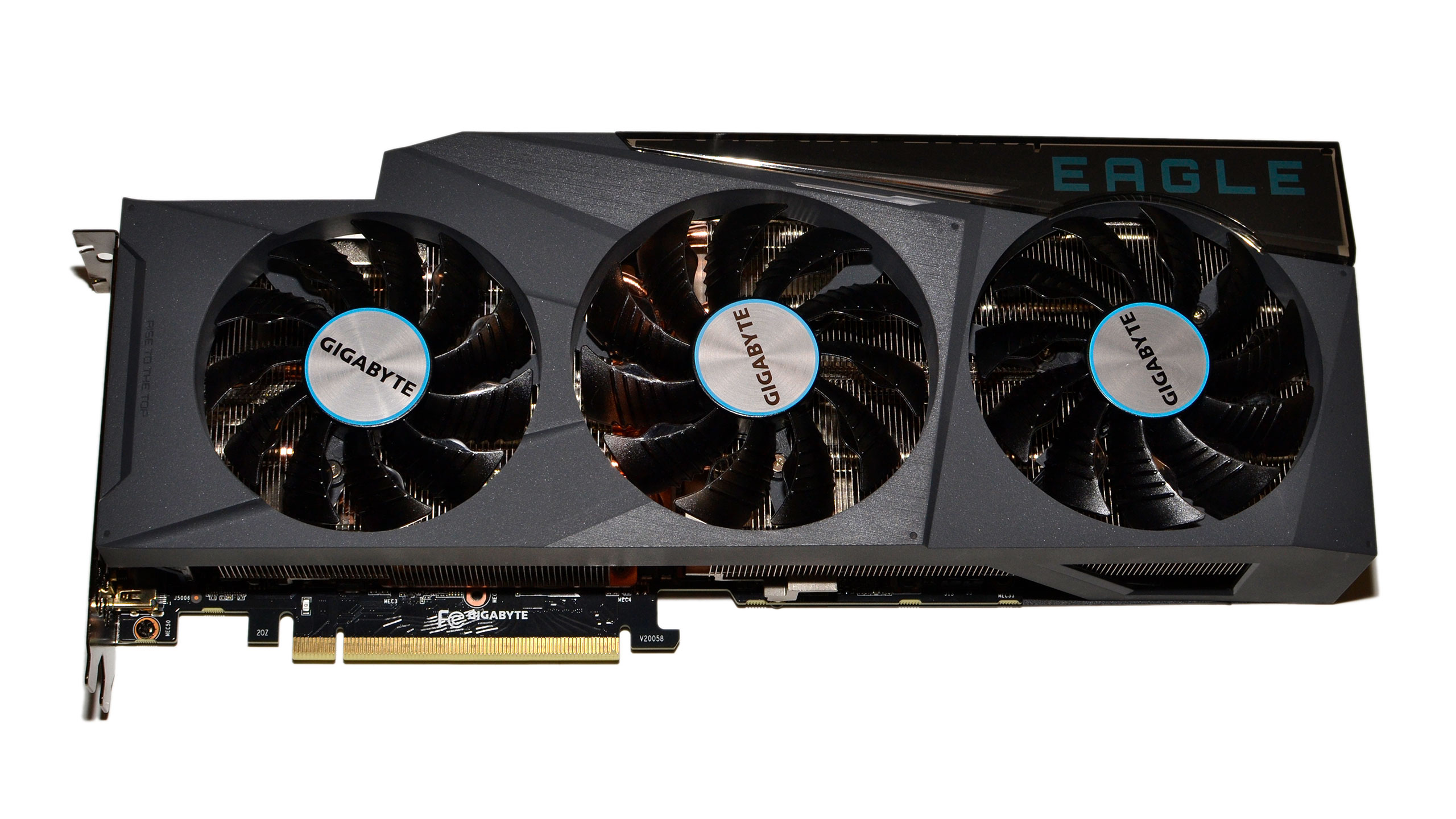
Disassembling the 3090 Eagle is relatively straightforward, though you have to remove the main cooler on the front before you can get at the last three screws that secure the backplate. As with other 30-series GPUs, there are quite a few thermal pads between the cooler and the RAM, capacitors, voltage regulators, and other components. A few of the pads ripped when we pulled the cooler off, even though we were trying to be careful, but that generally won't impact cooling performance.
With the cooler and backplate removed, the bare PCB and components are visible. The Gigabyte design is different from several other GPUs we've looked at, with an extension at the back of the card that locates the two 8-pin PEG connectors beyond the end of the PCB. That's probably better for managing cabling in our PC build, though it doesn't really impact most other aspects of the design.
The Gigabyte board appears to use a 15-phase power delivery system for the GPU, with three additional phases used for other elements. The RAM comes from Micron of course, it's currently the only manufacturer of GDDR6X memory, and is rated for 21Gbps, though like other 3090 cards it's only clocked at 19.5Gbps. Also of note is that behind the GPU are six SP-Caps, with no MLCC blocks. We experienced quite a bit of instability on the Gigabyte card with the launch drivers, but thankfully that was cleared up with the 456.55 and later drivers.
Gigabyte RTX 3090 Eagle: Manual Overclocking

Even with the latest 456.55 (and now 456.71) drivers, there doesn't appear to be much headroom for GPU overclocking on our Gigabyte RTX 3090 Eagle sample. Some graphics tests will allow for a +100MHz offset; others were unstable even with a +75MHz increase. For stability across the tests suite, +60 MHz was the best I could do. Average GPU clocks at stock were around 1840-1900 MHz, depending on the game, and 30-50 MHz faster with the overclock applied.
A bigger benefit for the GPU clocks doesn't come from overclocking, but rather from boosting the GPU power limit. The RTX 3090 FE tended to exceed the 350W TGP by about 15W in our testing. However, the Gigabyte card respects the 350W limit, which means it tends to downclock more than the FE to keep power use in check. Raising the TGP limit by 10% gives it a bit more room to stretch its legs.
Memory overclocking was better, and as with previous RTX 30-series cards, we managed a +750 MHz bump to the memory clock, bringing the effective speed up to 21Gbps. The Micron D8GBX chips used on the board are rated for that speed, so that shouldn't be a problem, though the chips on the back of the card don't have active cooling and may end up running a bit hot.
With the above overclocks in place (+60 core clocks, +750 VRAM, and 110% power limit), gaming performance ends up being about five percent faster on average — at 4K ultra. That's enough to basically match the other 3090 cards we've looked at, without exotic cooling. The benefits of overclocking will generally be less at 1440p, and you probably shouldn't be looking at a 3090 for 1080p (outside of games that use ray tracing) in the first place. Or maybe you're just running CPU tests and want to show more separation among the chips (shades of AMD's Zen 3 launch are looming).
Gigabyte RTX 3090 Eagle: Test Setup

You can see the specs of our standard GPU test bed on the right. We ran a series of RTX 3080 CPU Scaling benchmarks on several other processors as well, and the results are mostly applicable here — except the 3090 would potentially be even more CPU limited, particularly at lower resolutions and settings. But for 1440p ultra and 4K ultra, the Core i9-9900K shouldn't present a problem.
Our gaming test suite consists of nine games, and for the Gigabyte RTX 3090 Eagle, we're only looking at ultra quality performance at 1440p and 4K — without ray tracing or DLSS enabled. We provided 15 'bonus' benchmarks in the RTX 3090 FE review if you want to see other tests. As you'll see in a moment, the Gigabyte card is essentially equal in performance to the FE.
We have four charts for each of the games we tested: 4K Ultra, 4K Ultra Percentile FPS, 1440p Ultra, and 1440p Ultra Percentile FPS. Despite a small factory overclock, the Gigabyte 3090 Eagle ends up just a touch slower than the 3090 FE, likely due to the differences in power and thermals that each card targets.
Gigabyte RTX 3090 Eagle: 1440p and 4K Ultra Gaming Benchmarks
9 Game Average
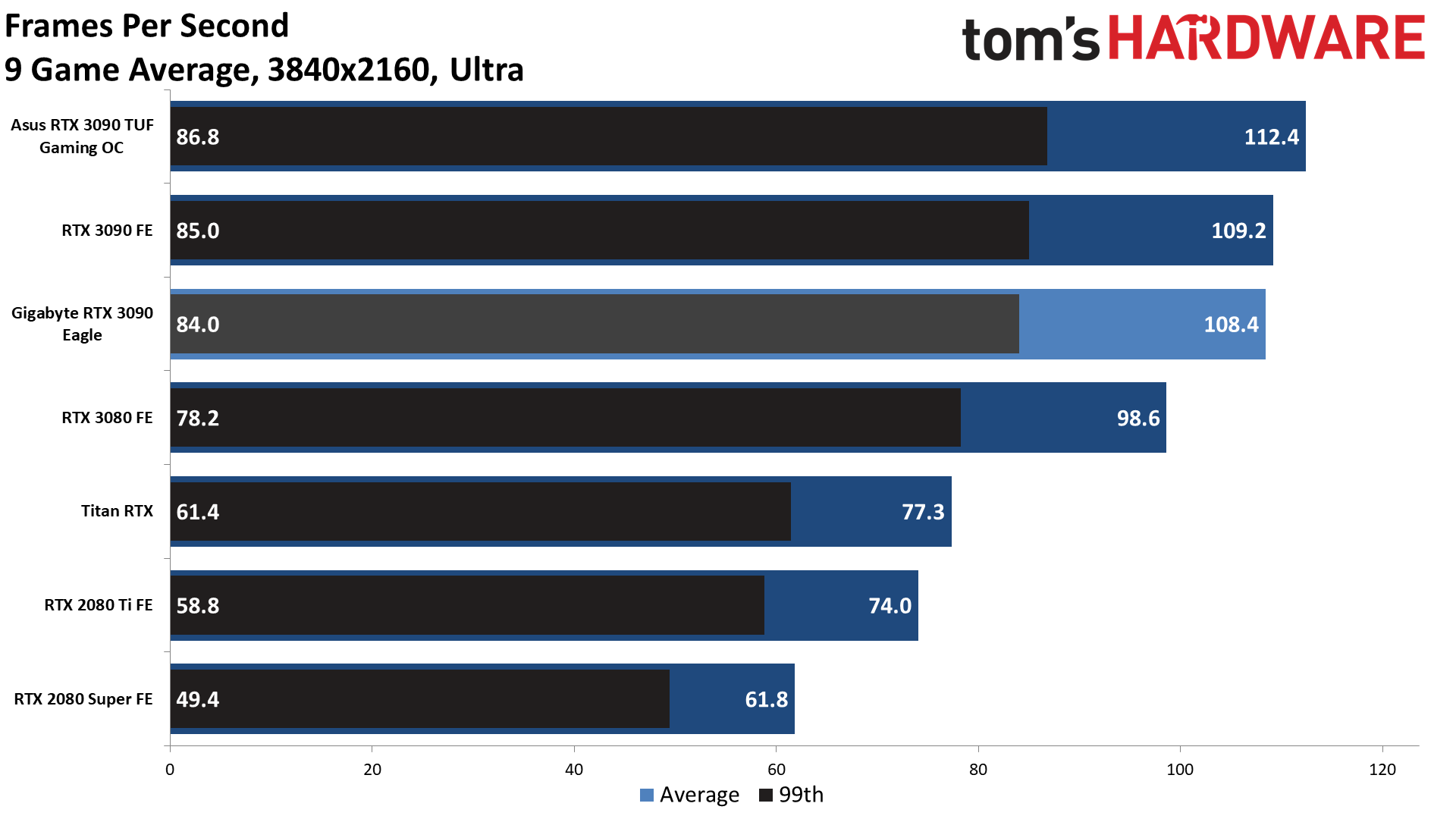
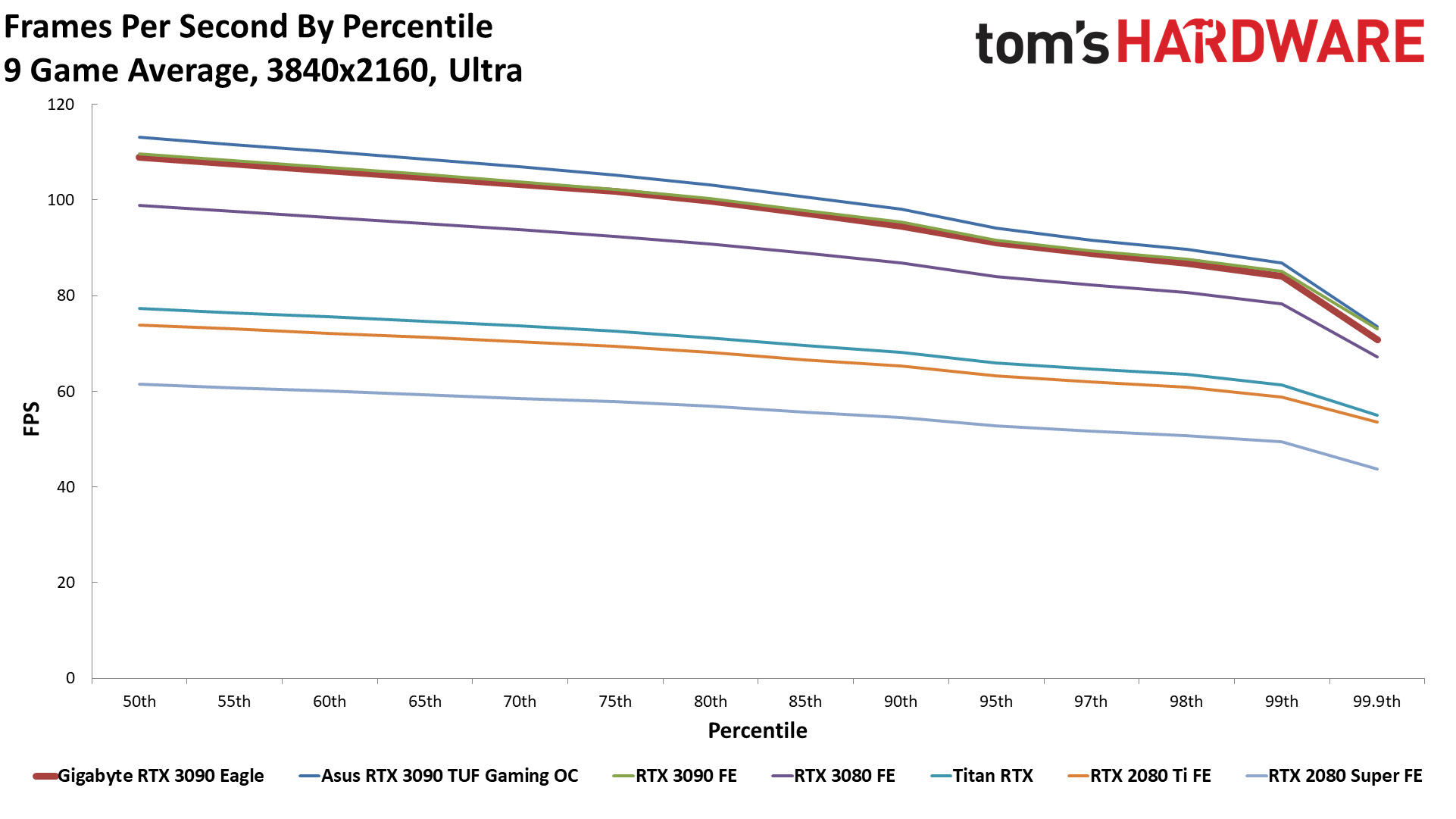
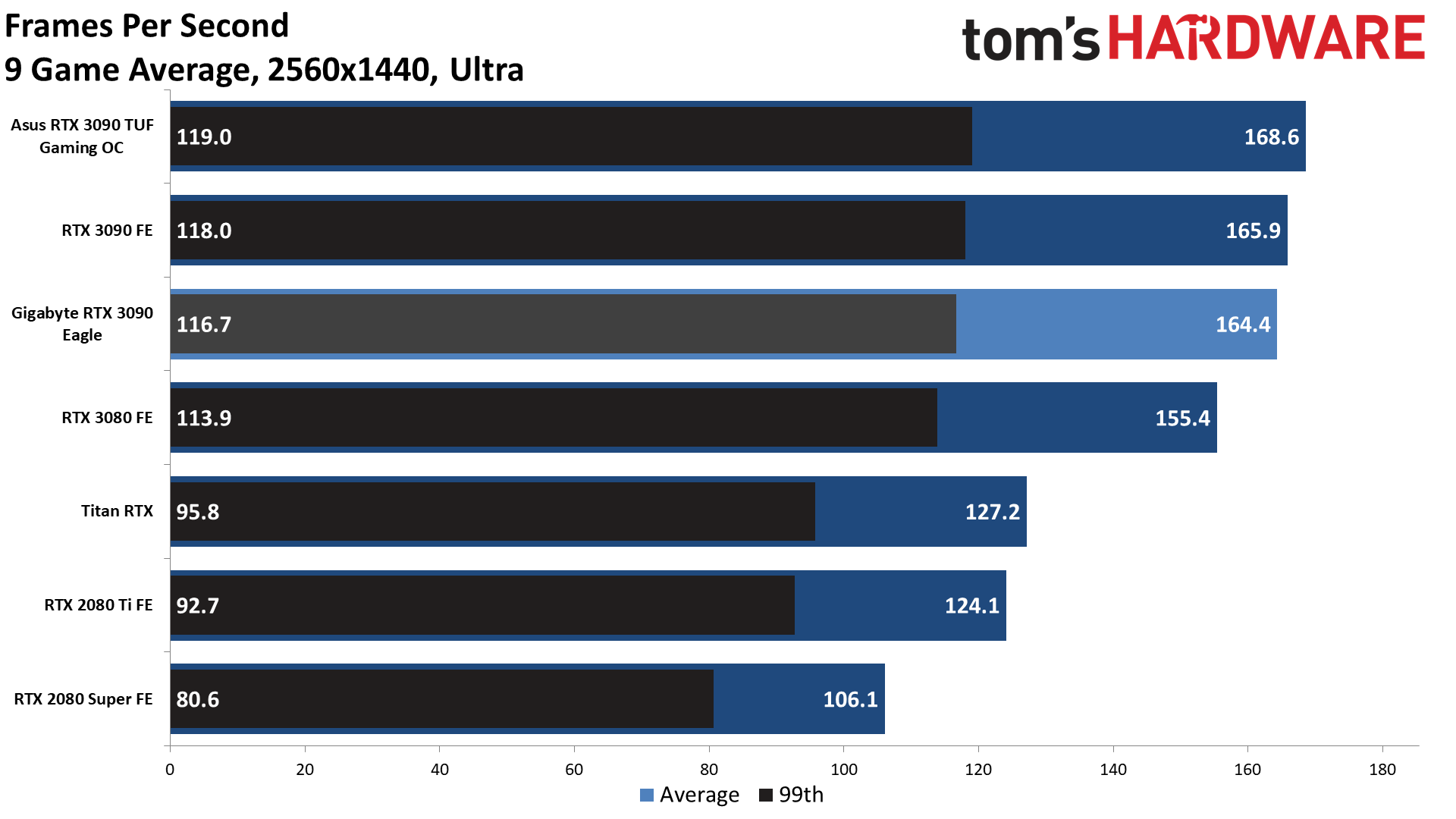
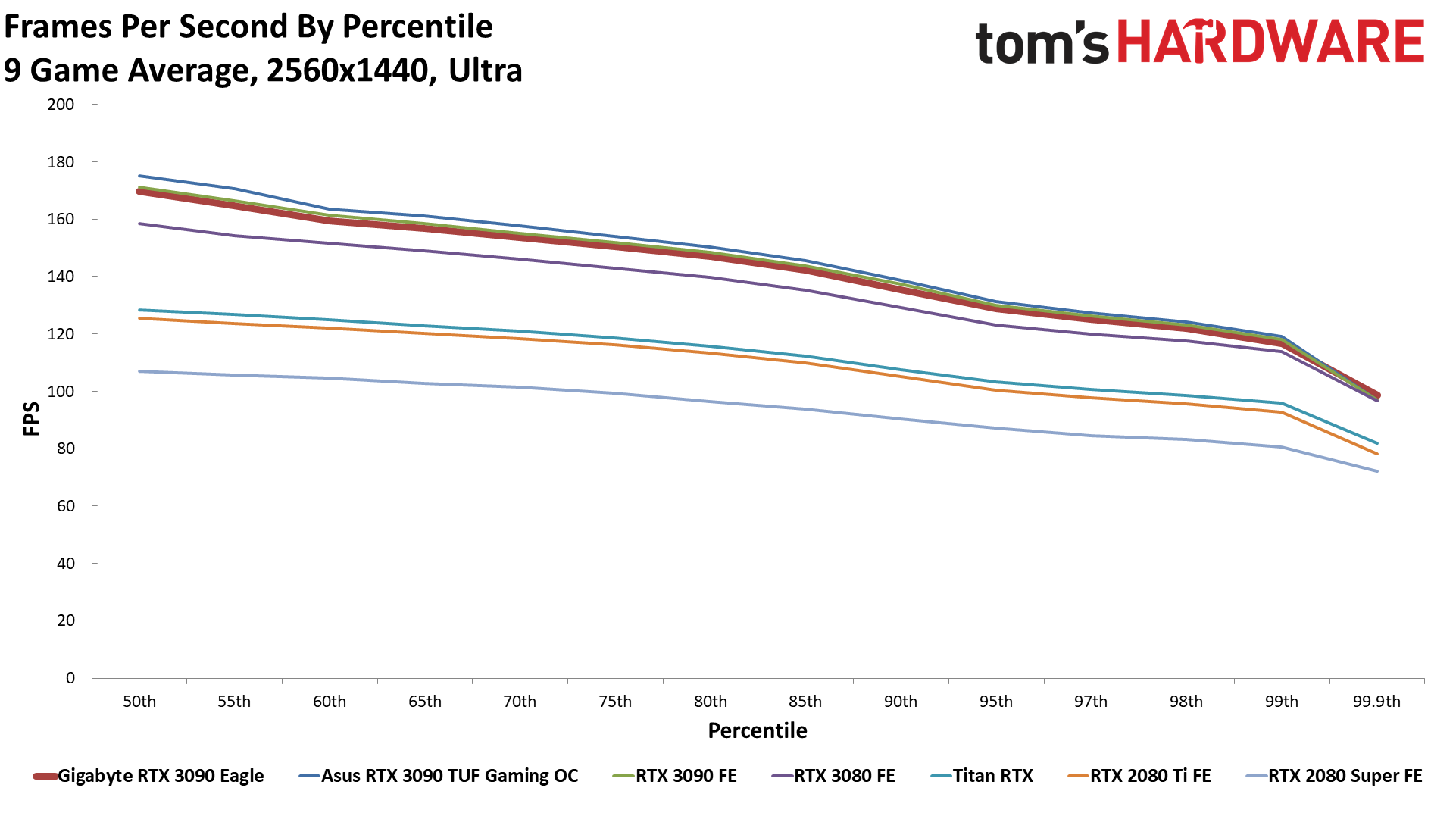
Borderlands 3
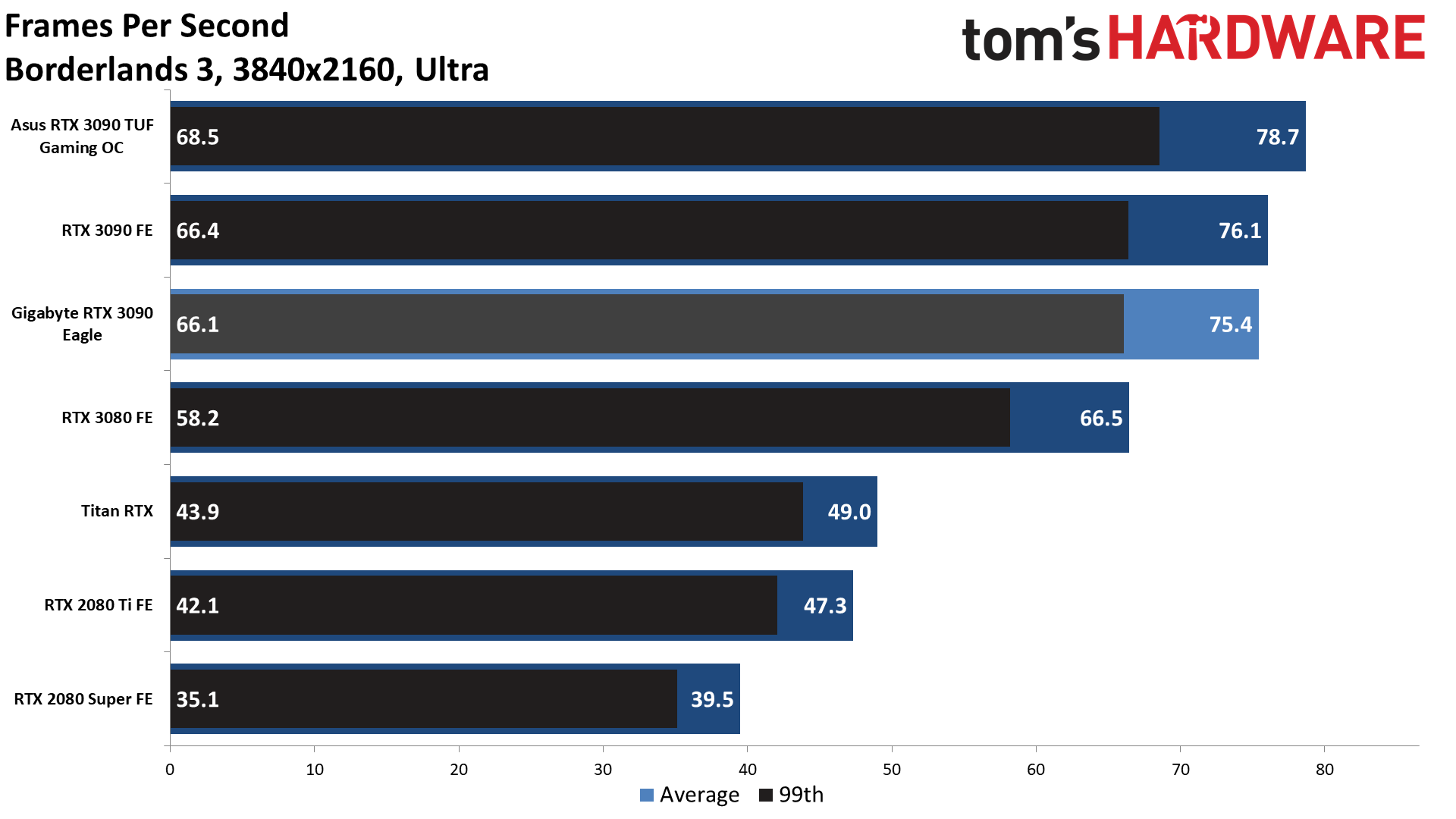
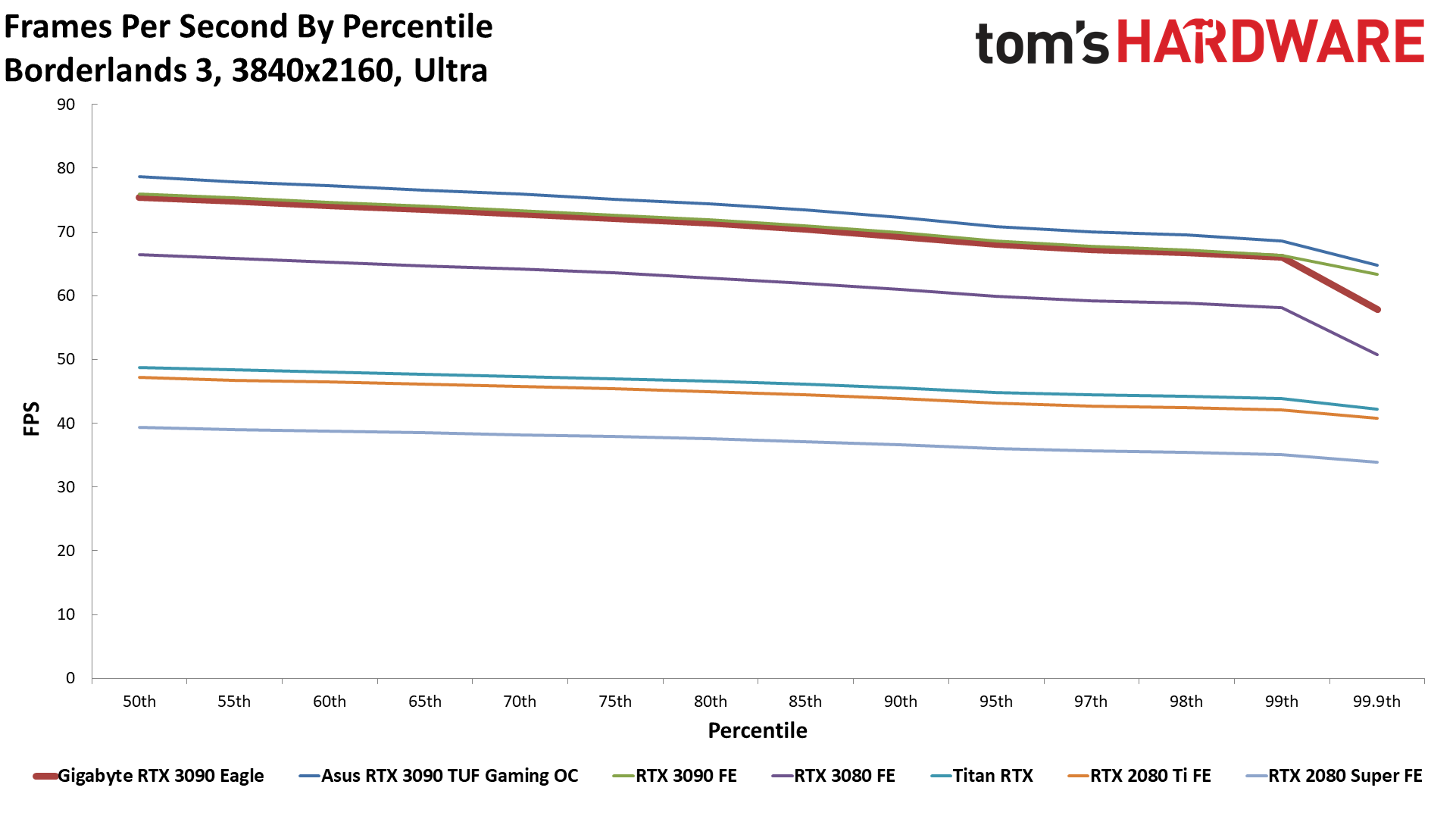
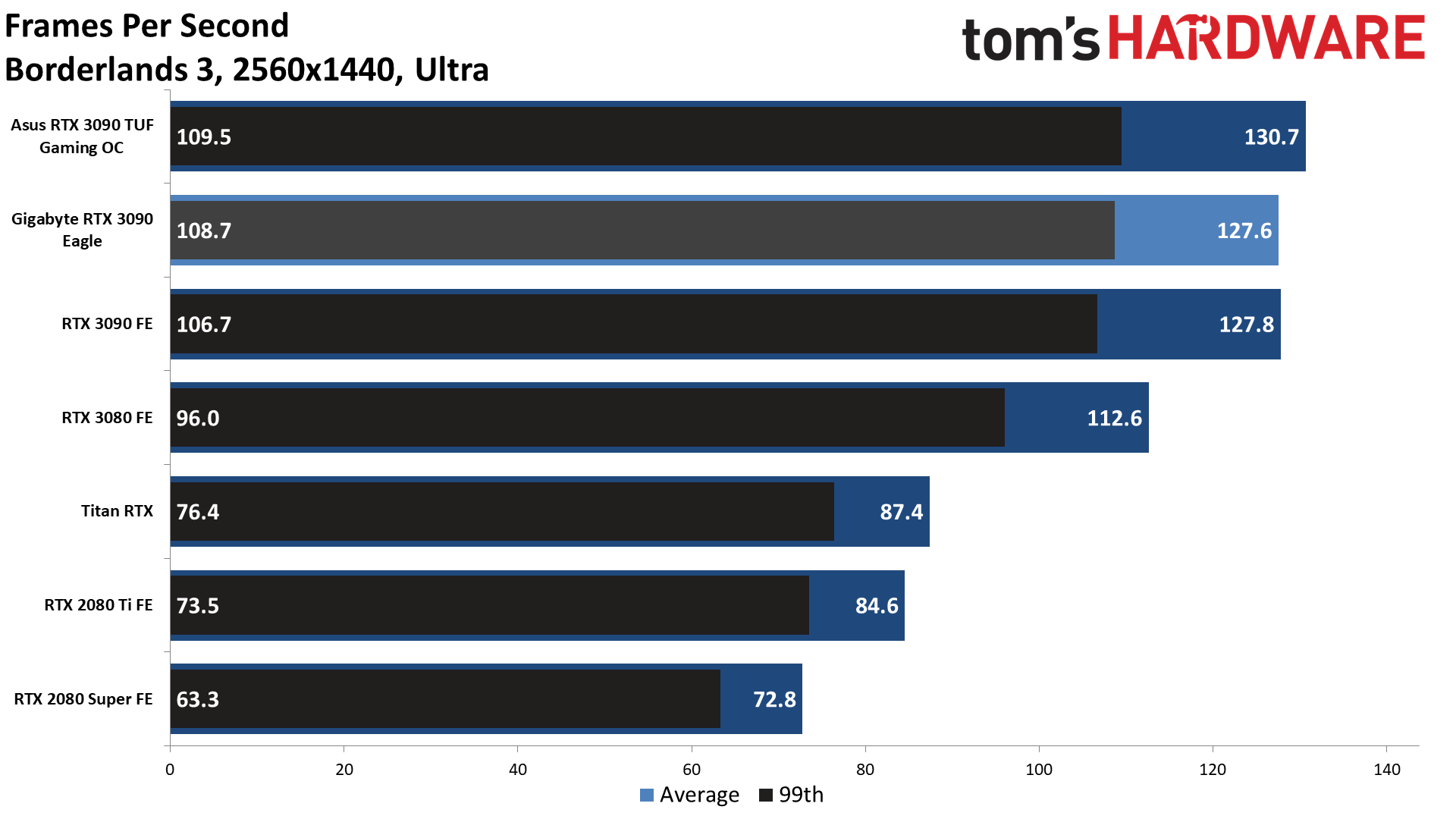
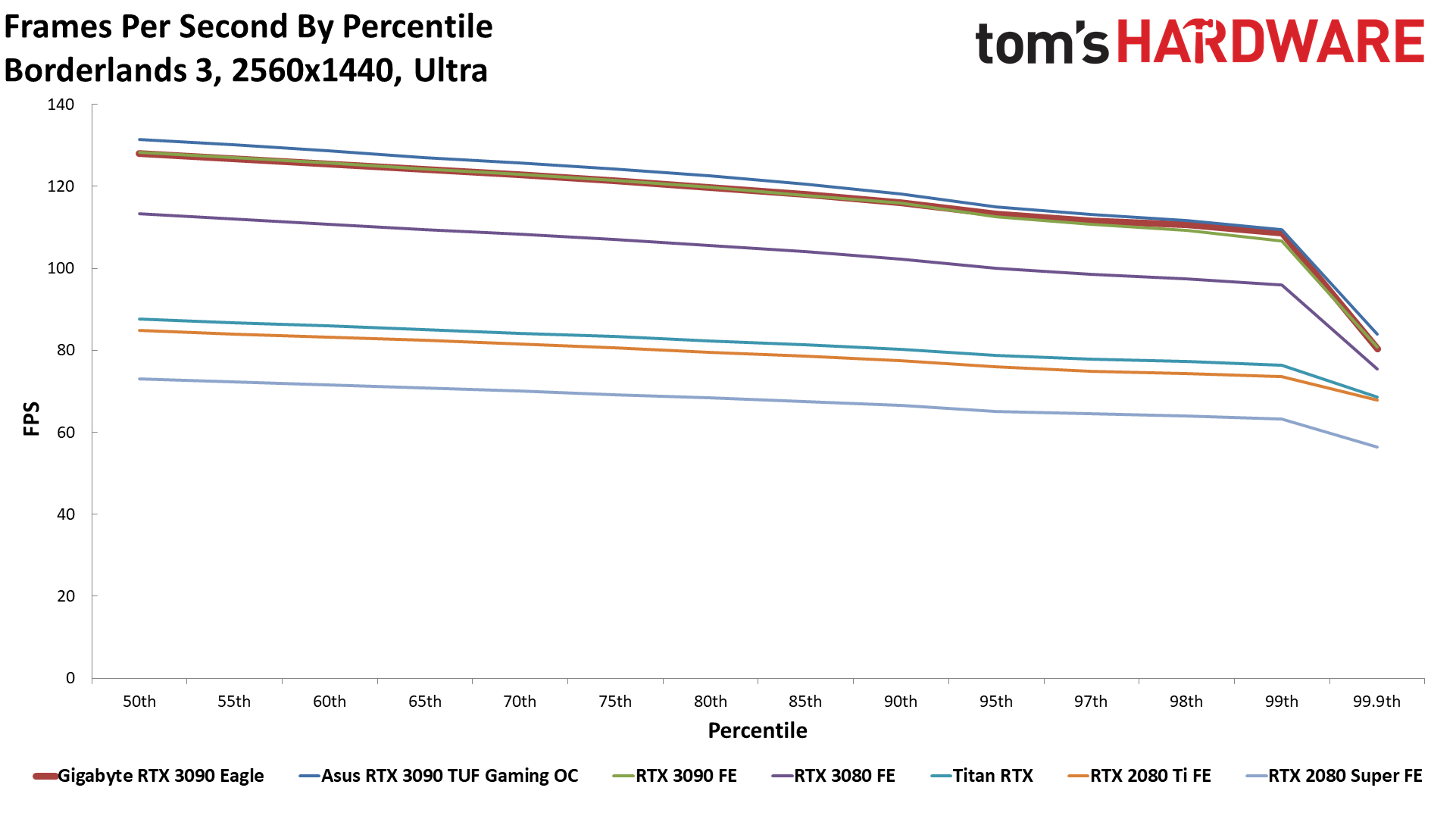
Division 2
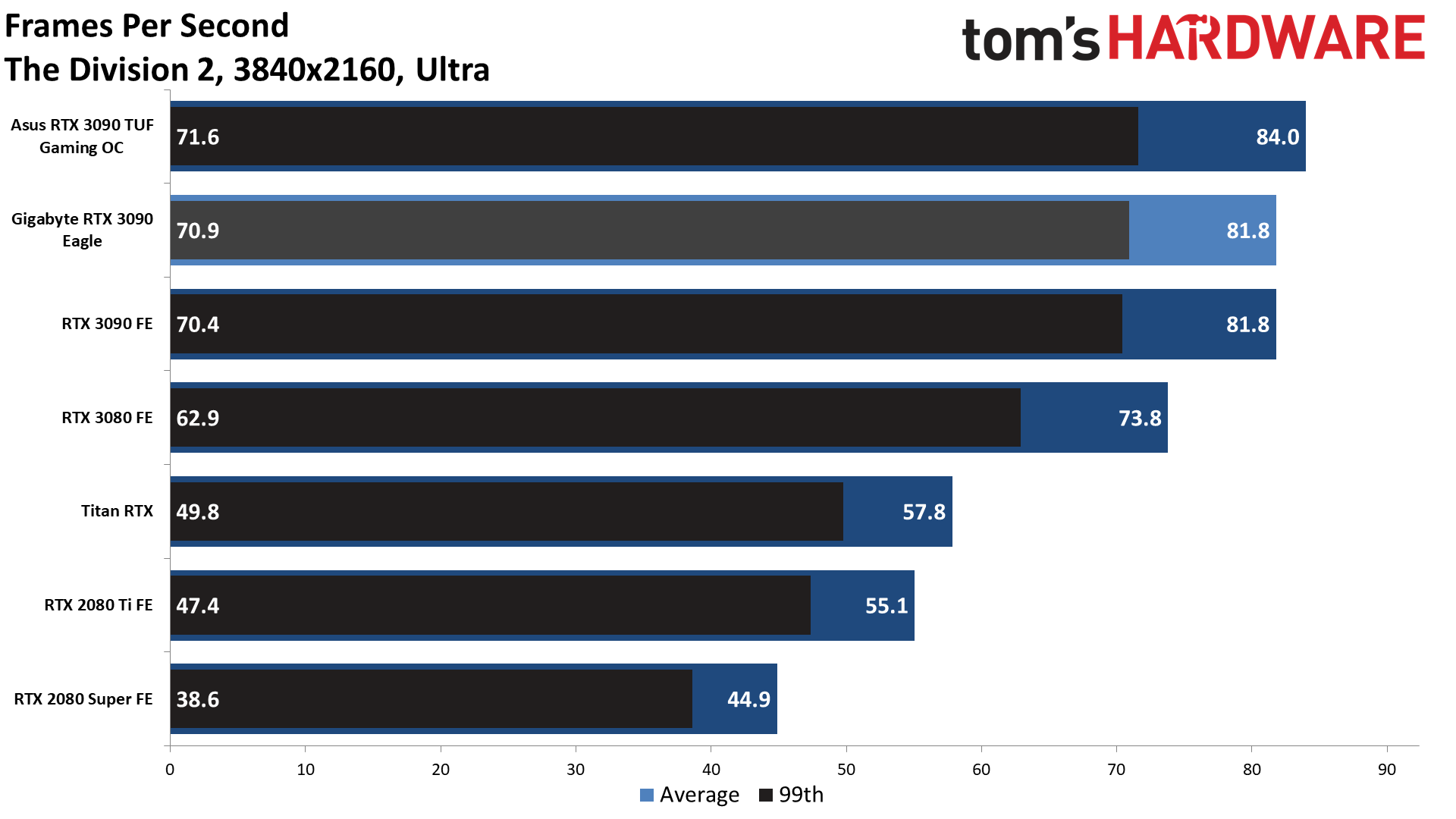
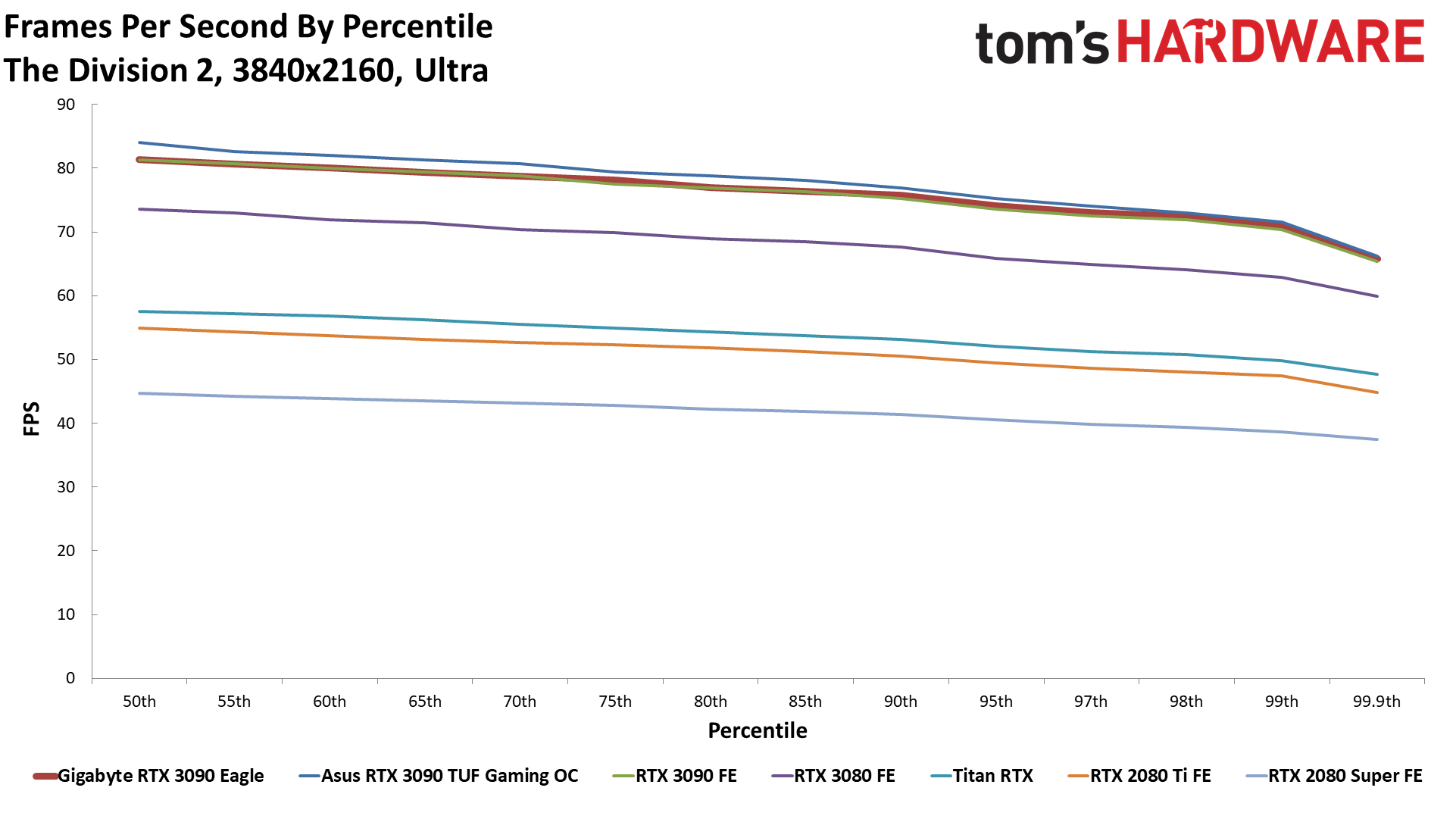
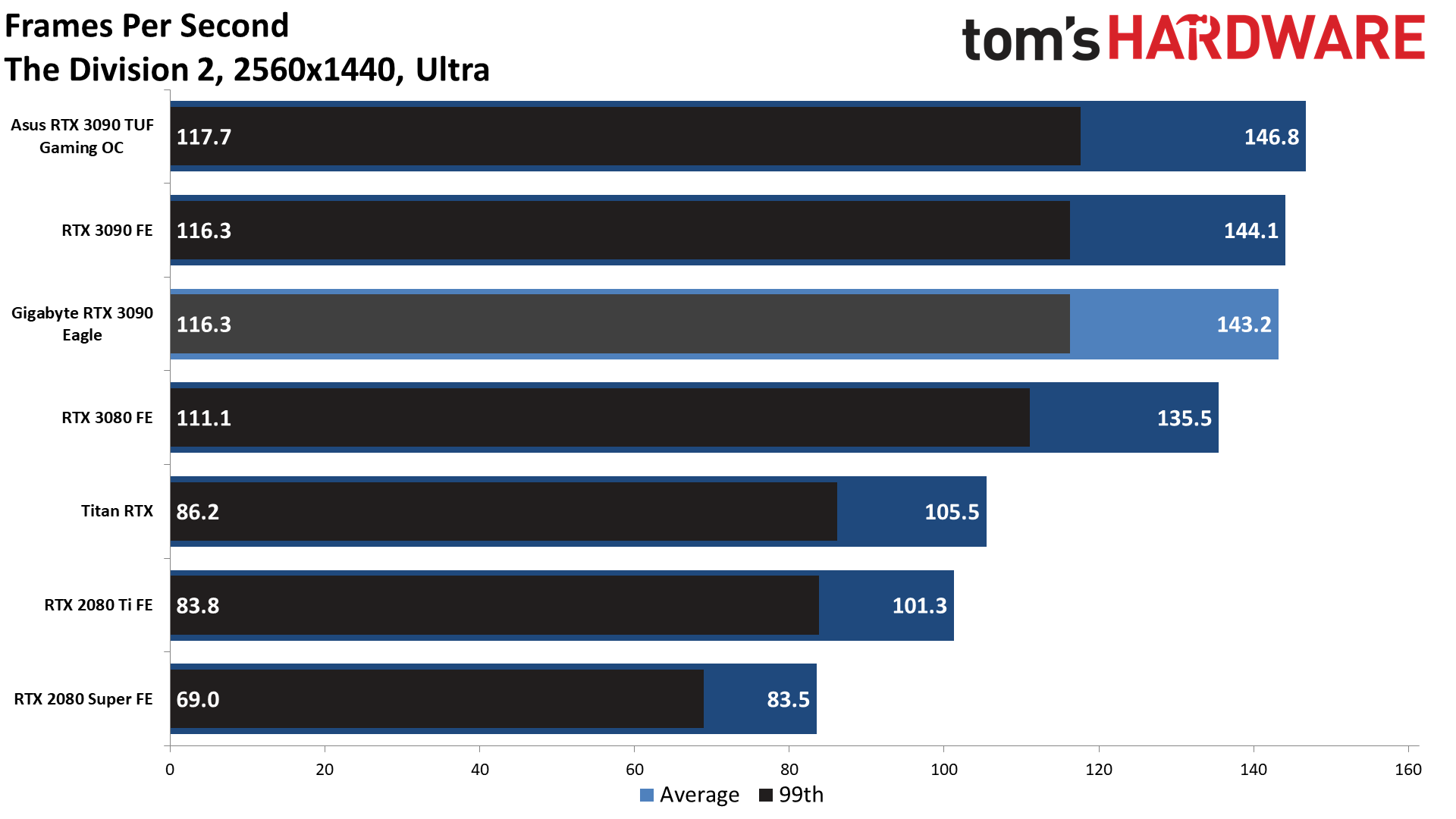
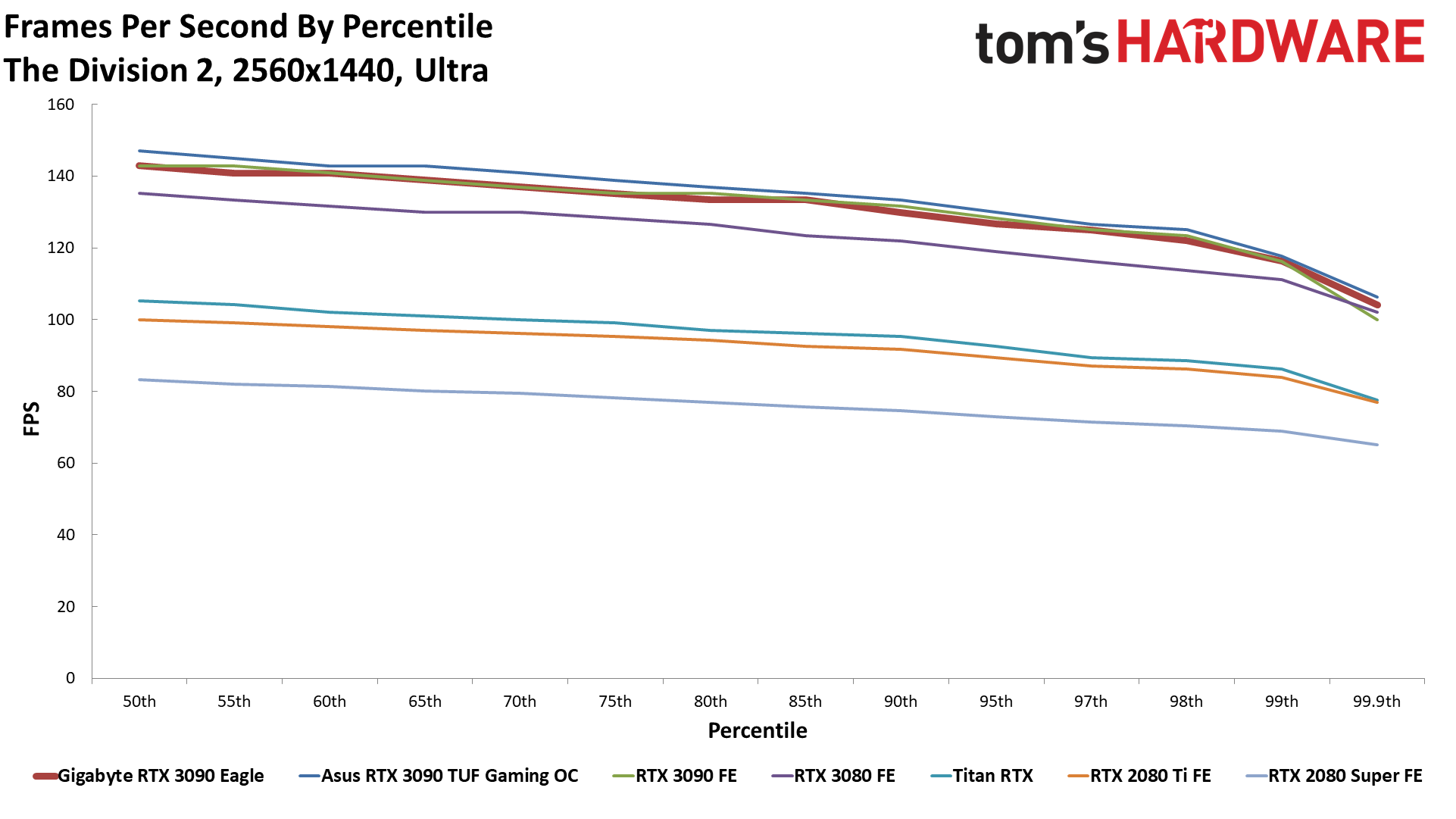
Far Cry 5
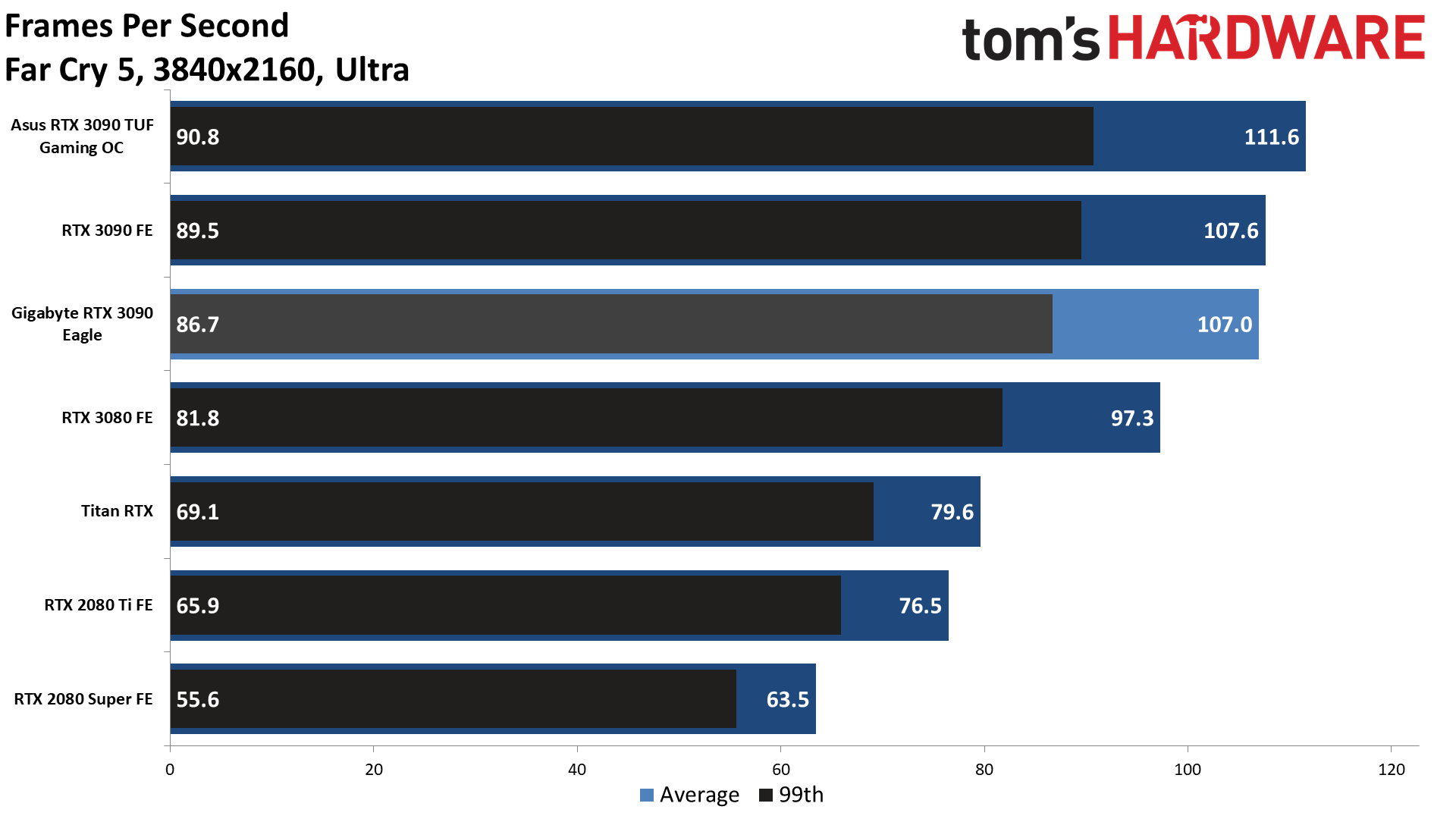
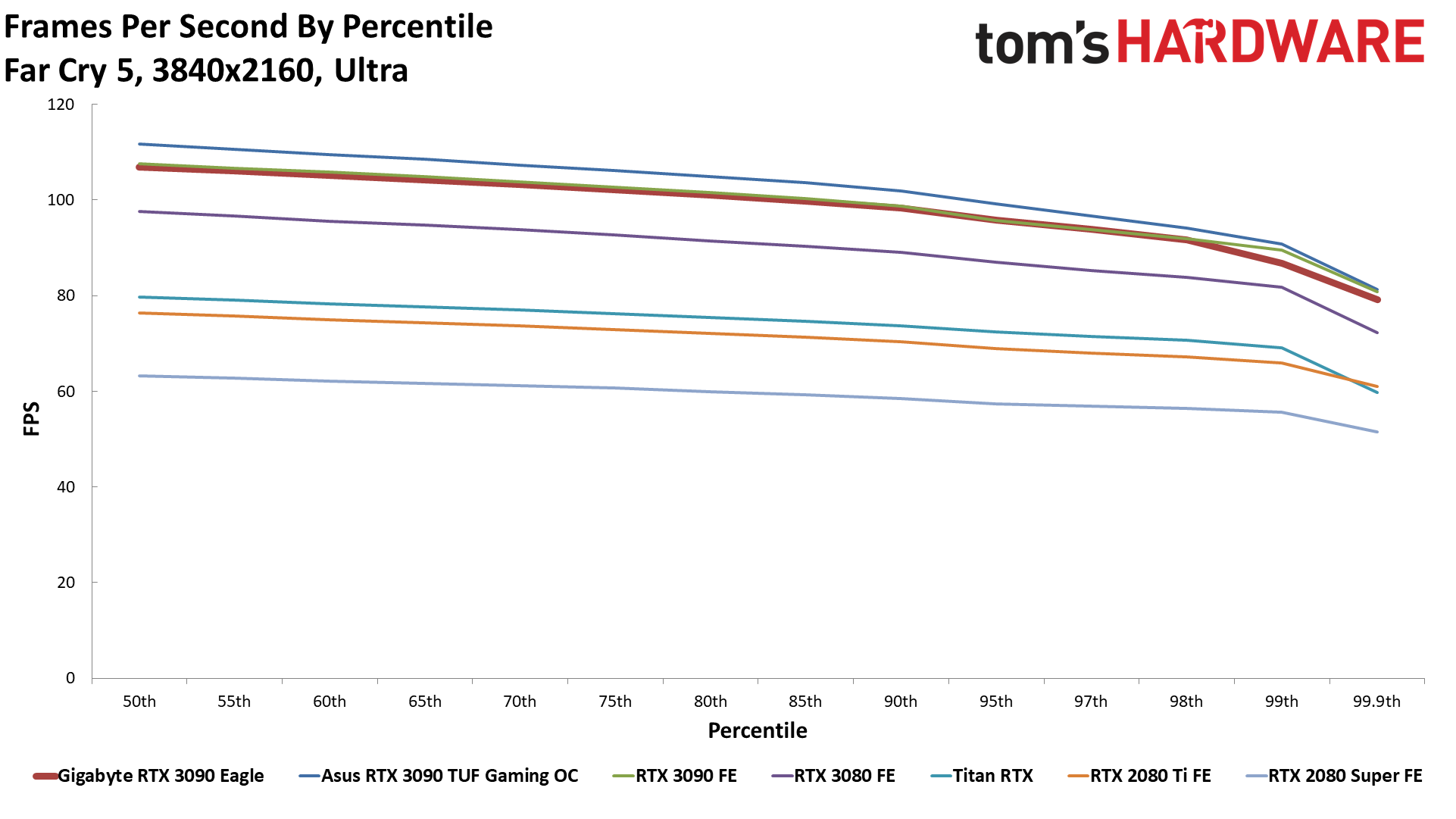
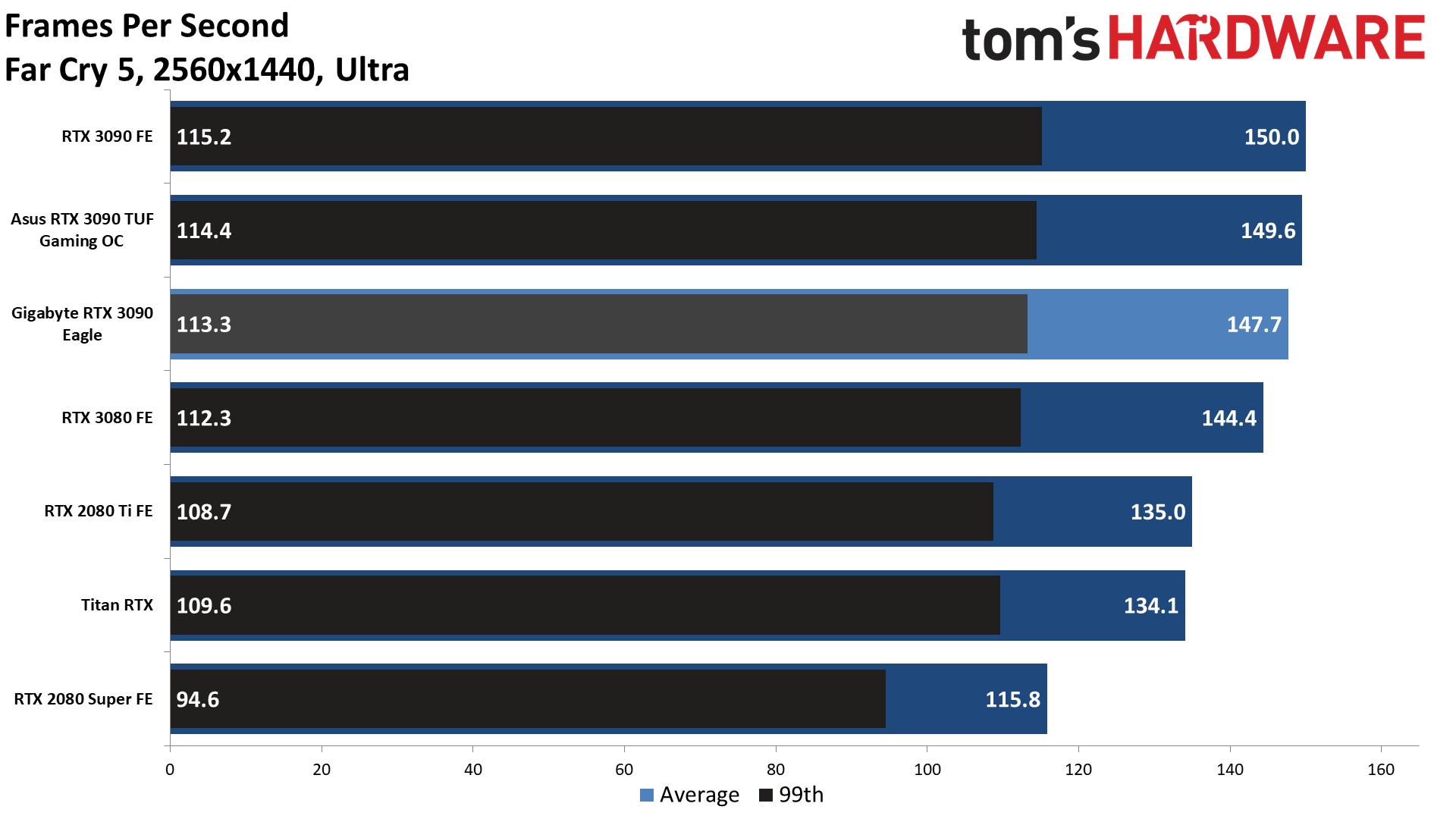
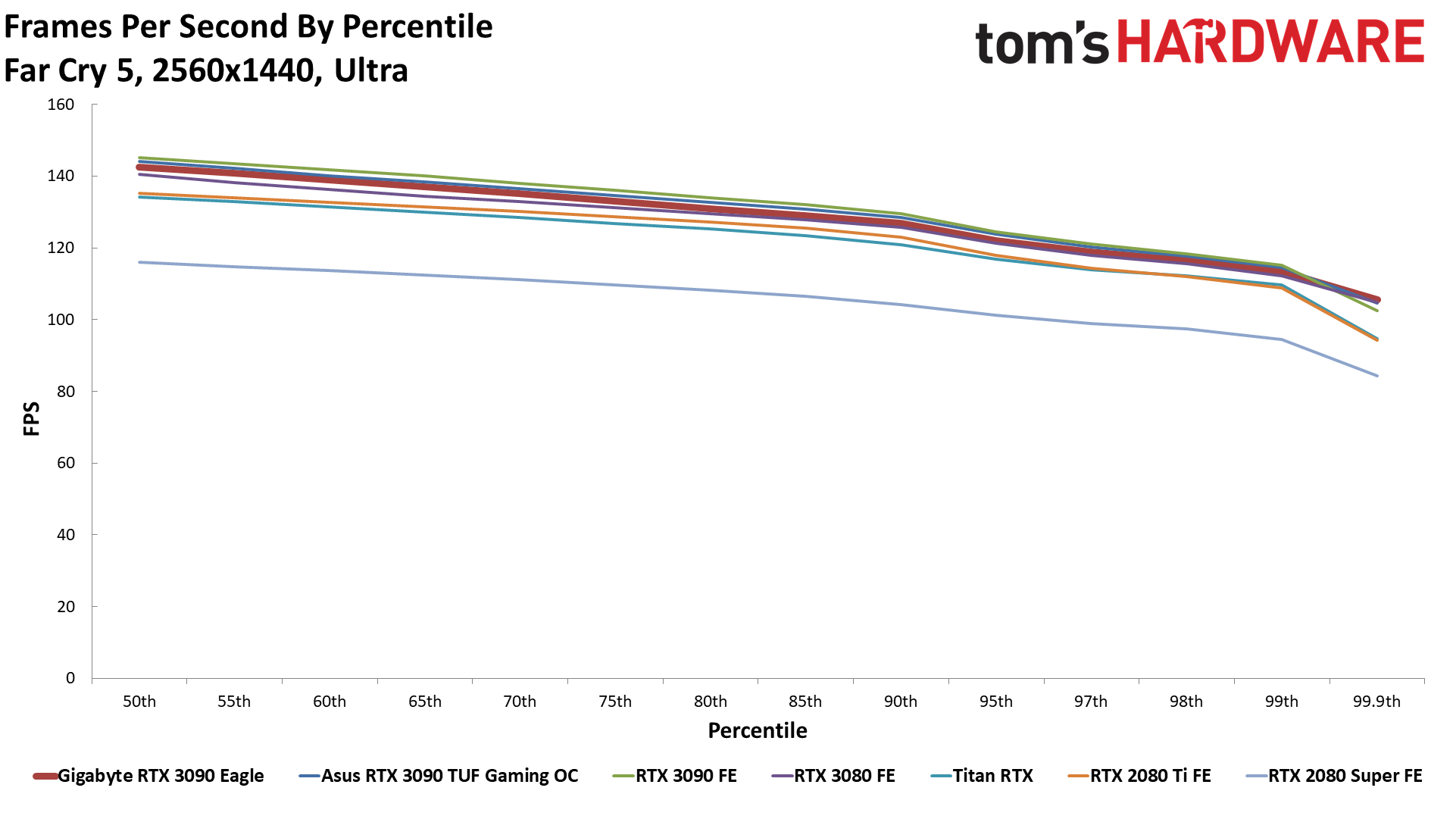
Final Fantasy XIV
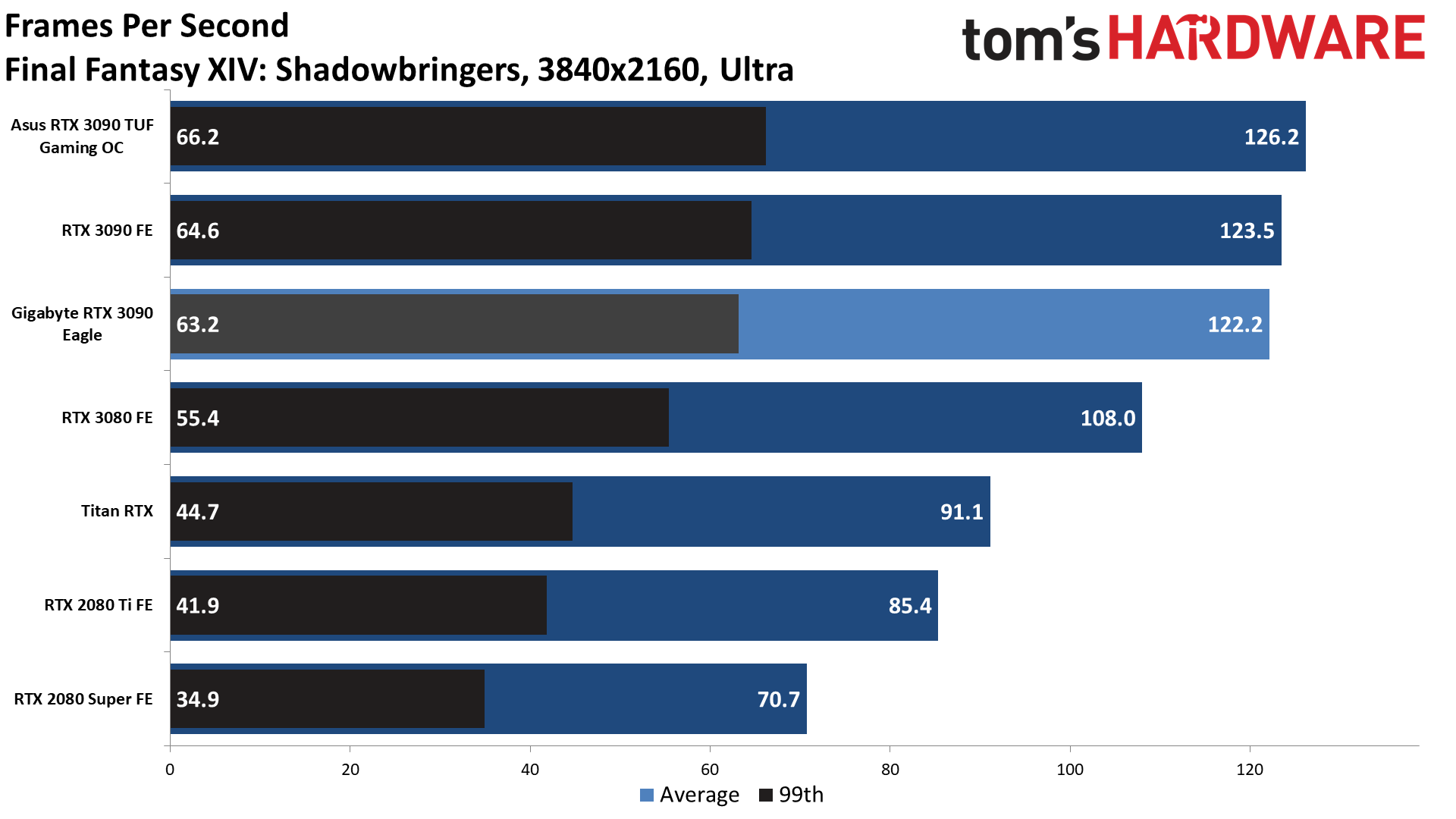
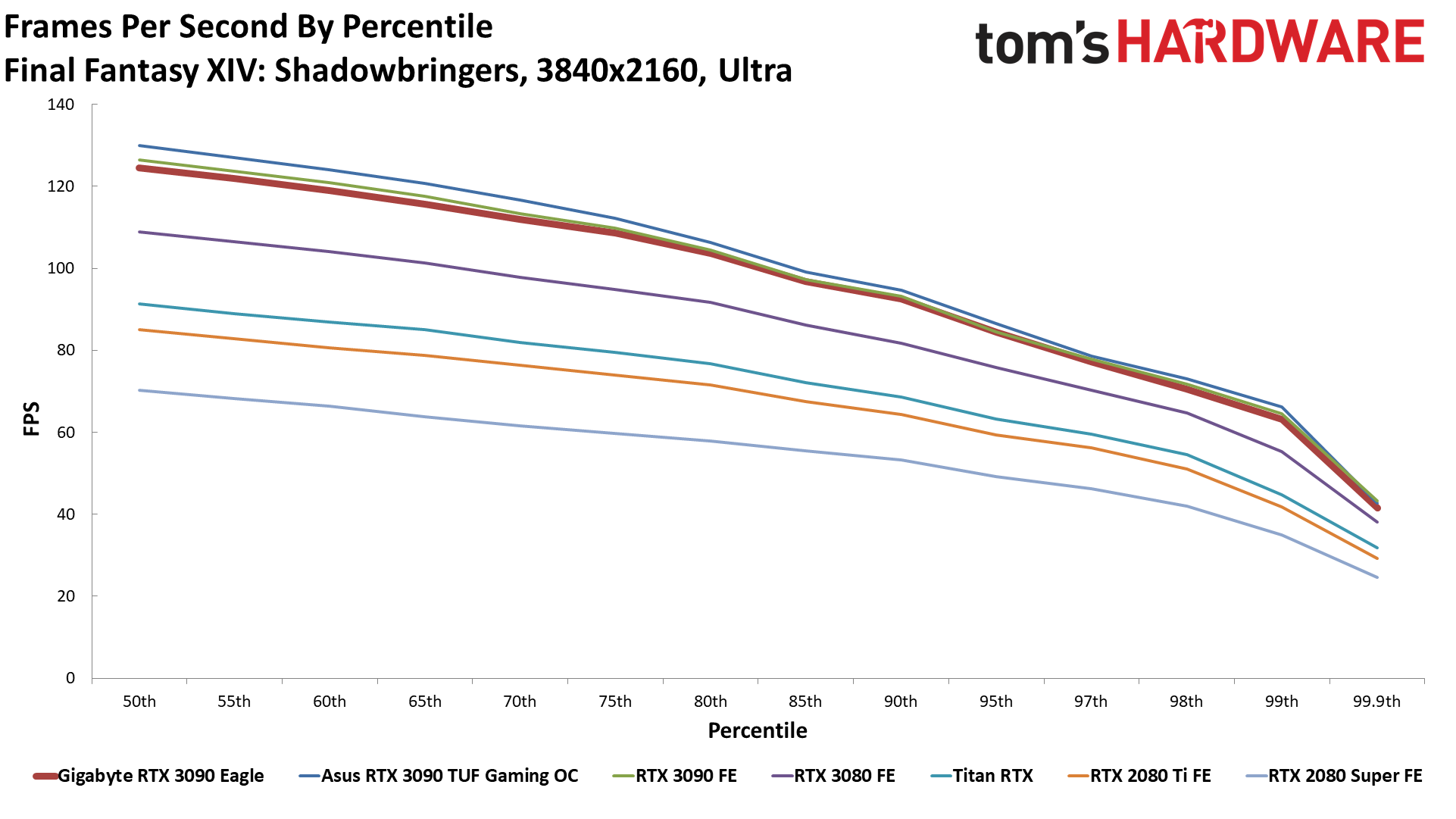
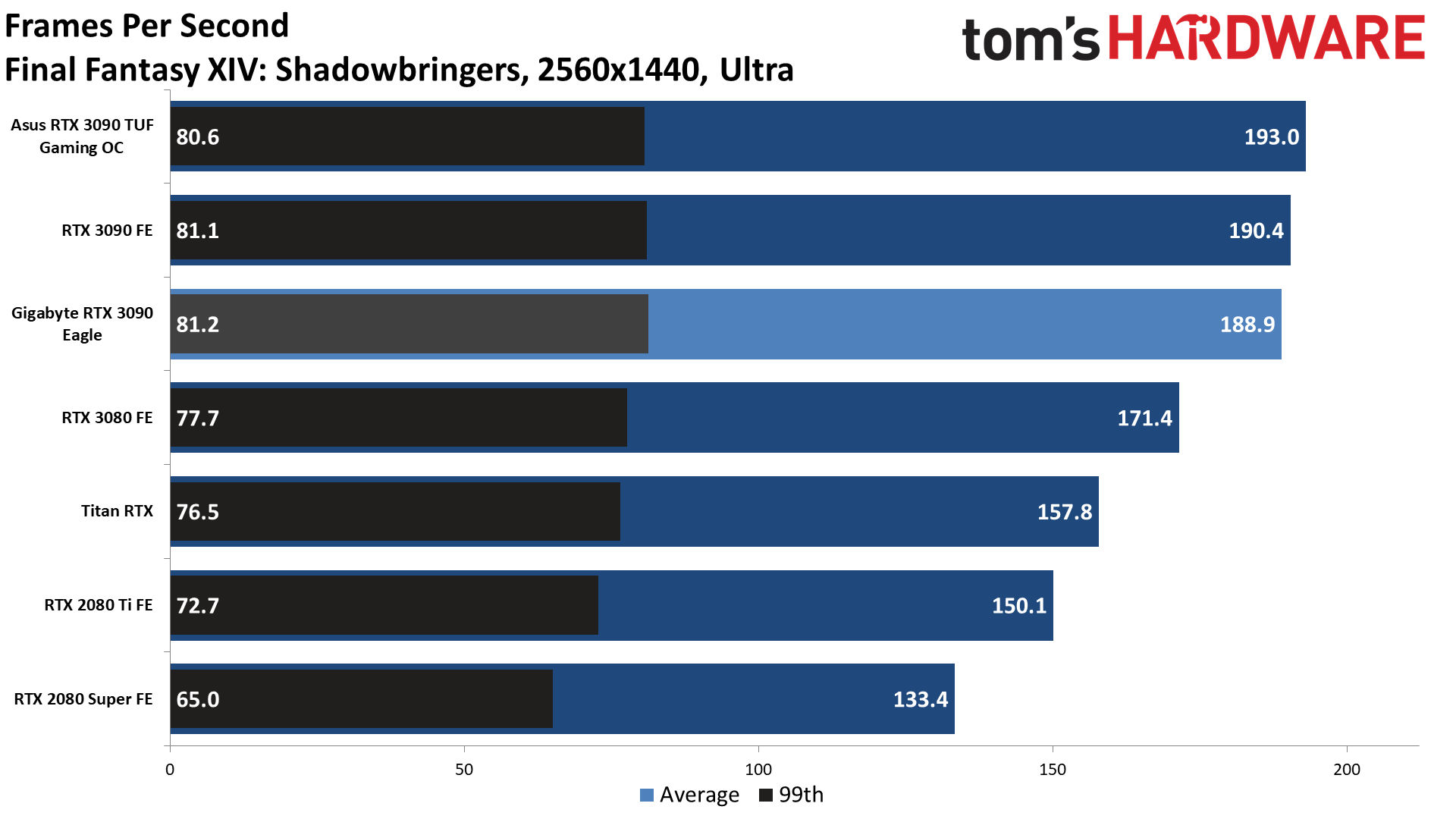
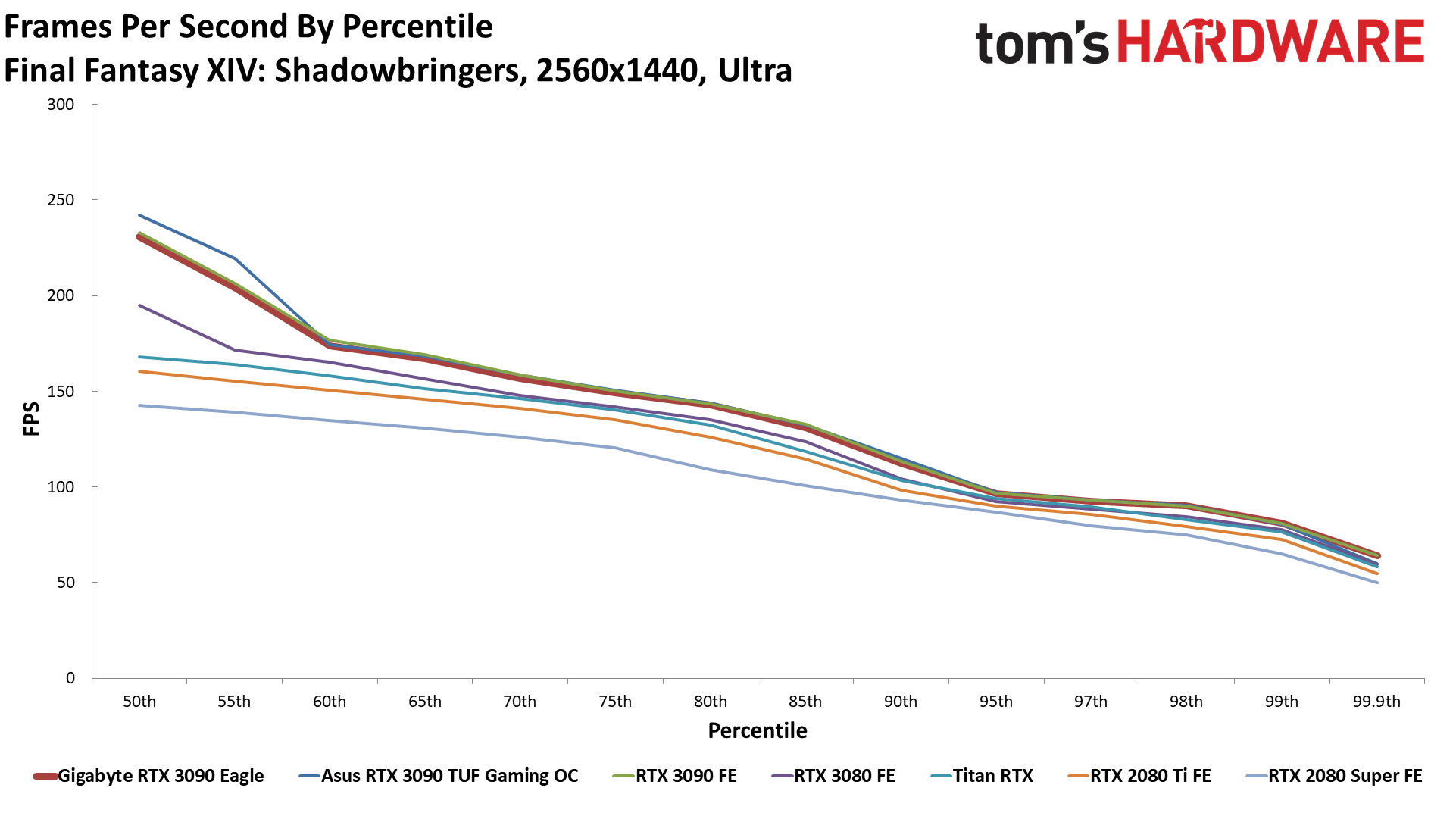
Forza Horizon 4
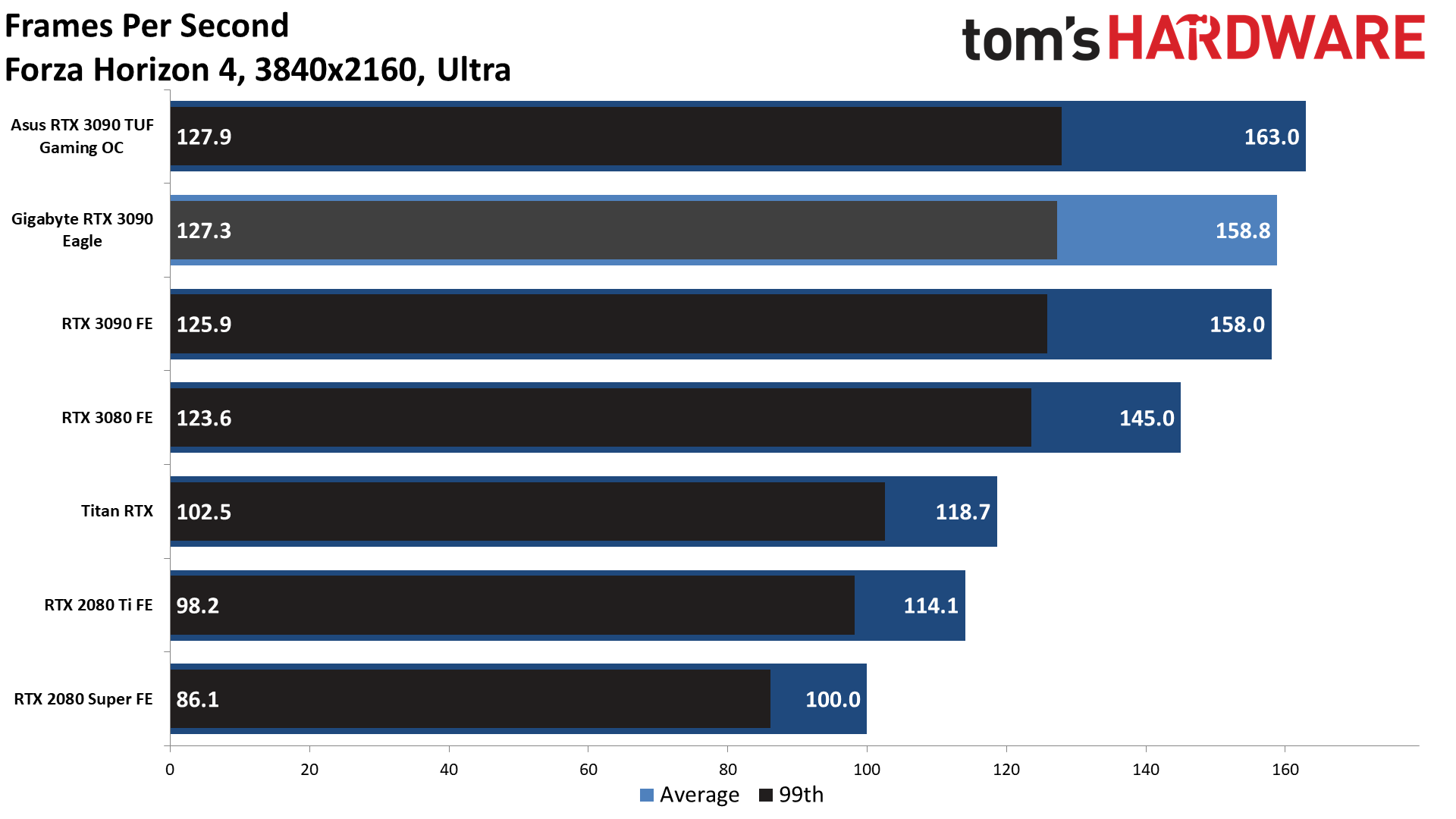
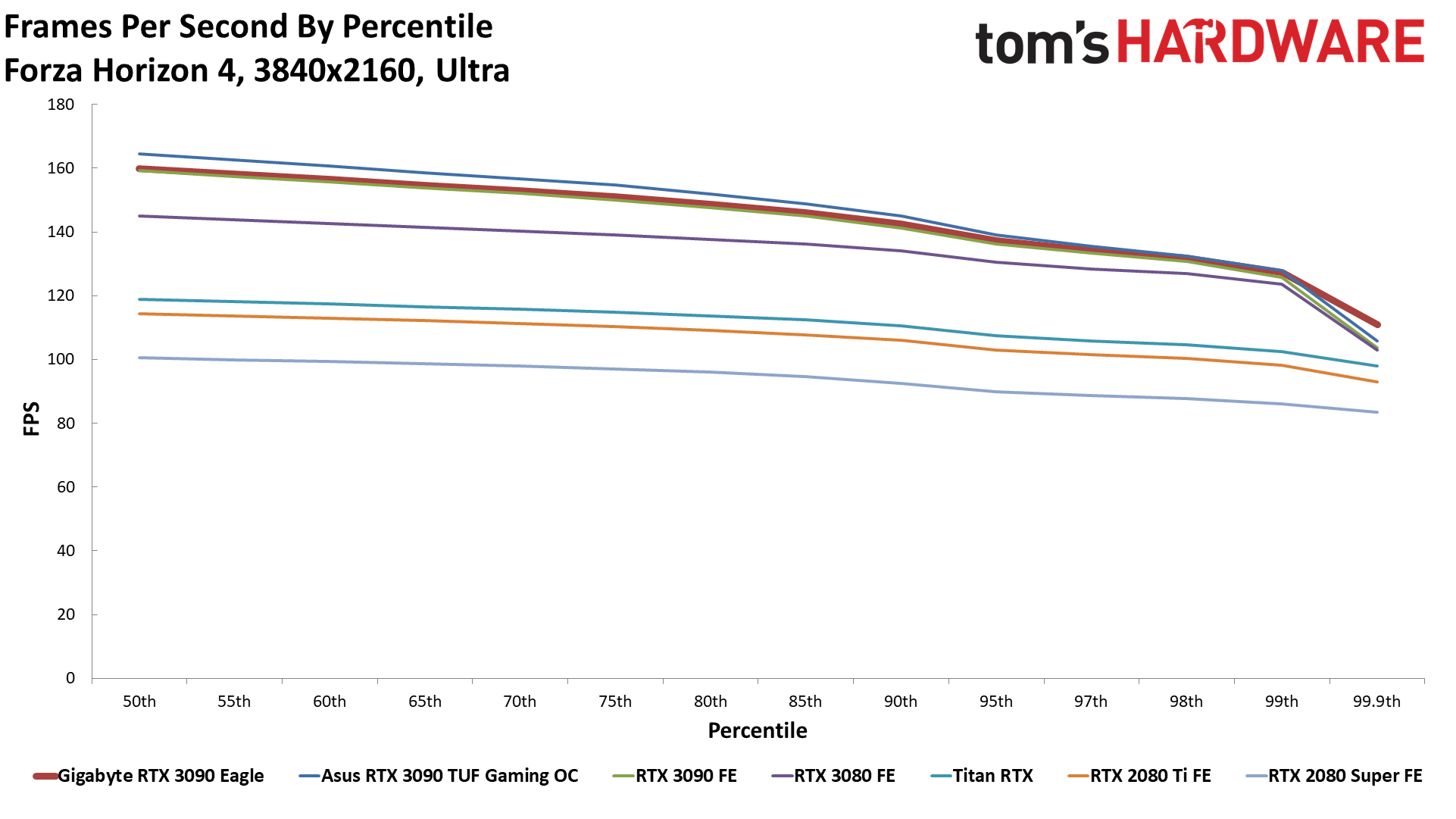
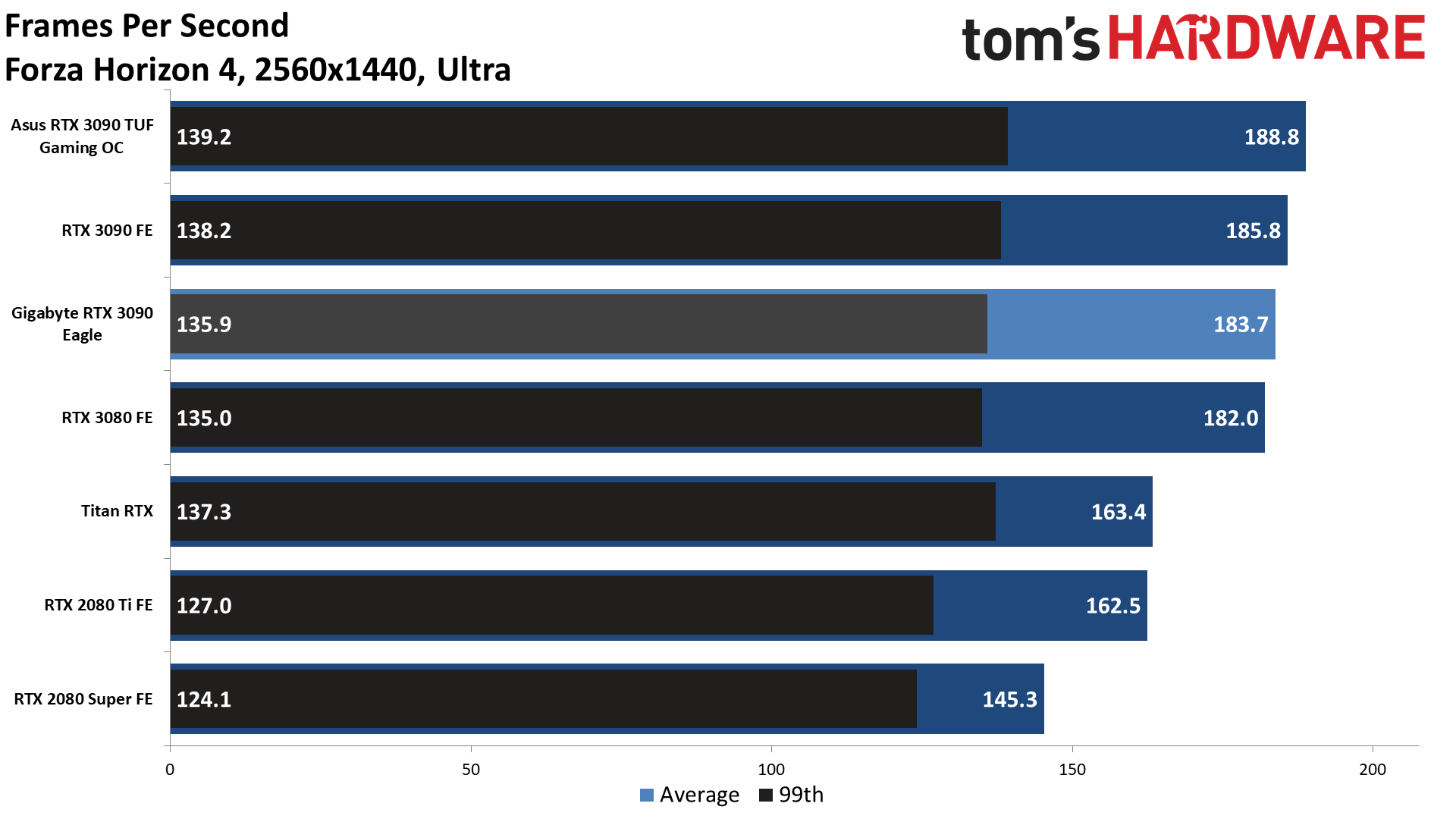
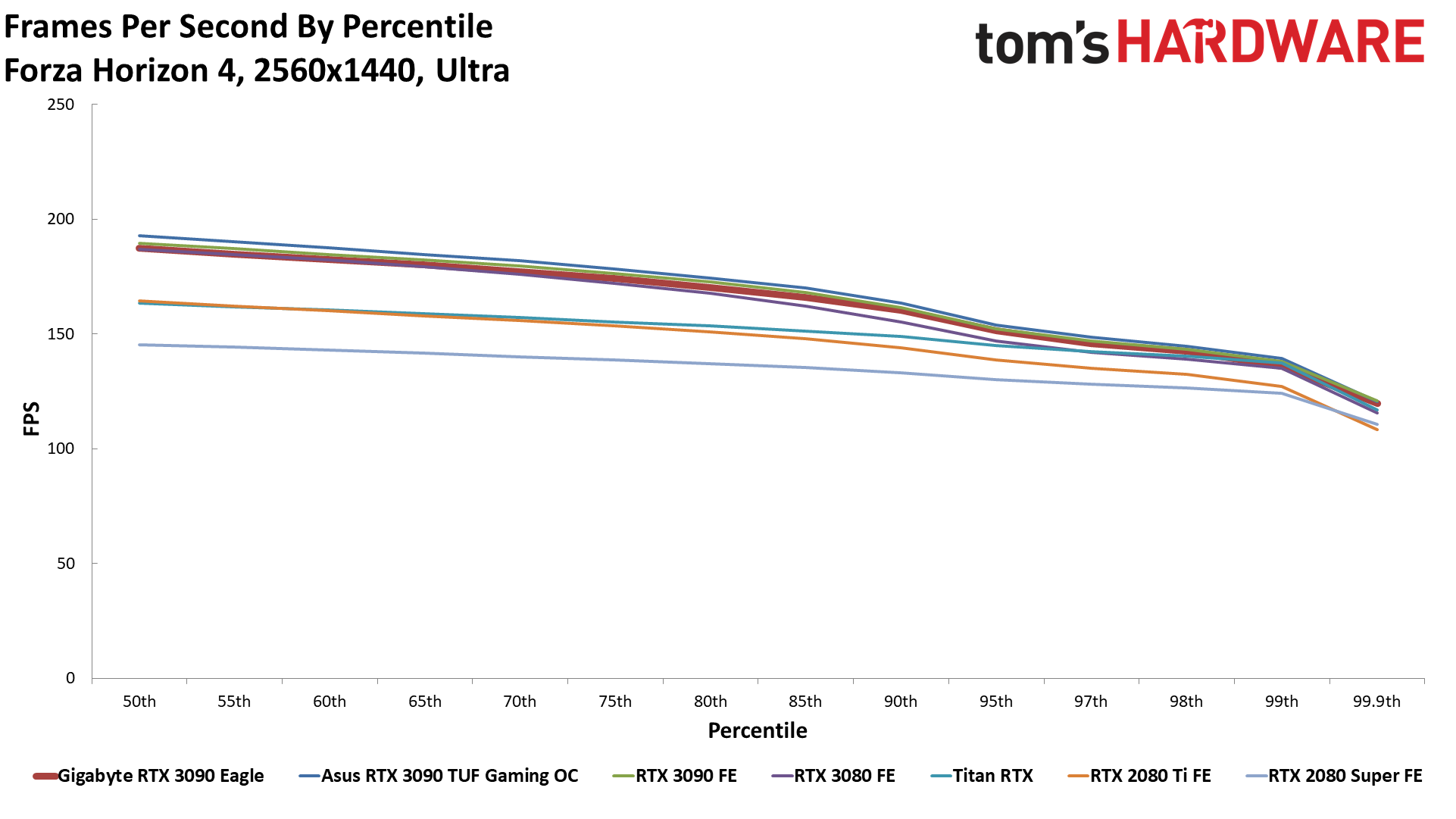
Metro Exodus
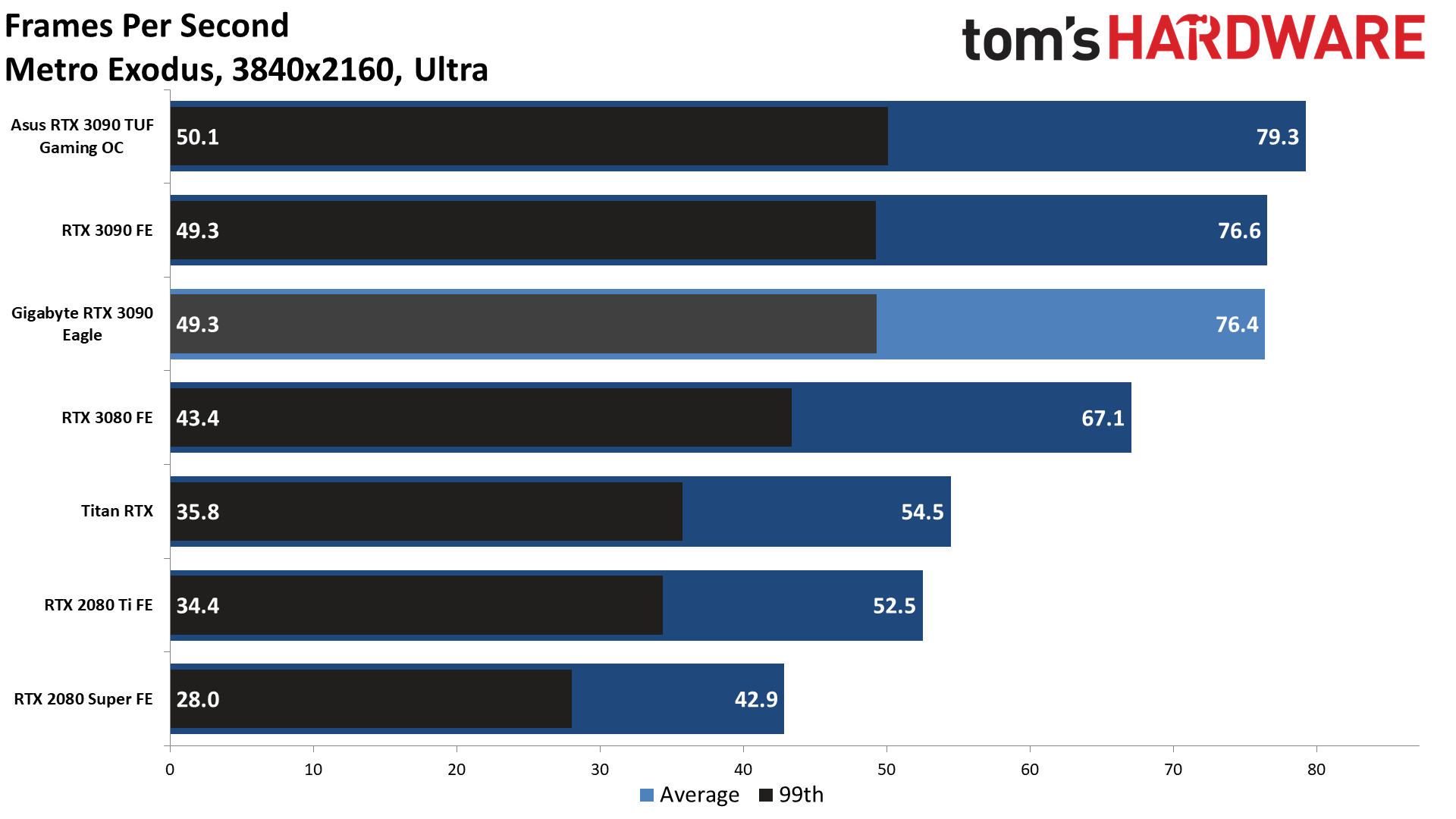
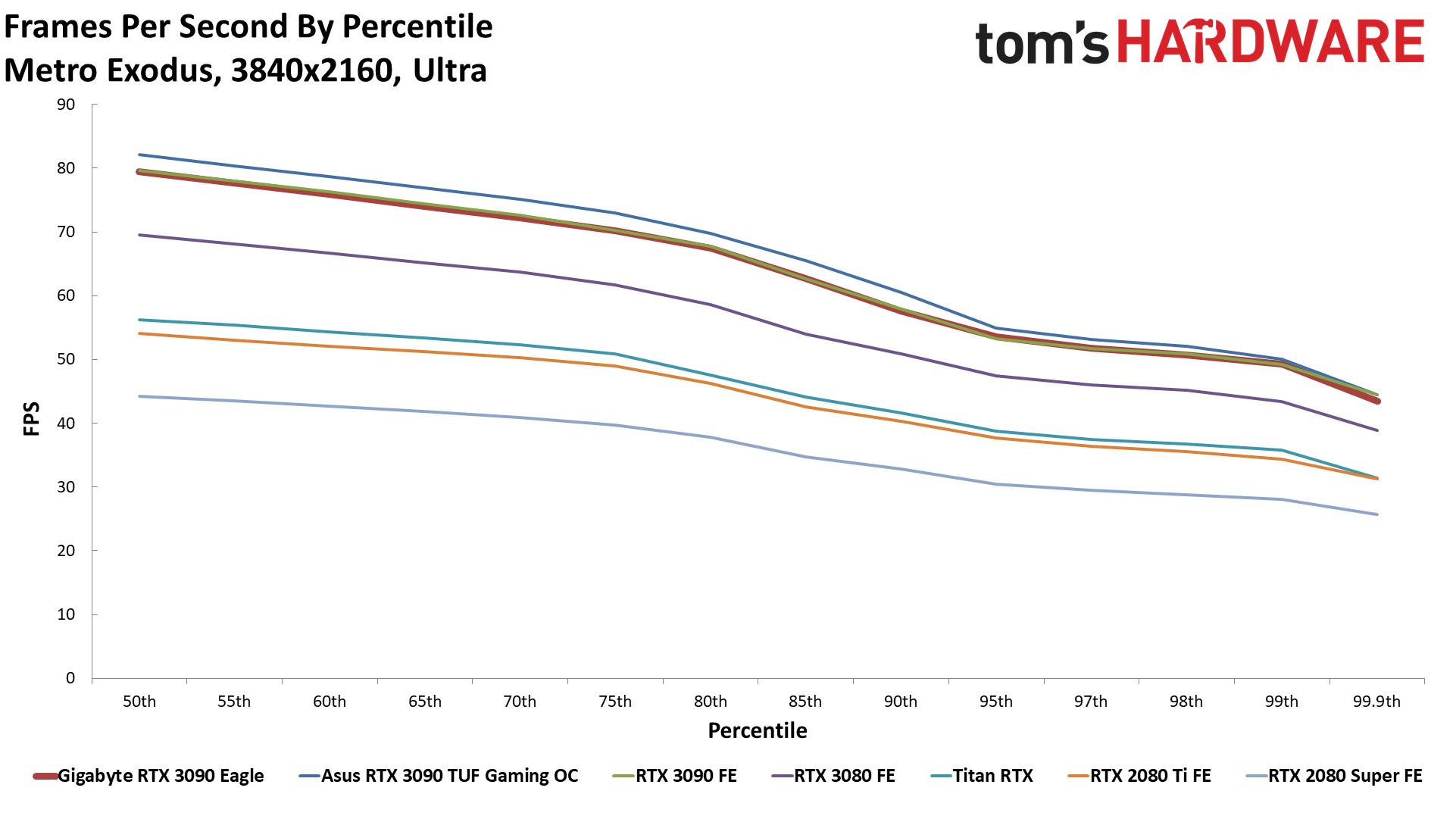
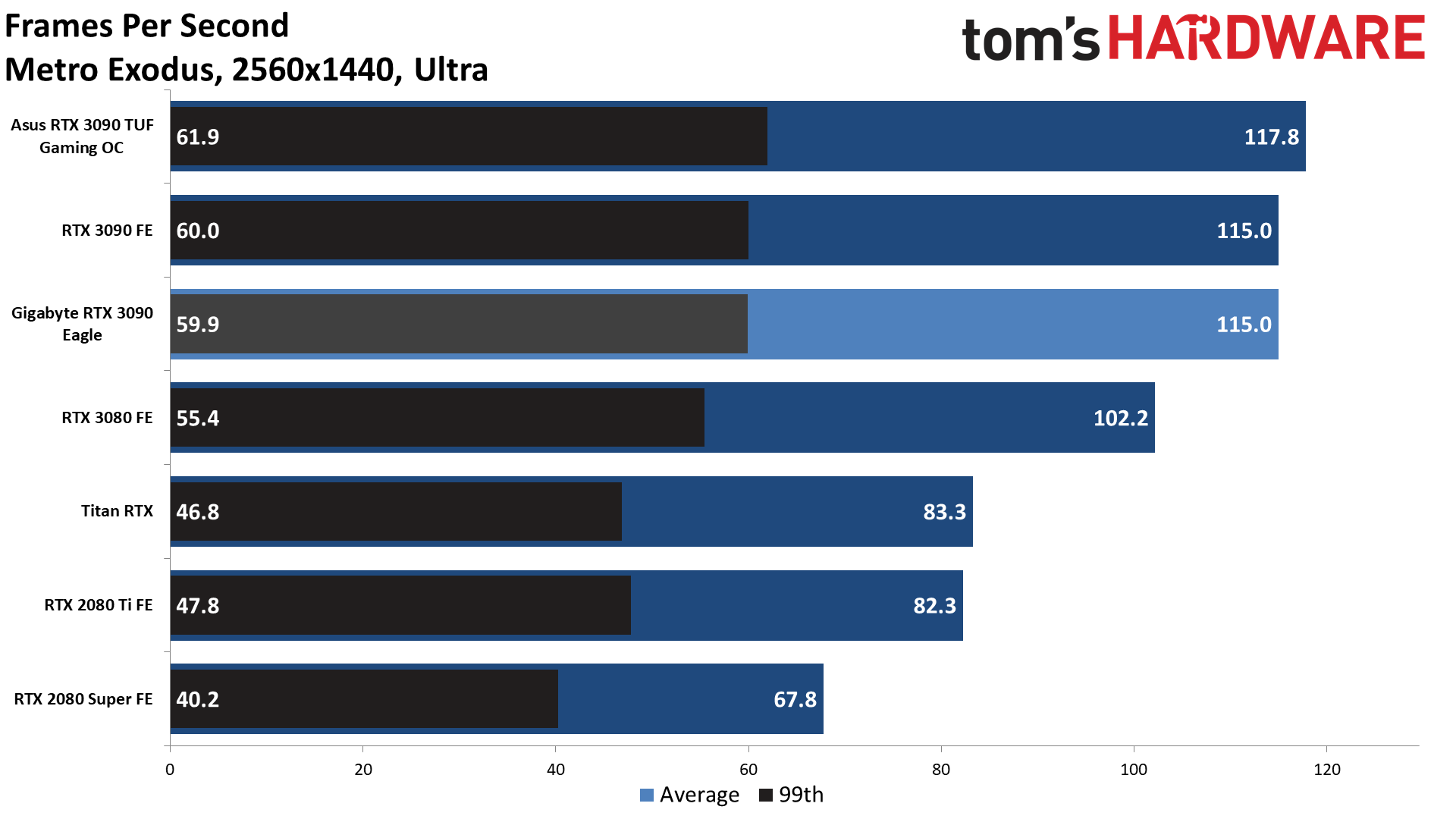
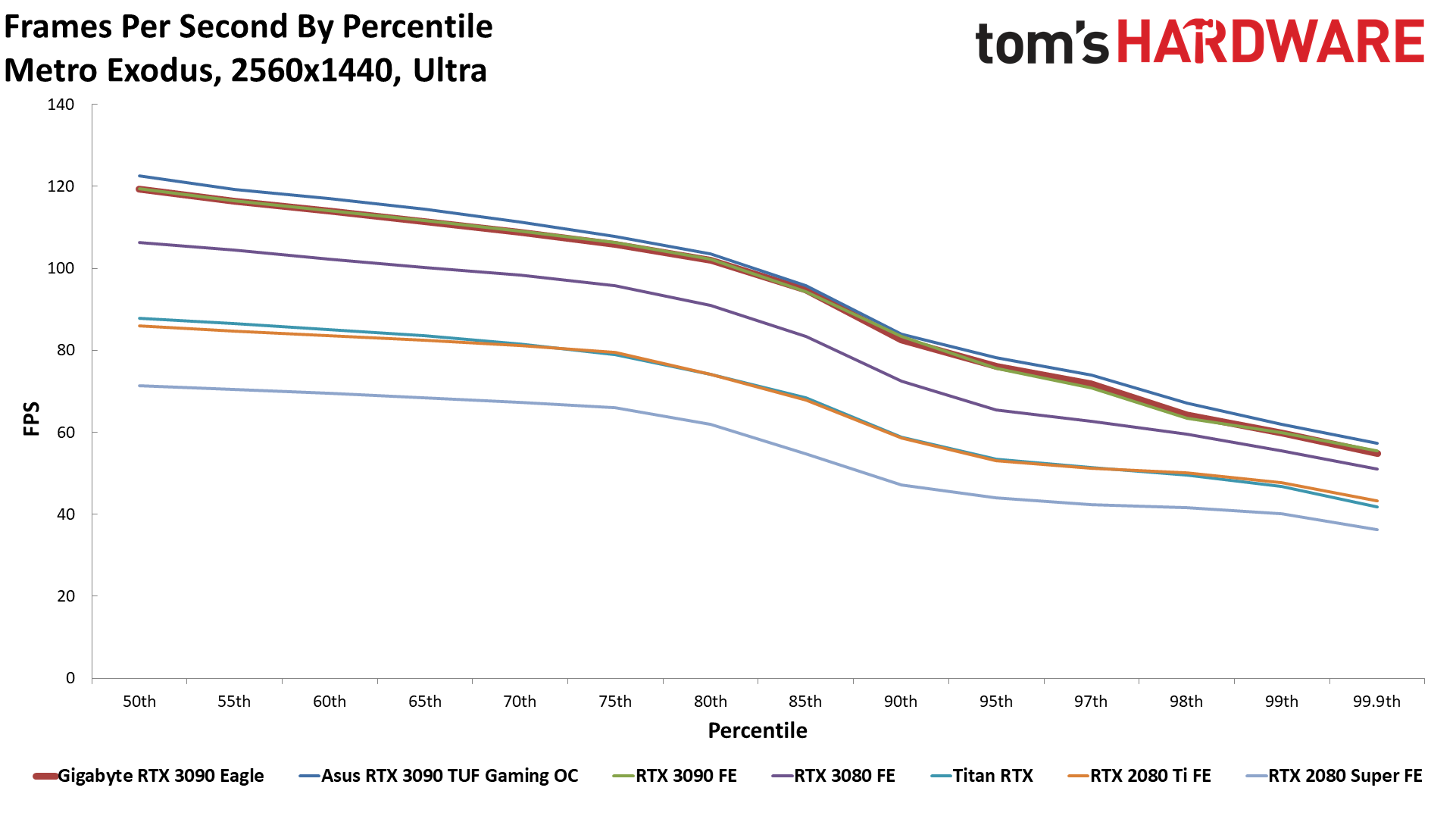
Red Dead Redemption 2
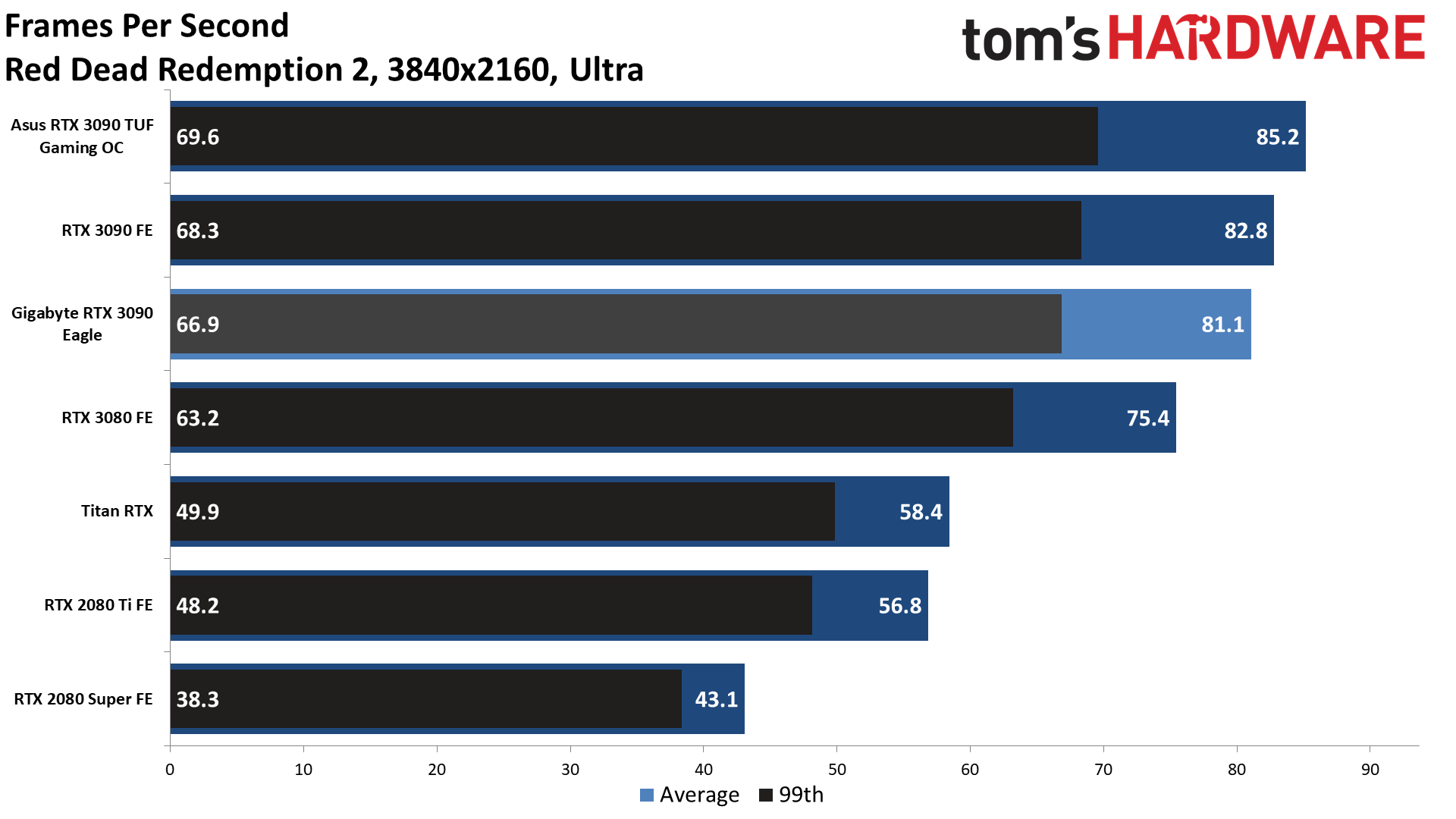
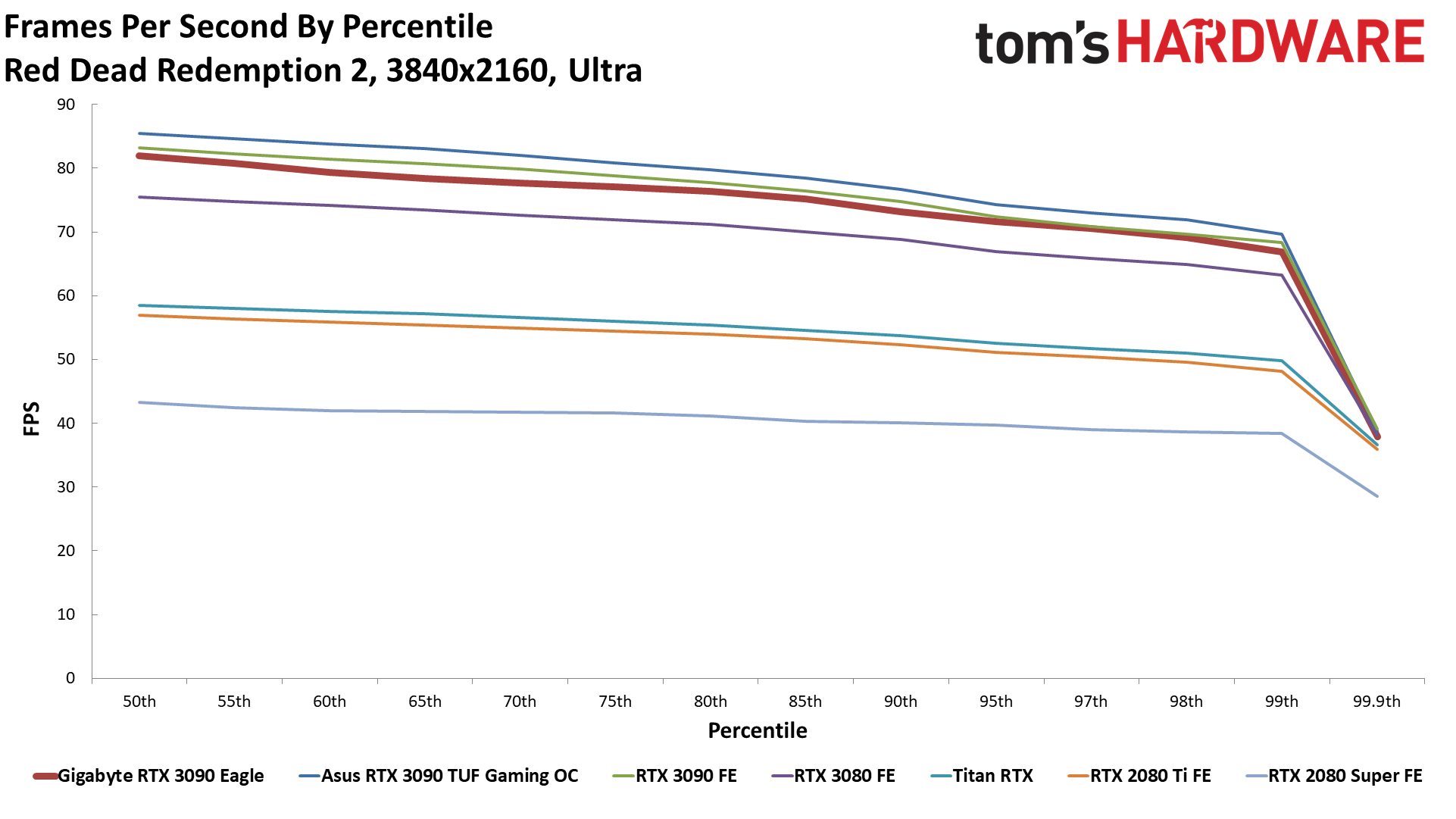
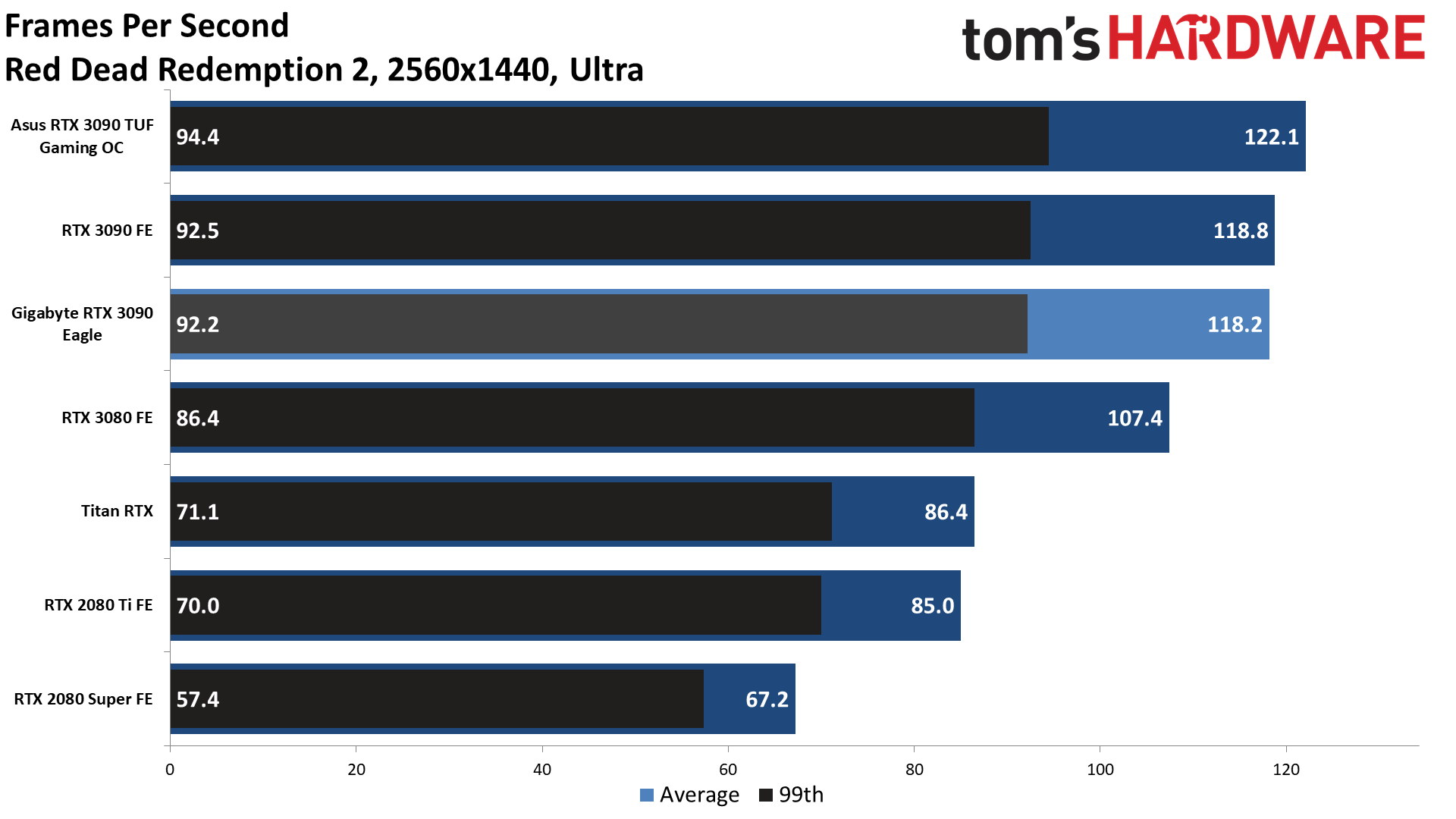
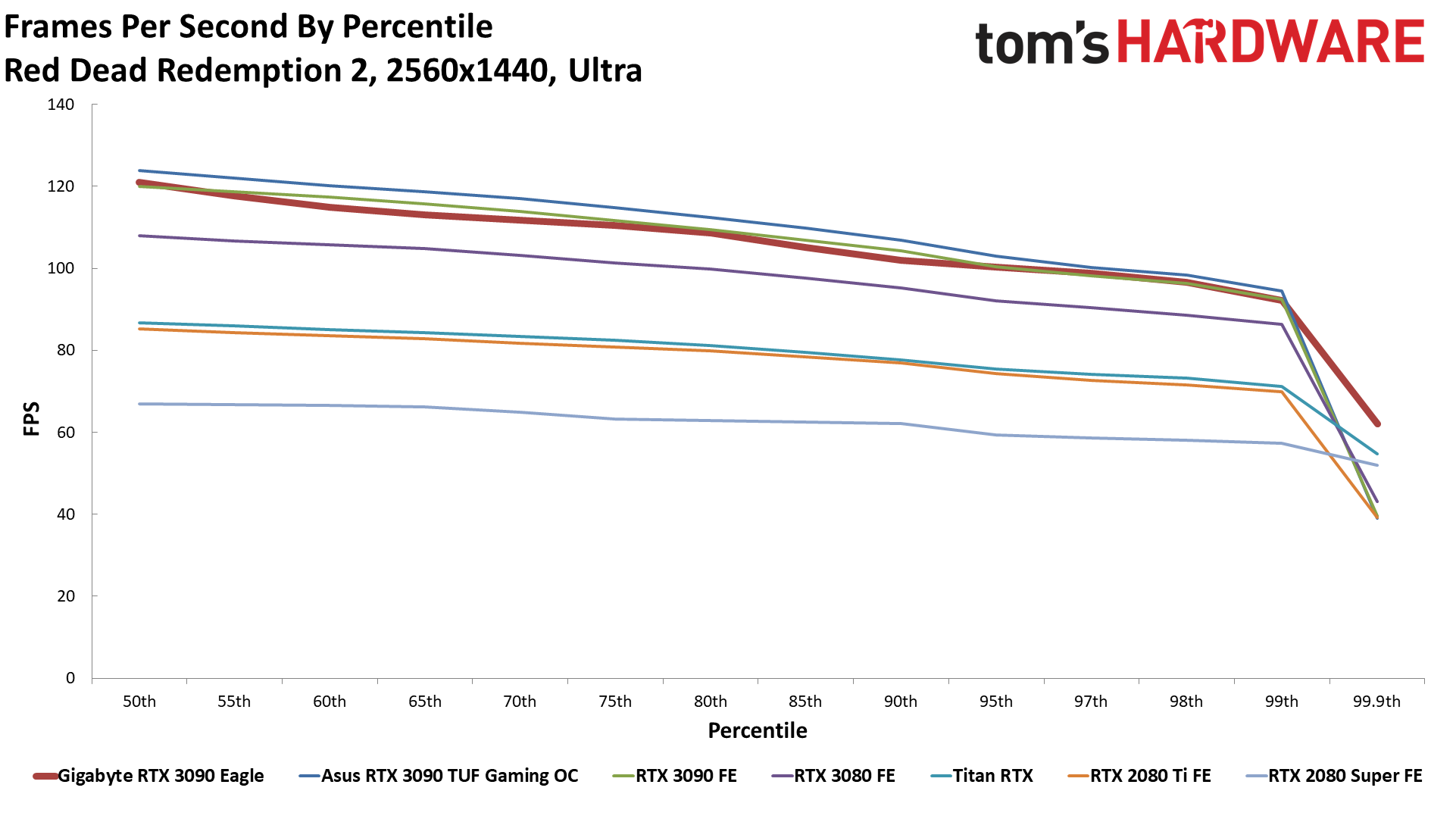
Shadow Of The TombRaider
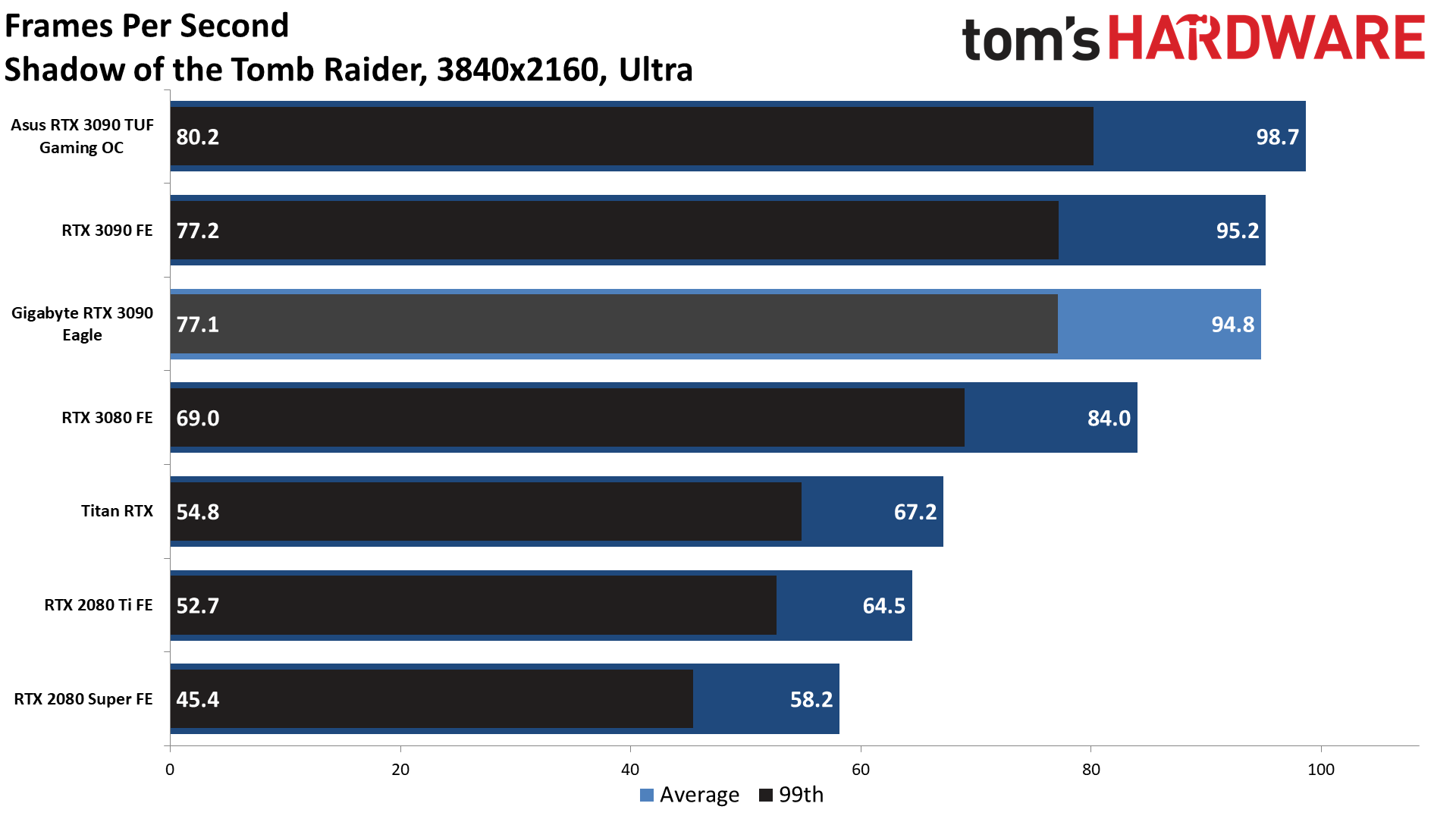
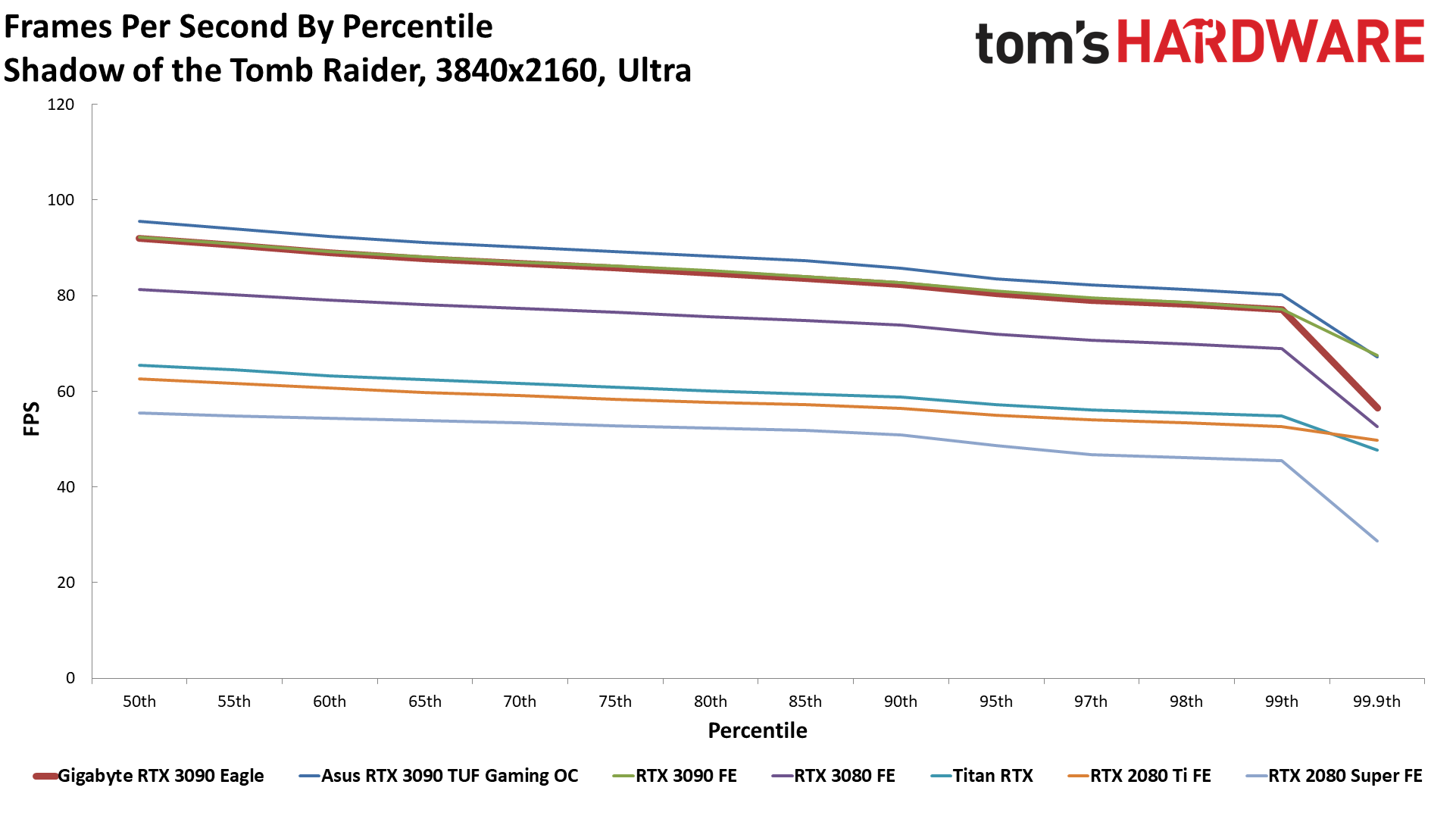
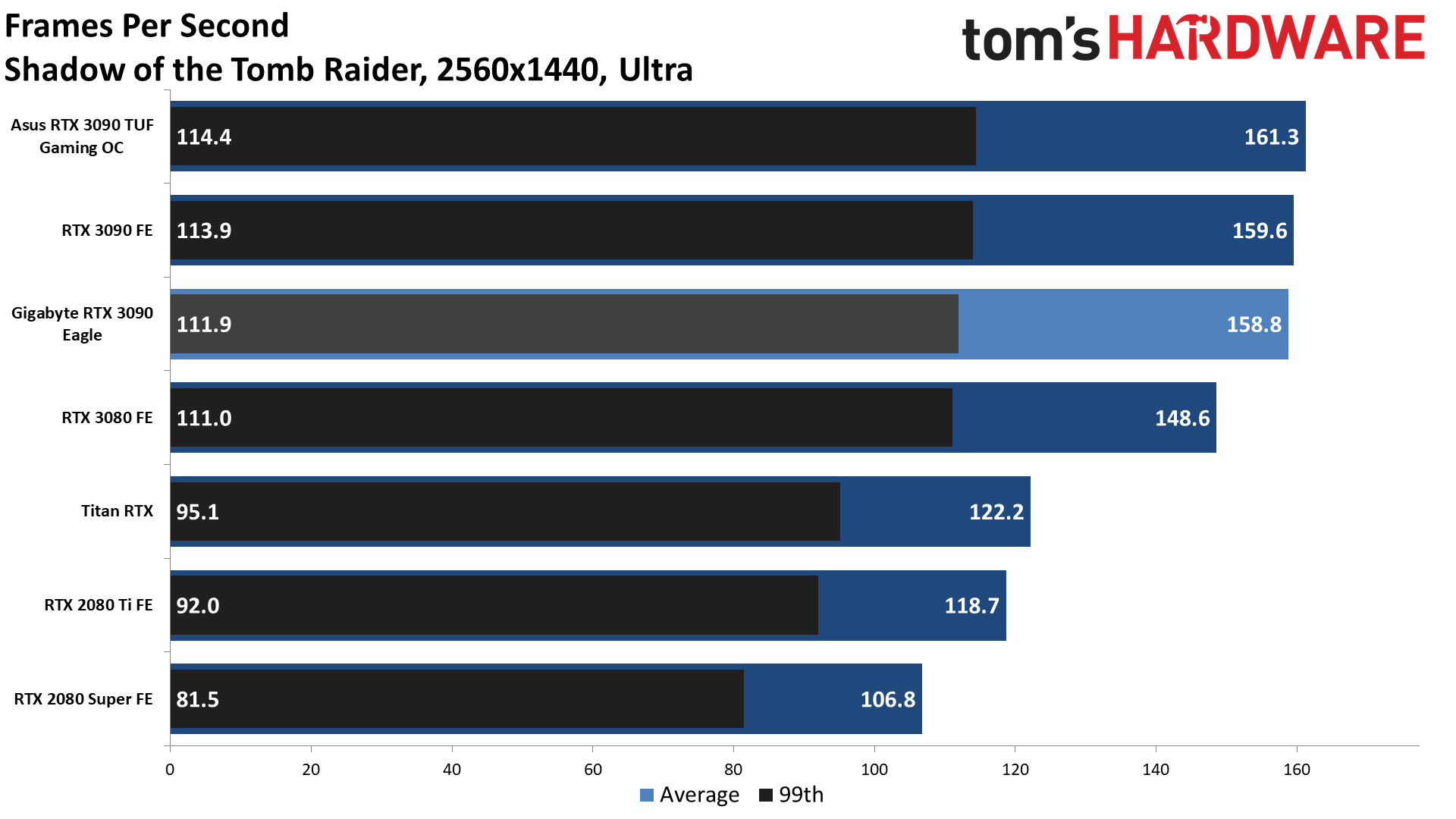
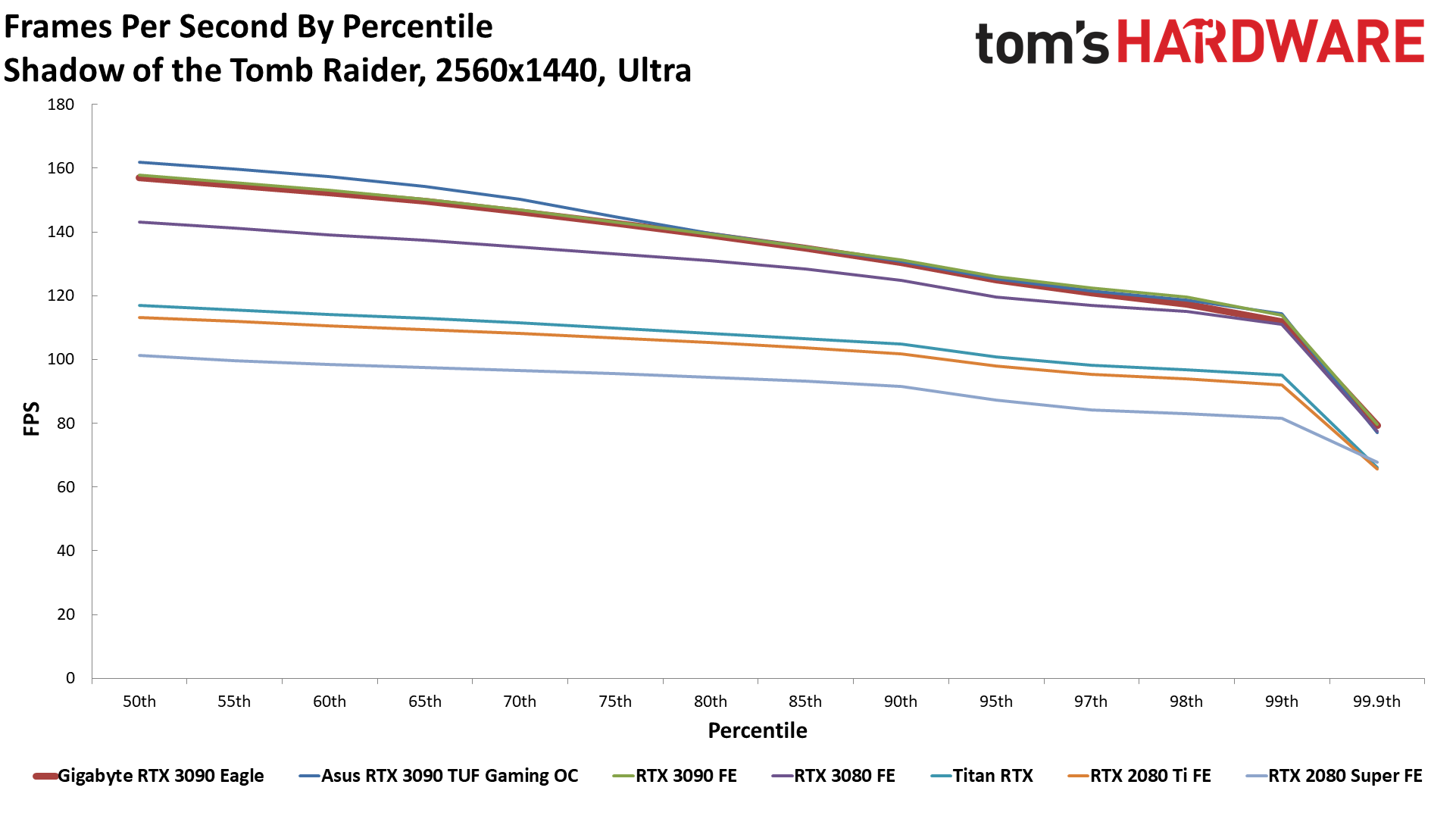
Strange Brigade
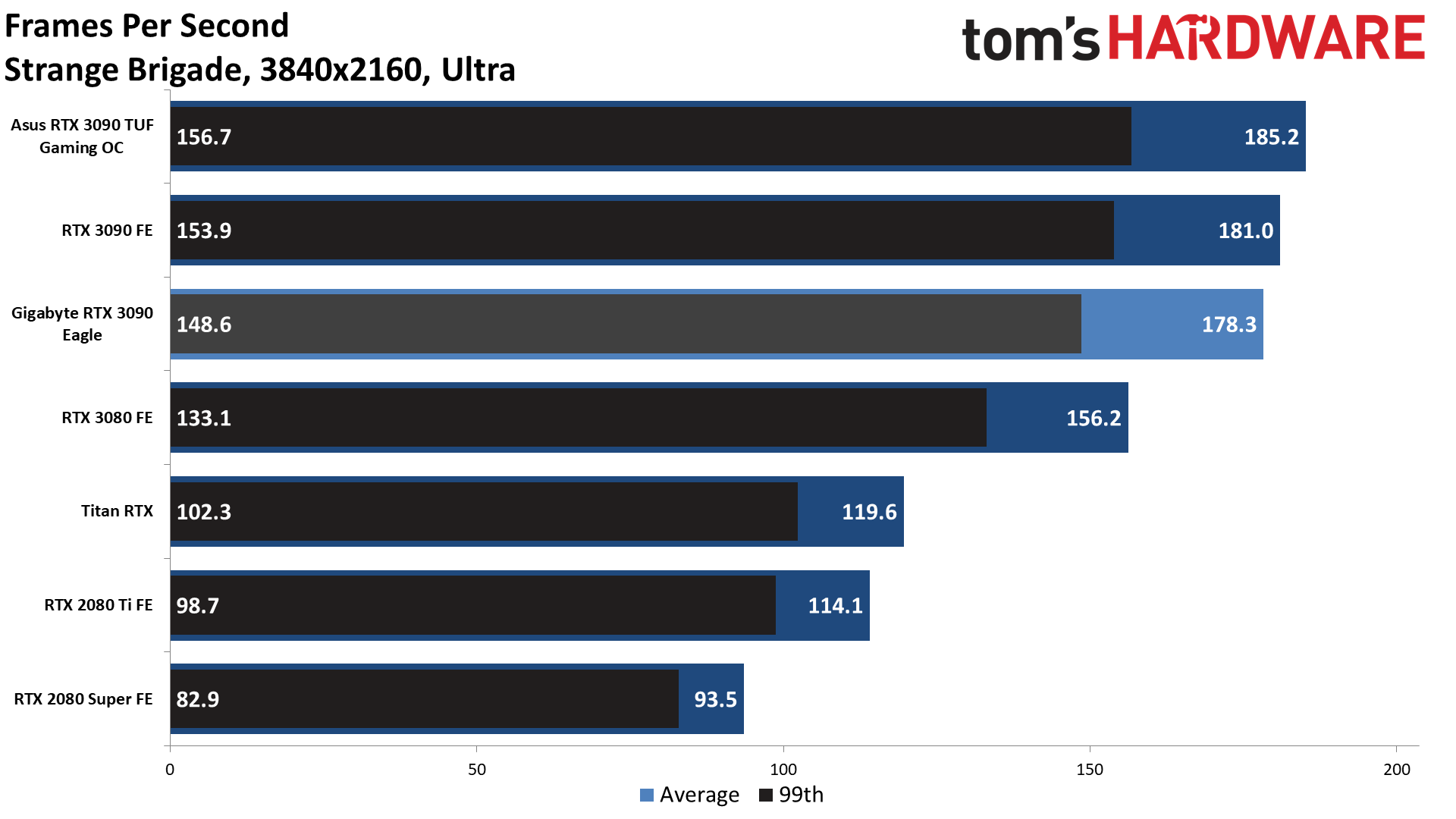
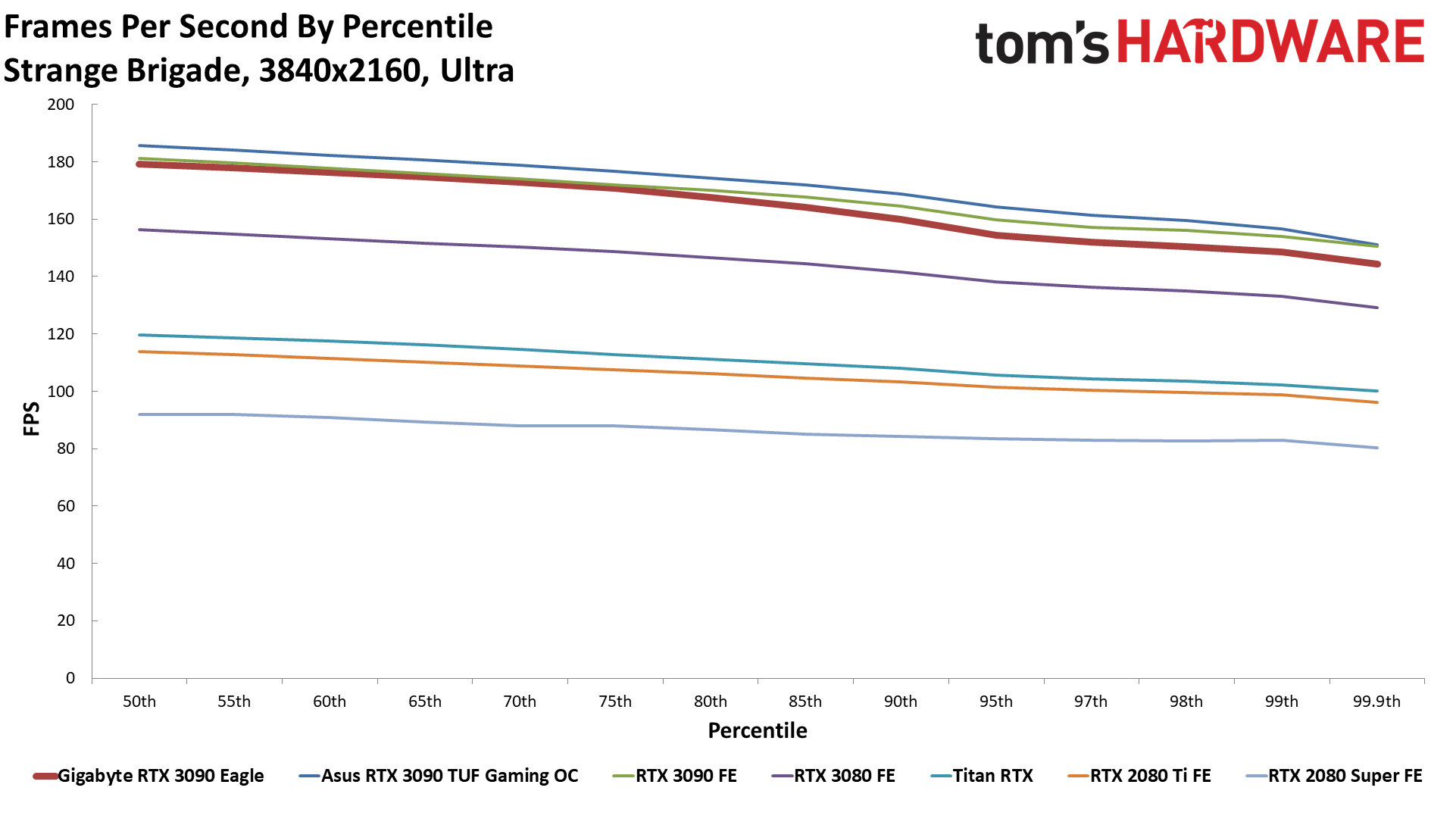
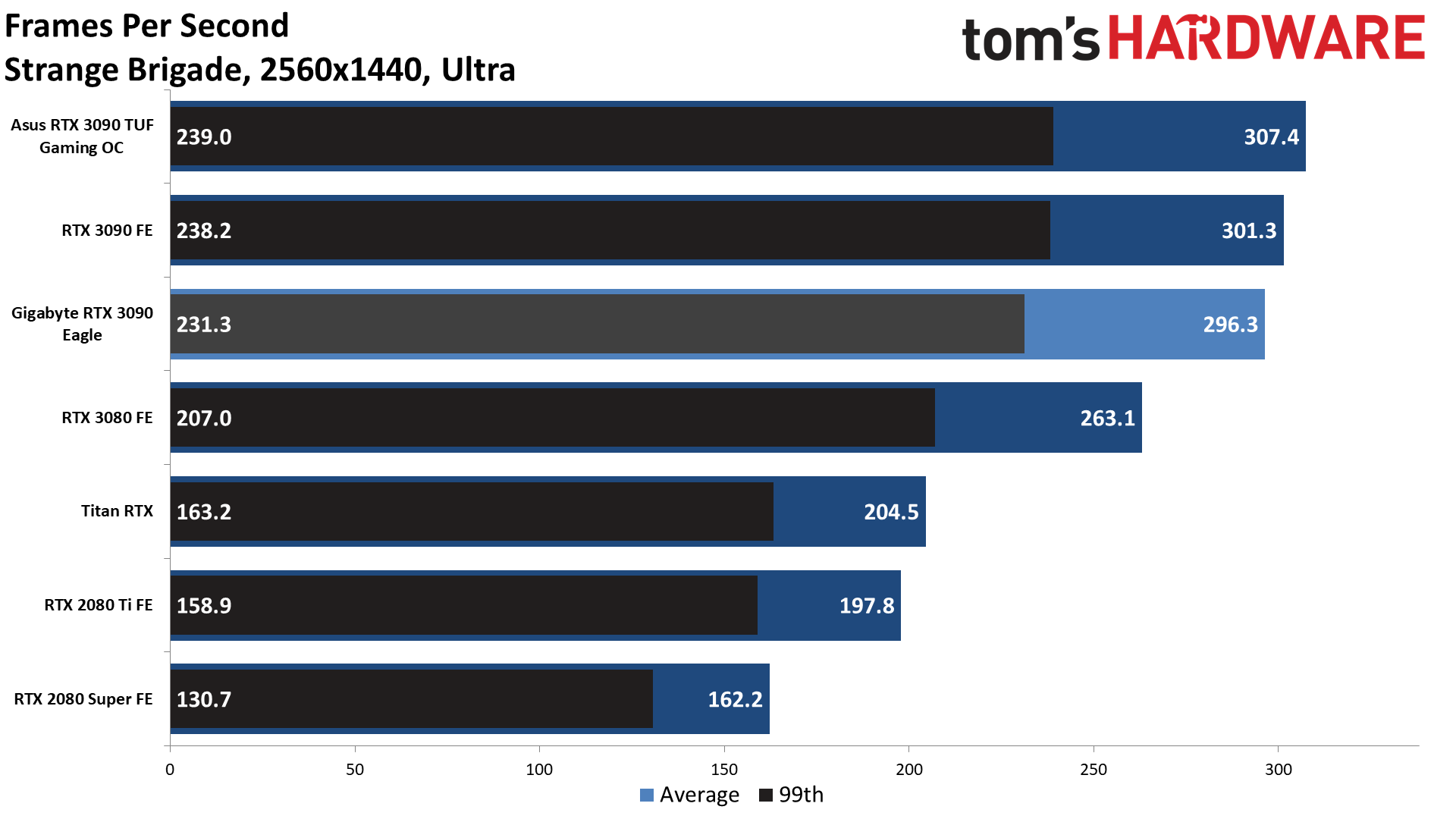
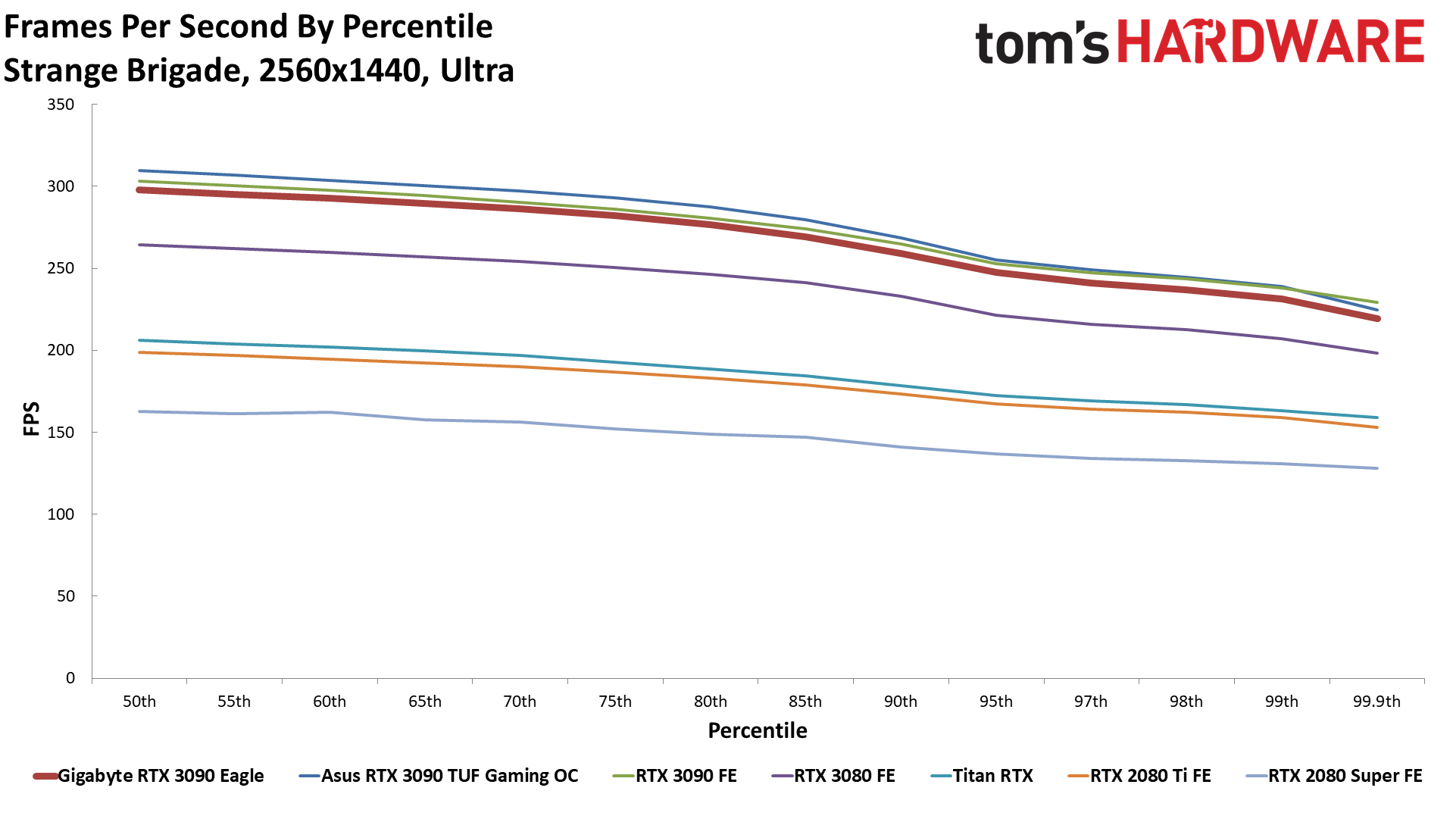
There's about a 1% margin of error in most gaming benchmarks, but we run each test multiple times to help minimize variance. Of the nine games tested, at two resolutions, the Gigabyte was just barely faster than the RTX 3090 FE in three cases, and those were basically tied. The remaining 15 data points favored the 3090 FE by 0-2%, with an average lead of 1% overall. It's nothing you'd notice in actual gaming, and at least the cards have the same price (or will when supply manages to catch up to demand).
Gigabyte RTX 3090 Eagle: Power, Temps, Fan and Clock Speeds, and Noise
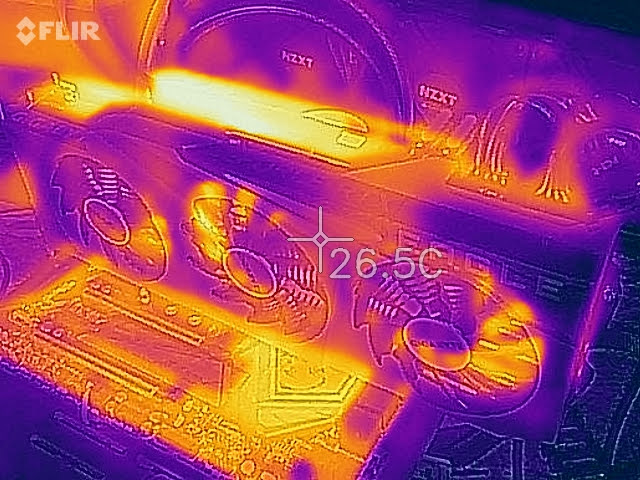
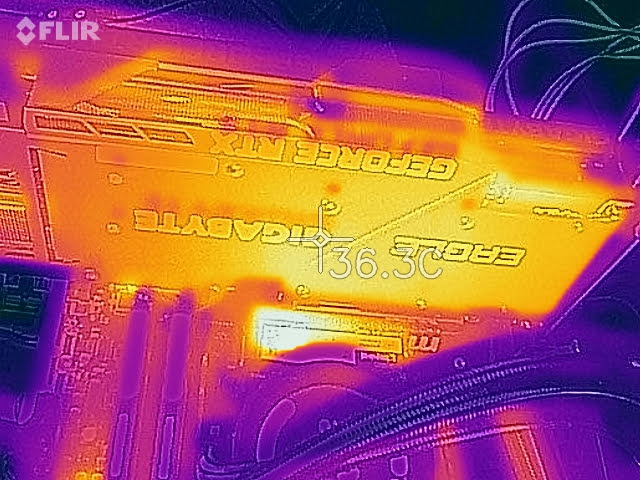
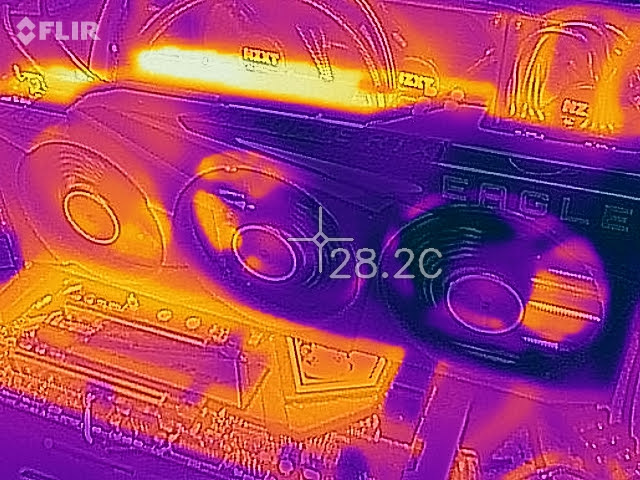
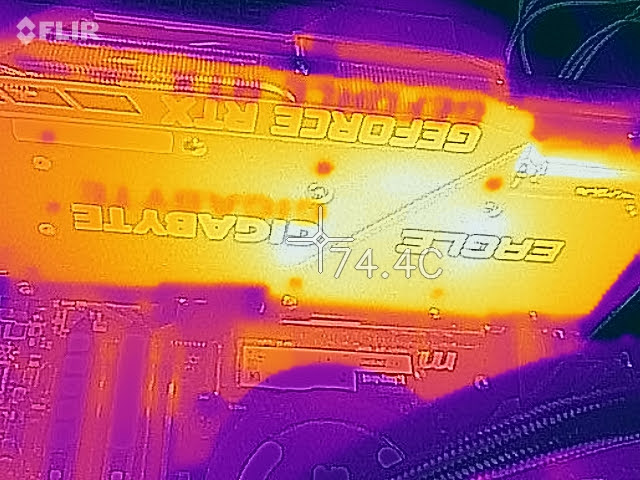
The Gigabyte RTX 3090 Eagle has a 350W TGP, the same as the 3090 Founders Edition. Here we actually put that to the test to see if the cards respect their power limits and how they behave with a couple of intense workloads. We use Powenetics in-line power monitoring hardware and software so that we can report the real power use of the graphics card. Powenetics also links up with GPU-Z to record GPU temperature, fan speed, and GPU clock speed.
You can read more about our approach to GPU power testing, but the takeaway is that we're not dependent on AMD, Nvidia or any other GPU vendor to accurately report how much power a GPU uses. We run FurMark as a worst-case stress test, and we also run five loops of the Metro Exodus benchmark at 1440p ultra (without ray tracing or DLSS) and record the results. These results are using the 456.55 drivers (the 456.71 drivers came out after we had completed testing).
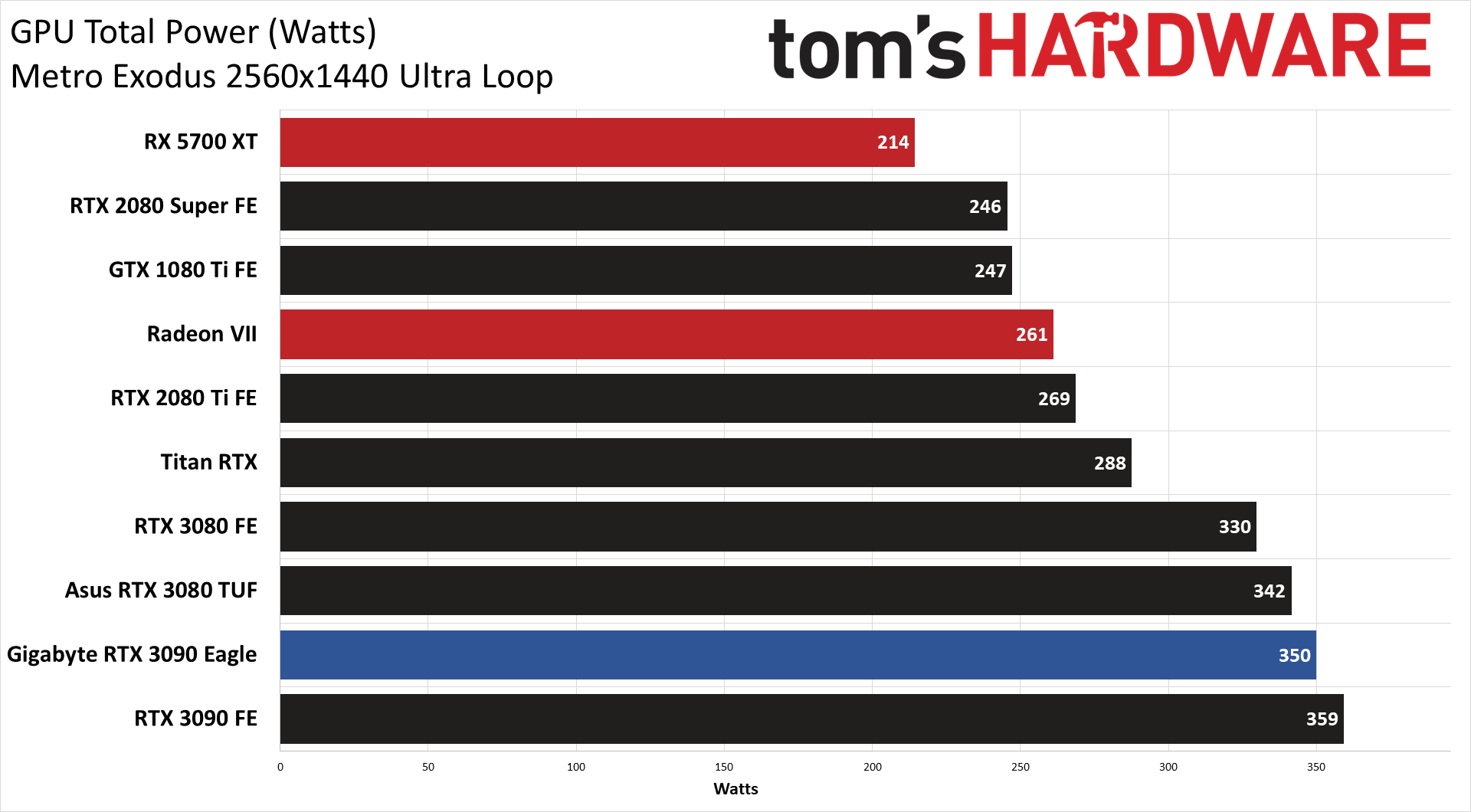
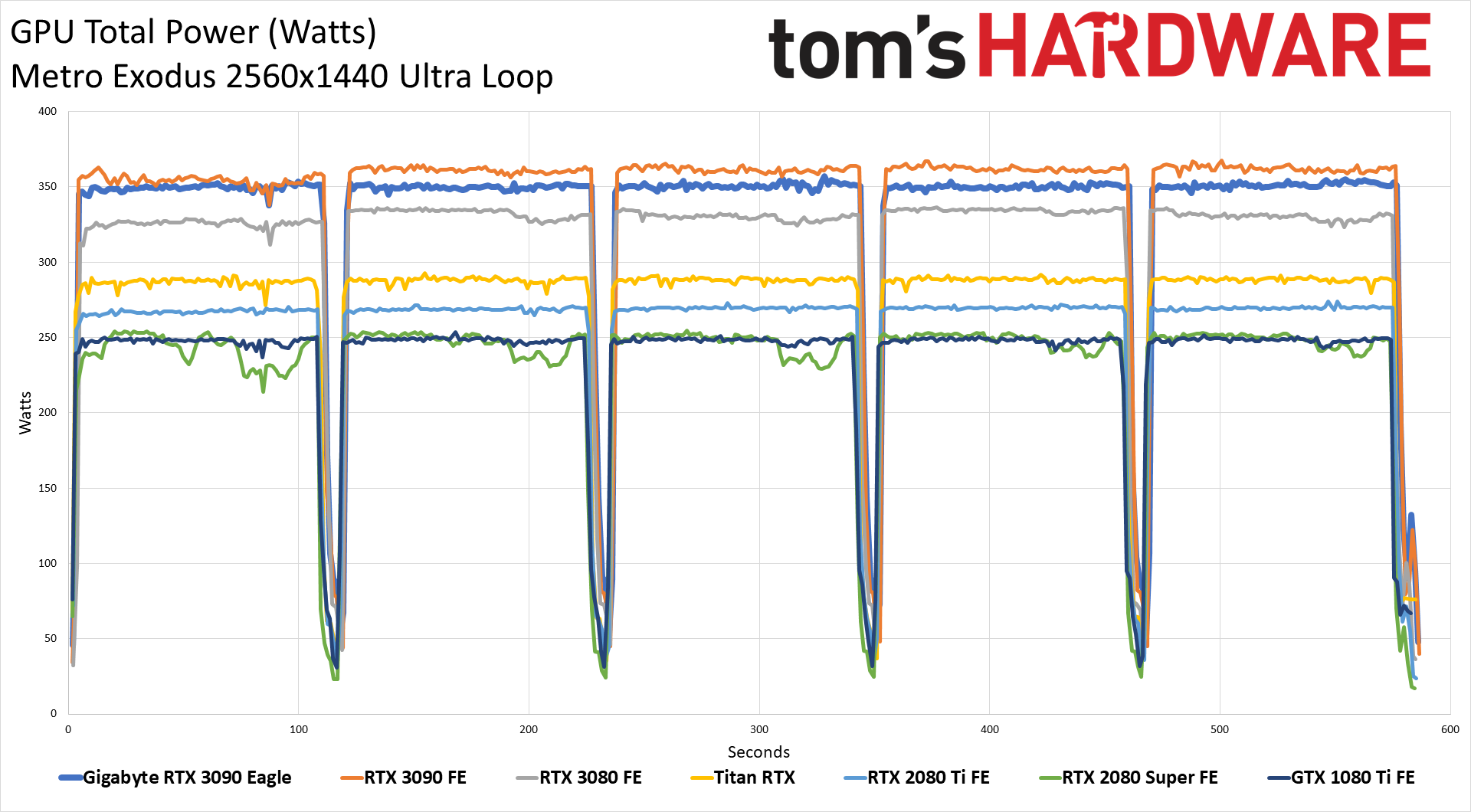
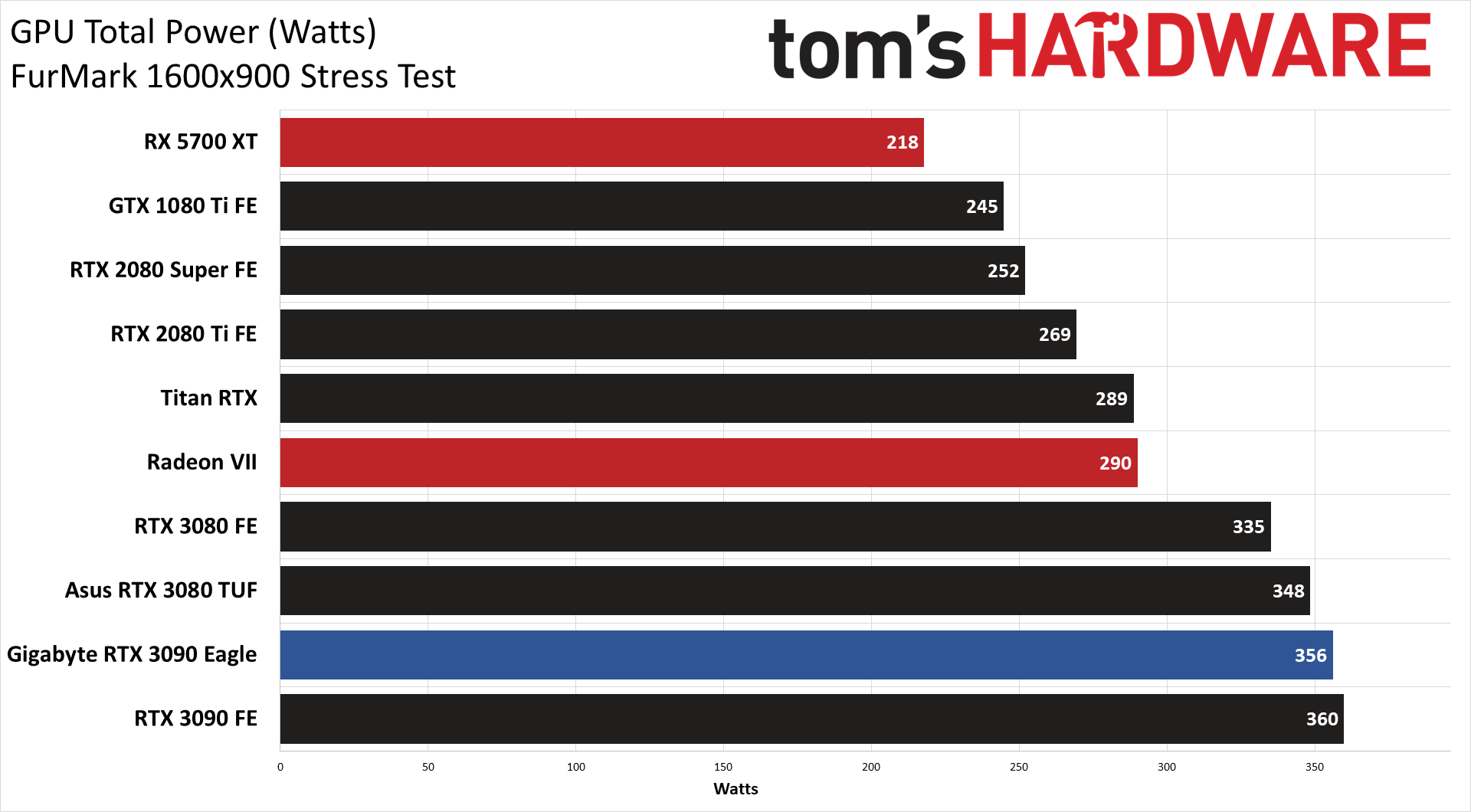
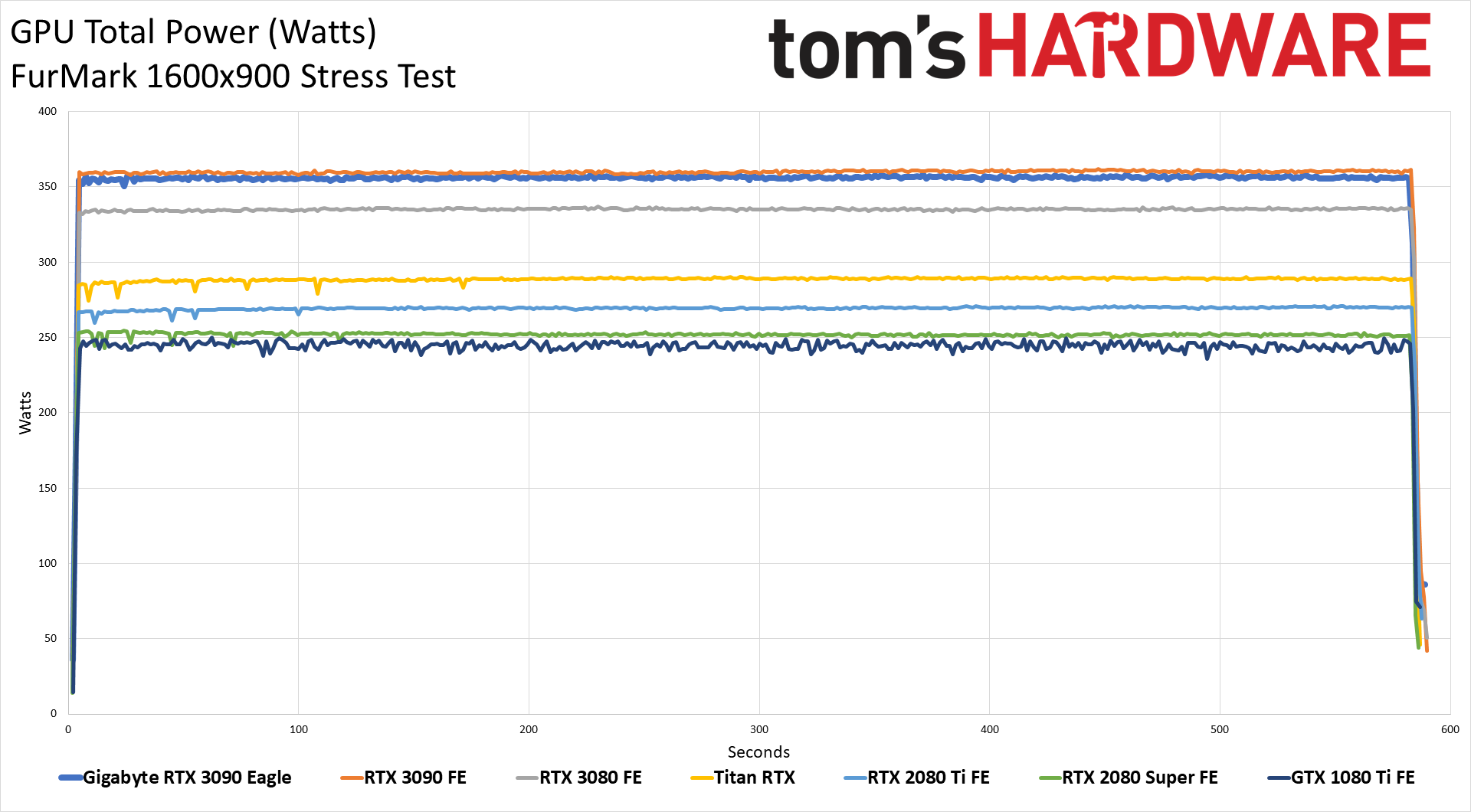
On average, the Gigabyte RTX 3090 Eagle uses 5-10W less power than the RTX 3090 FE. The gap is slightly larger in Metro Exodus and smaller in FurMark. Some of the other results are more interesting, though.
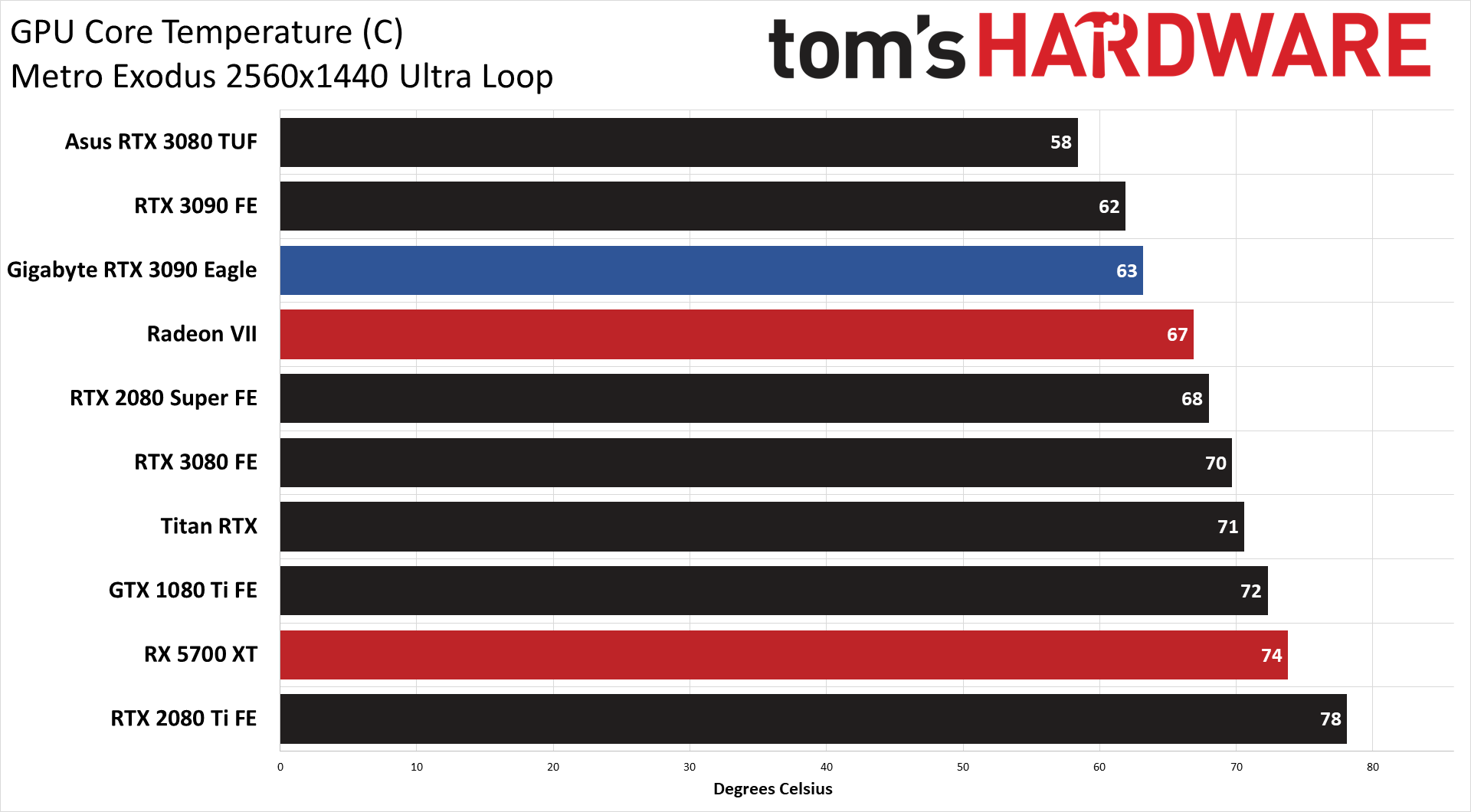
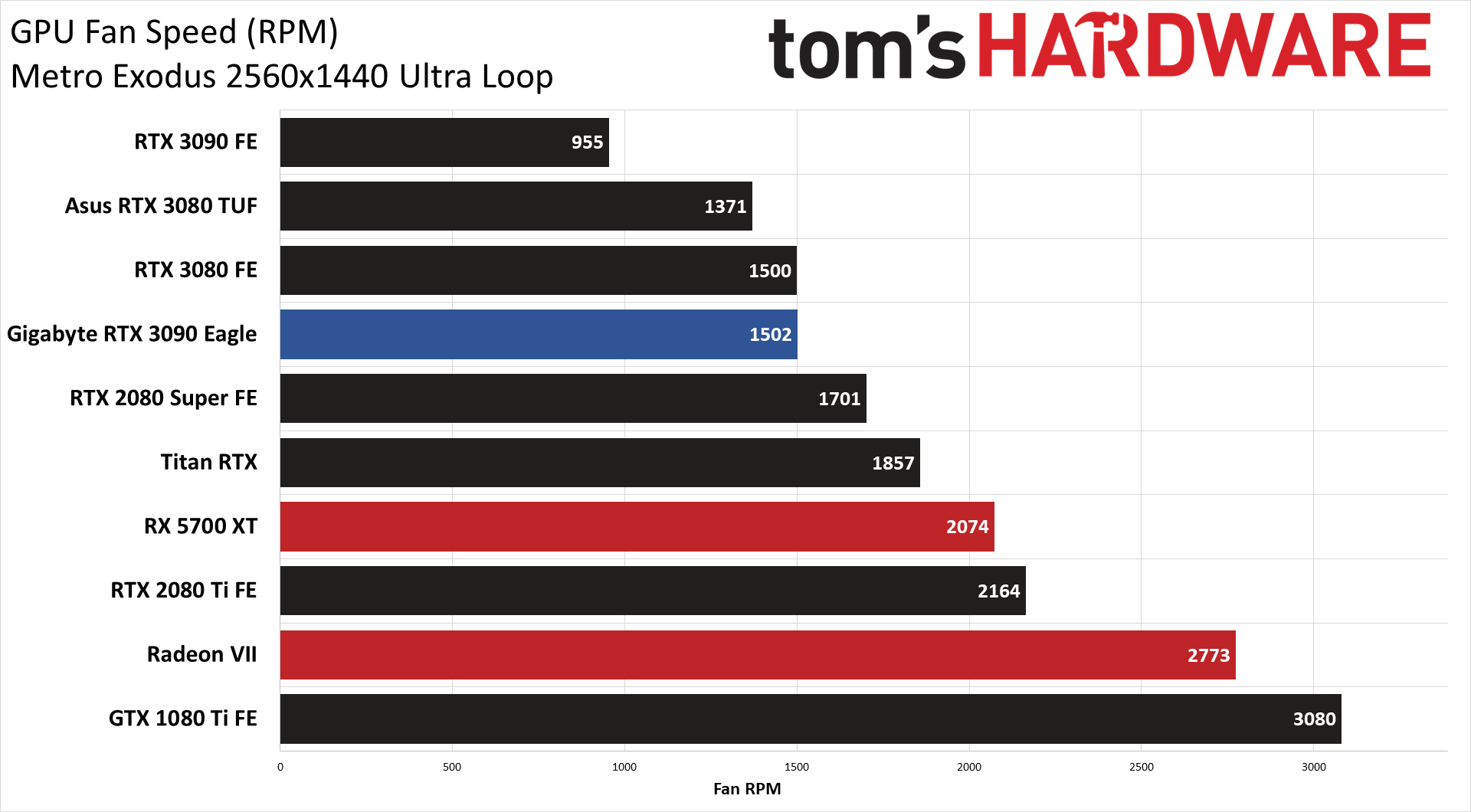
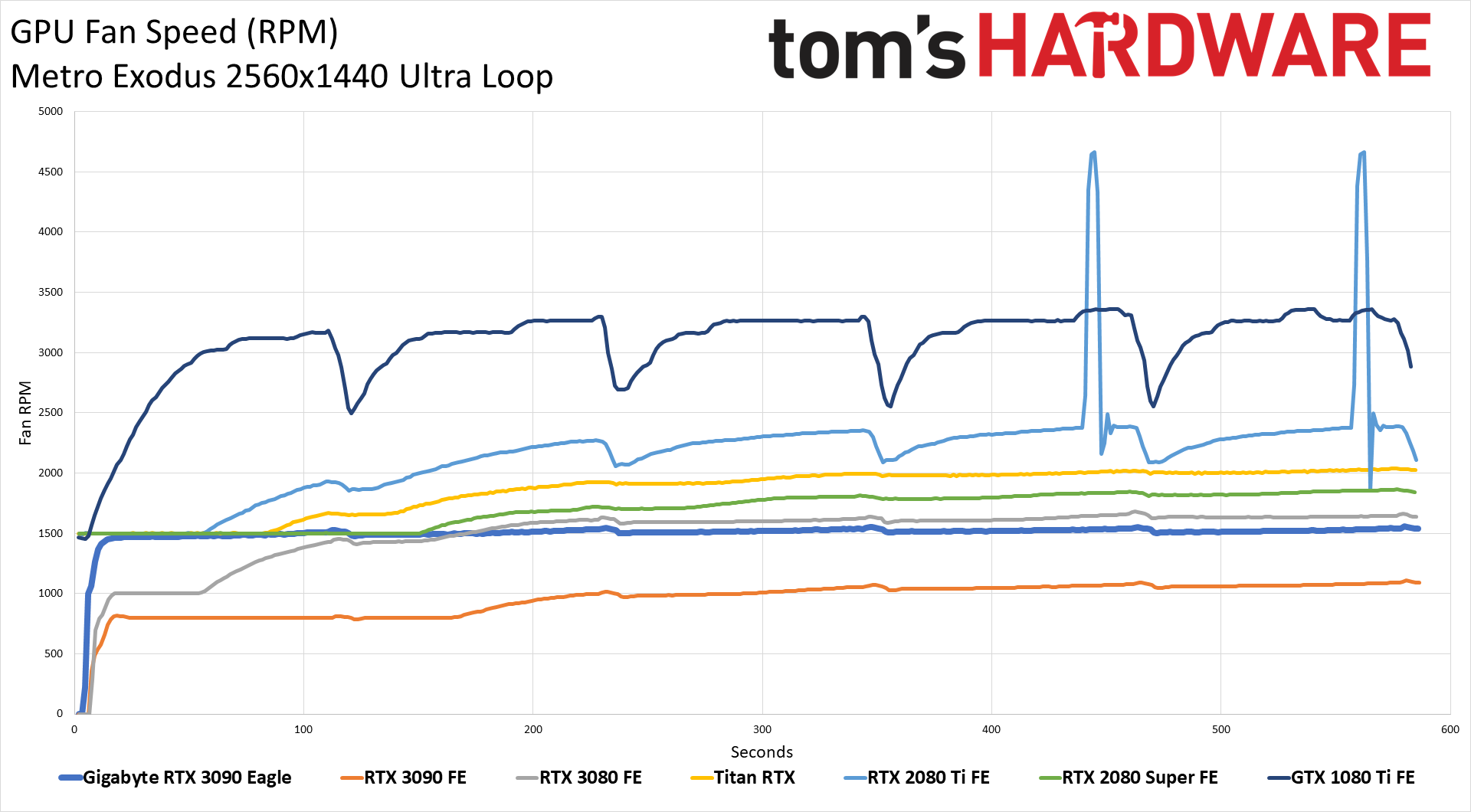
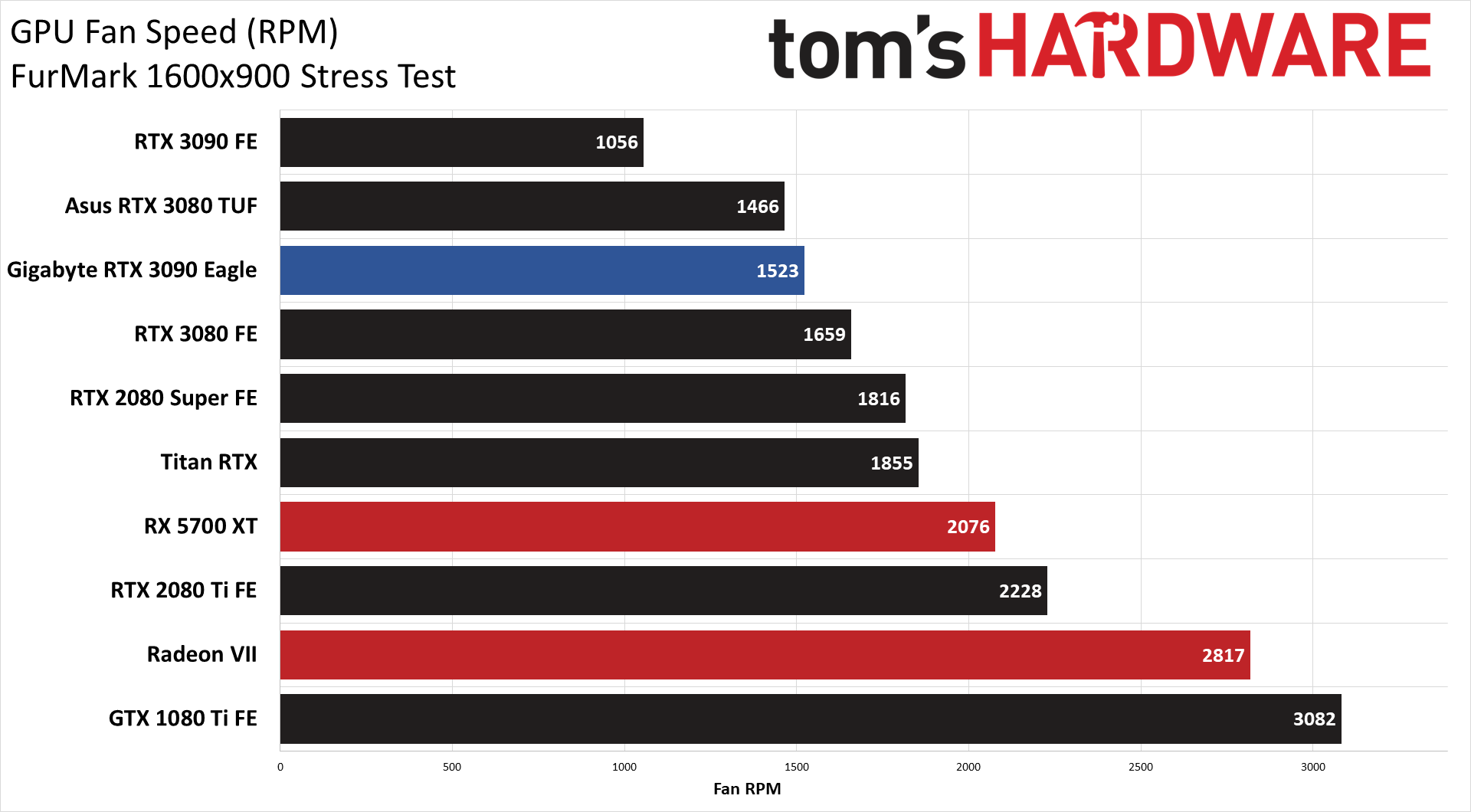
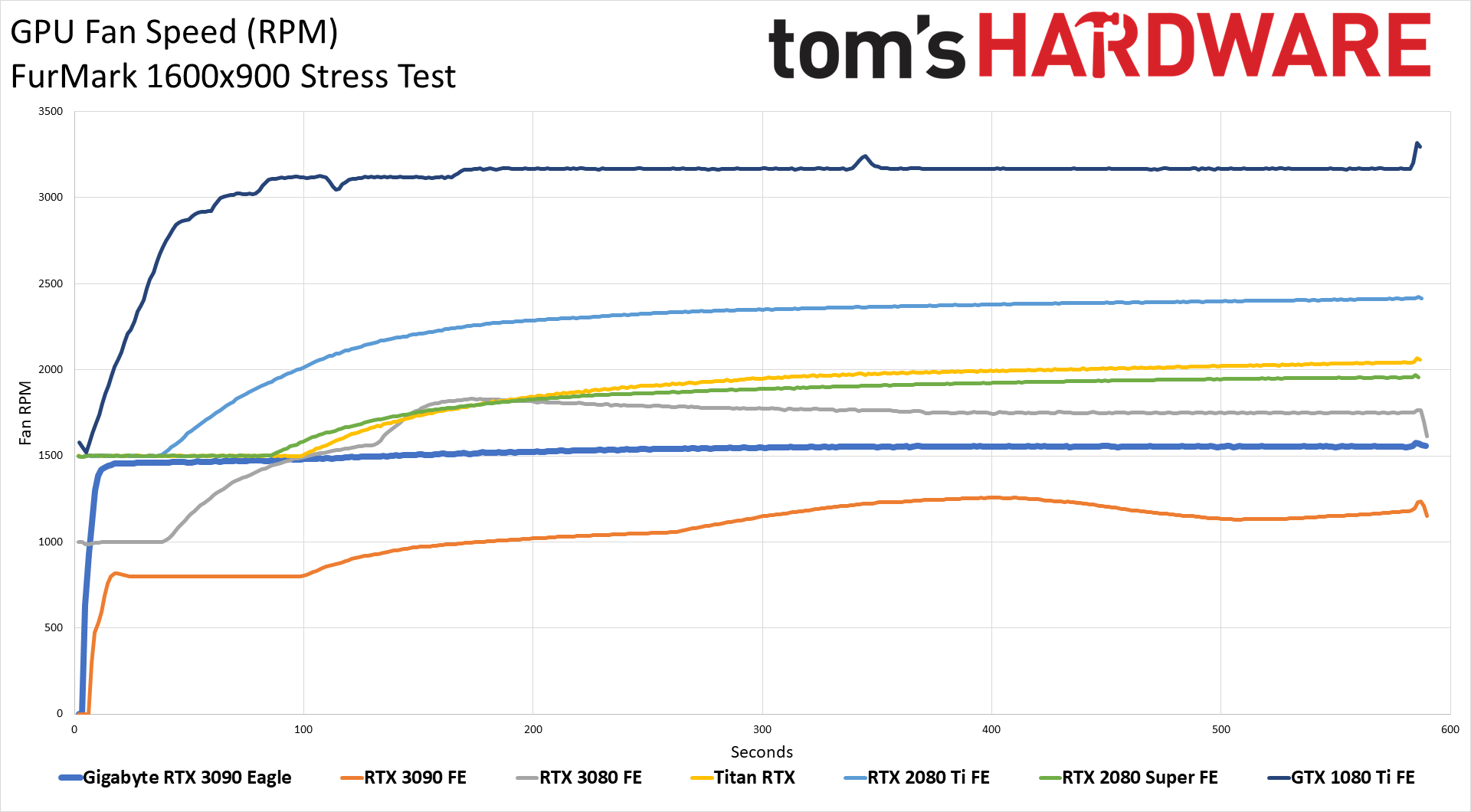
GPU core temperatures are basically tied with the 3090 FE — 1C higher in Metro Exodus and the same in FurMark. Fan speeds are higher than the FE, and the fans are quite different in terms of design and size, but the Gigabyte card clearly isn't having trouble keeping thermals in check. But then we get to the GPU clocks.
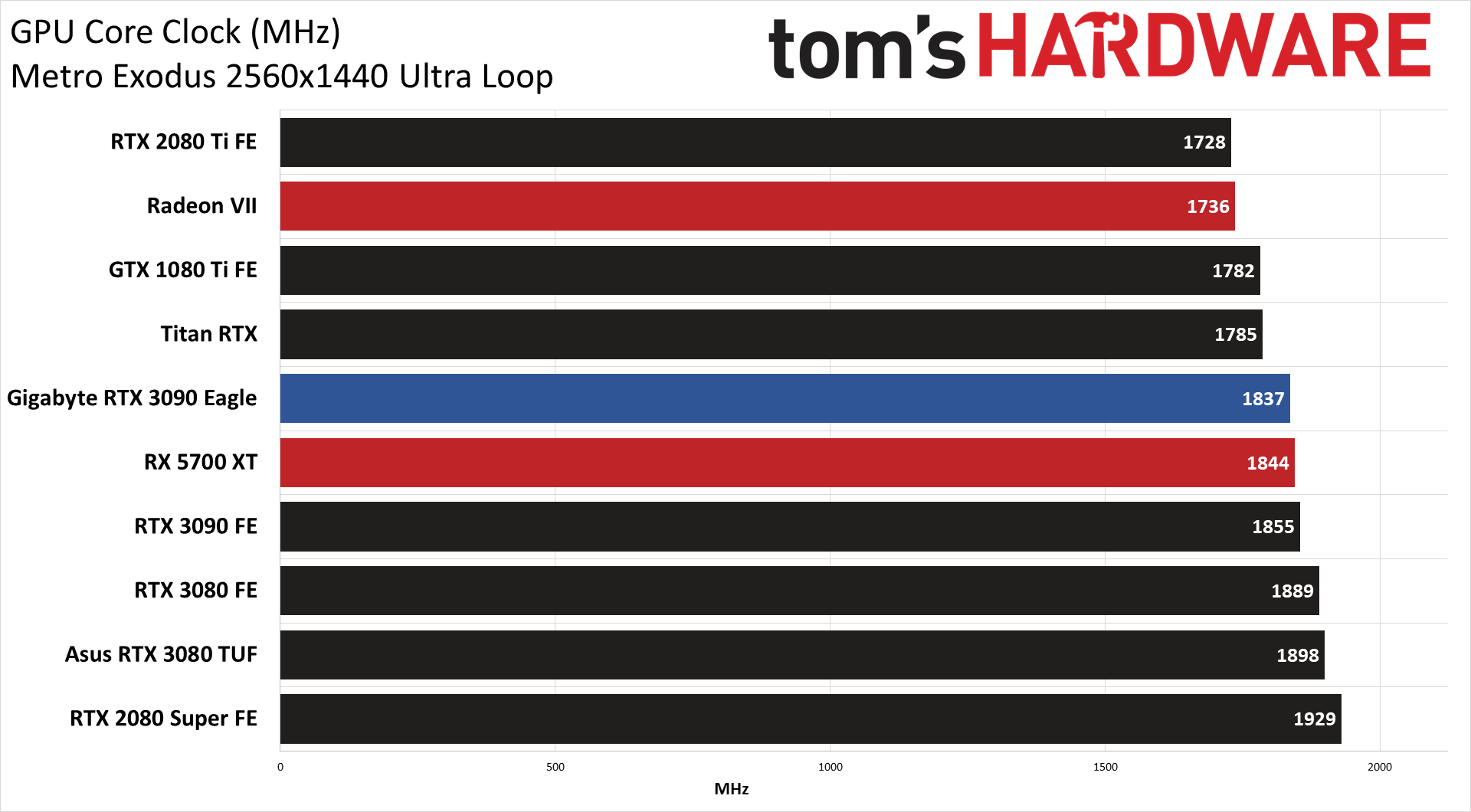
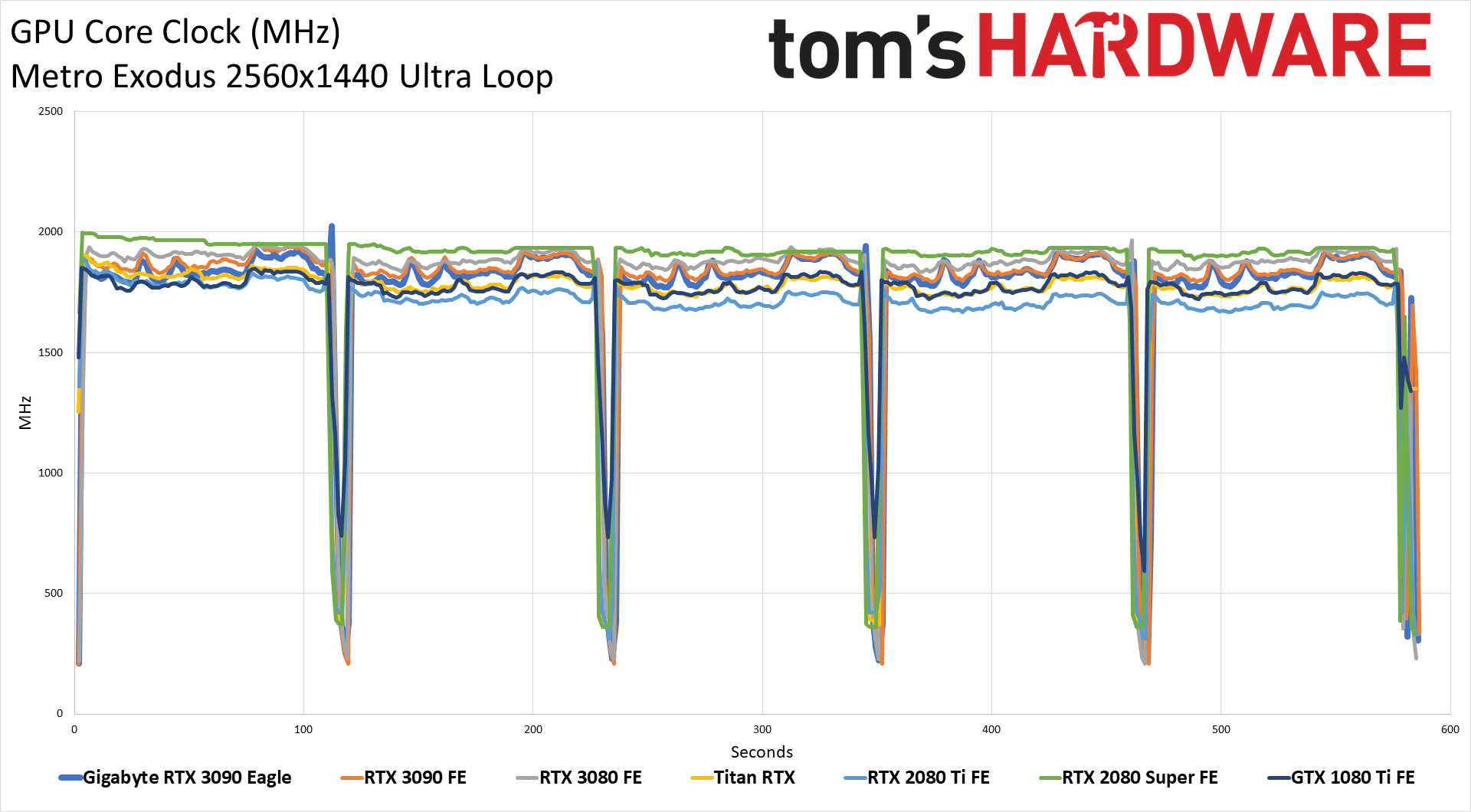
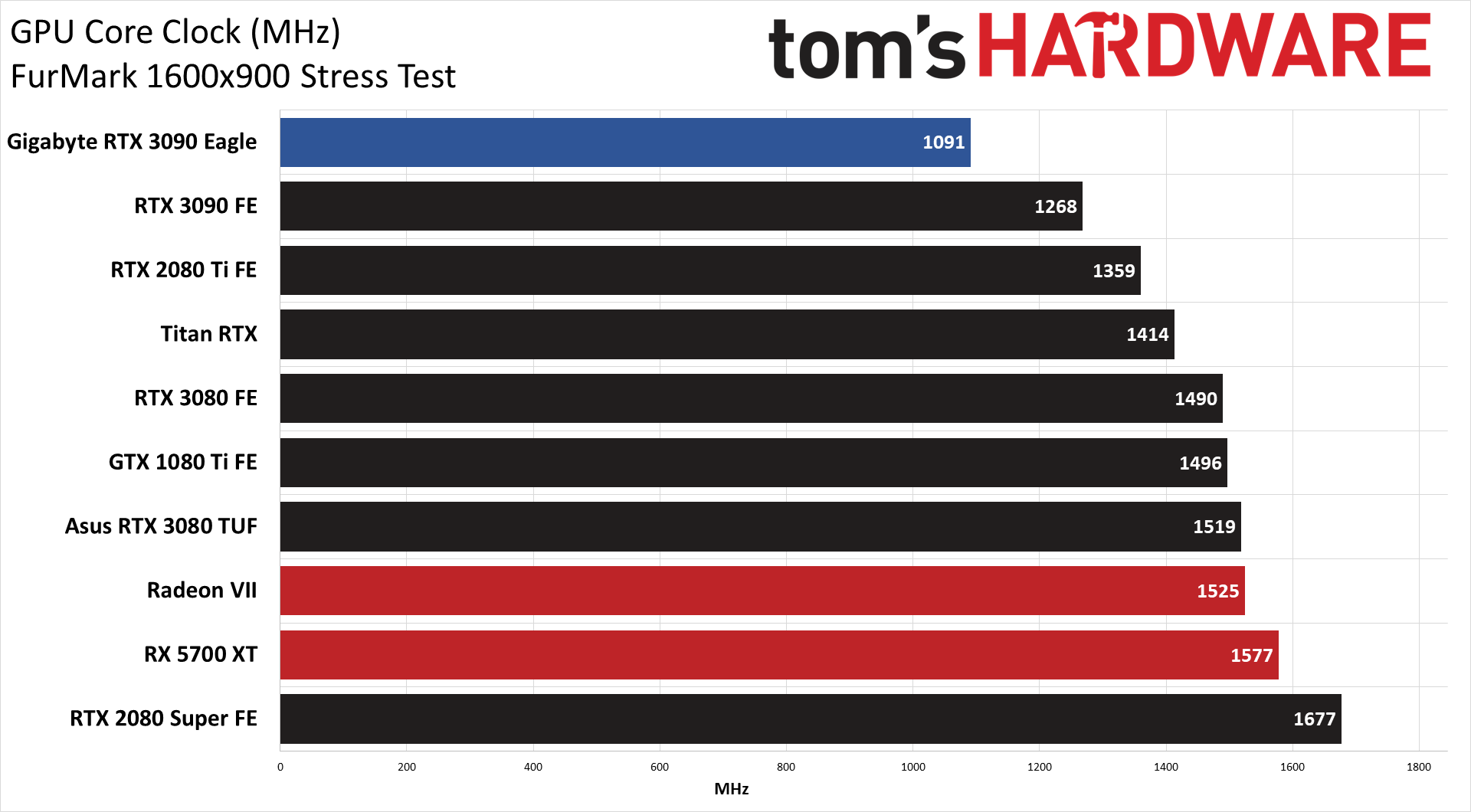
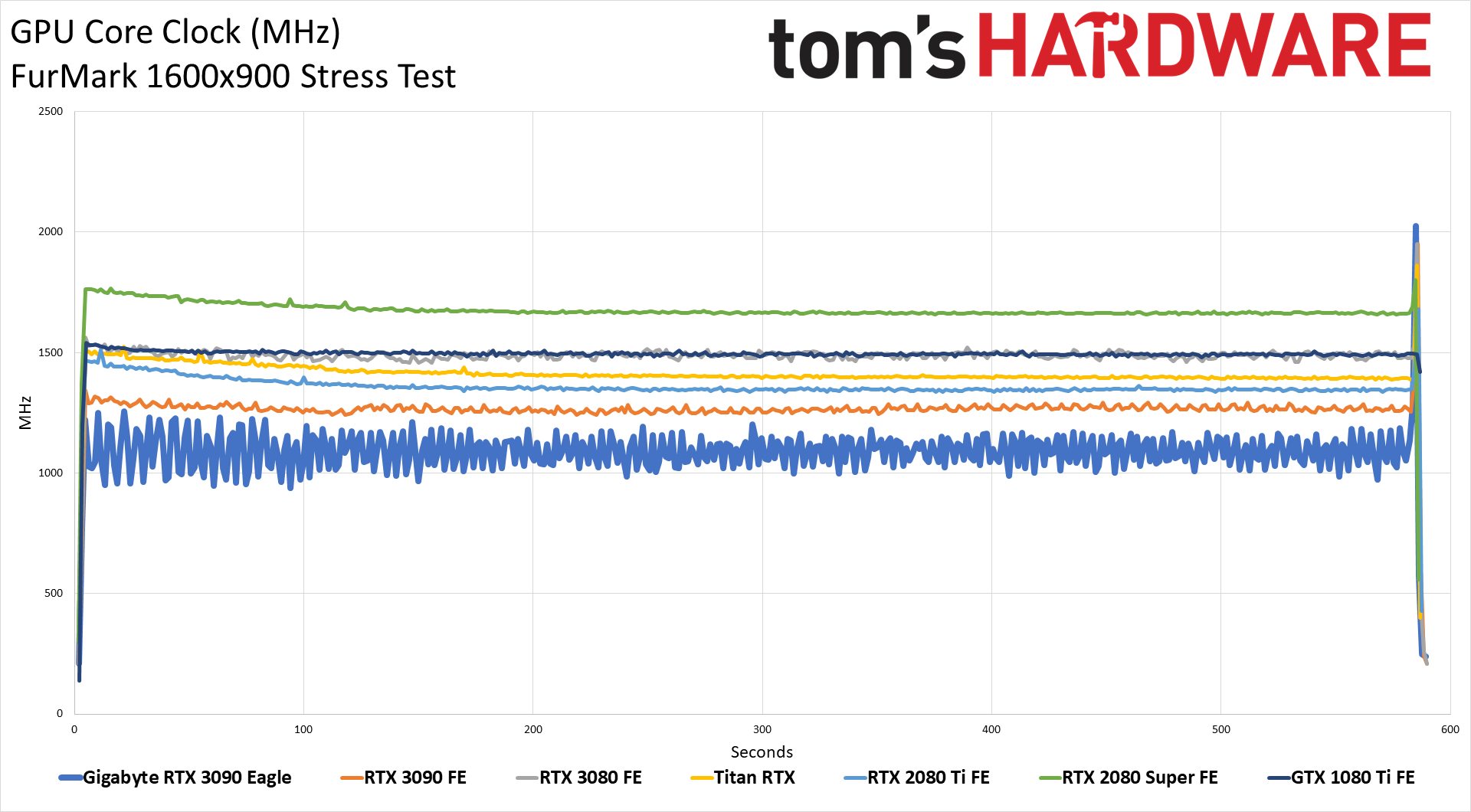
Clock speeds in Metro Exodus average 18MHz slower than the 3090 FE, which isn't a big deal, but it is interesting considering the Gigabyte Eagle is clocked 30MHz higher on its official boost clock. Basically, other factors (power limits likely being a big one) are coming into play. FurMark shows a very different result, however. Nearly all of the GPUs run below 'base' clocks in FurMark, as it's a particularly demanding workload. The Eagle averaged just 1091 MHz during the ten-minute run, bouncing between about 975 MHz and 1250 MHz throughout the test. The 3090 FE, by comparison, shows far fewer swings in clockspeed. We didn't see this sort of behavior in any of the games we tested, but Gigabyte does appear to take a very conservative approach to power in worst-case scenarios.
Noise Levels
We also used an SPL meter at a distance of 15cm to capture noise levels — the close proximity to the cards helps to mitigate any outside noise sources, plus our meter isn't accurate below 30 dB. The noise floor with the system sitting idle is 46 dB, as the case fans and CPU cooler are enabled. Under full load, after 15 minutes of testing, the Gigabyte card measured 50.0 dB. That might seem loud if you're only looking at the number, but from a sitting position, noise levels in my test environment drop to 34 dB at idle and 36 dB at load — in a very much not anechoic testing environment.
Gigabyte RTX 3090 Eagle: Reference 3090 Performance

If you're looking for the absolute fastest RTX 3090 graphics card possible, out of the box, the Gigabyte 3090 Eagle isn't that card. Practically speaking, most cards with higher factory overclocks are still in the 'coming soon' phase. The AIBs are binning and testing, and we expect such cards to start showing up this month. At which time they'll still sell out as fast as they're made. Nvidia's CEO recently said they expect demand for RTX 30-series cards will continue to be higher than supply into early 2021, so for the next few months, it's going to be difficult to buy any RTX 3090 it seems — and that's even at the $1,500 and higher Titan-level pricing.
If you're less concerned about aesthetics or higher factory overclocks, the Gigabyte 3090 Eagle is basically equivalent to a reference clocked 3090. It might be 1-2 percent faster in some cases, just like it's 1-2 percent slower than the 3090 FE in some tests, but it's not something you're likely to notice in normal use. It doesn't have a ton of lighting screaming for attention, and will happily run your games and applications just fine. But then, for the same nominal price, you can get the 3090 FE, which we think is a more attractive design. (It's also an excellent 2.2kg club.)
That's the battle Gigabyte and other AIBs face with 'entry-level' 3090 cards. The RTX 3090 FE is so good in terms of thermals and noise levels that it will be very difficult to top. The real question is how supply of any of the 3090 cards will evolve during the coming months. At $1,500, no one wants to feel like they're settling for a second-tier graphics card, and with limited supply, they might not even get that choice. There are potential long-term ramifications.
We're reminded of the RTX 2080 Ti, which had a launch price of $1,199 for the Founders Edition and a theoretical starting price of $999 for AIB cards. From what we saw, only a very small handful of $999 RTX 2080 Ti cards were ever sold — enough for Nvidia to say, "See, they exist!" In practice, all of the AIBs tended to go with higher-spec models and pricing of $1,100 or more. Given a choice between manufacturing a 3090 Eagle and selling it for $1,500, or selling an Aorus RTX 3090 Master for $1,700? Gigabyte would rather sell the Aorus Master. The same applies to the other AIBs: They're all going to want to ship higher-end SKUs rather than base model SKUs for the time being, at least until supplies of 3090 GPUs start to match the demand.
Ultimately, the Gigabyte RTX 3090 Eagle is a fine card for the professional market. It's just not clearly better (or even equal to) the 3090 Founders Edition. Out of the box, performance is nearly equal to the 3090 FE, but on paper, it should have been faster. Really, though, most gamers should forget about the RTX 3090 and instead try to pick up a GeForce RTX 3080 — or wait for the GeForce RTX 3070 to arrive in late October, or for AMD's RX 6000 competition in November. Let's just hope supply on those last two ends up better than what we've seen from the 3080 and 3090 so far.

Jarred Walton is a senior editor at Tom's Hardware focusing on everything GPU. He has been working as a tech journalist since 2004, writing for AnandTech, Maximum PC, and PC Gamer. From the first S3 Virge '3D decelerators' to today's GPUs, Jarred keeps up with all the latest graphics trends and is the one to ask about game performance.